Paul van Yperen's Blog, page 75
September 7, 2023
Liza Minnelli
American actress and singer Liza Minnelli (1946) became world famous for her impersonation of Sally Bowles in the film musical Cabaret (1972). She won an Oscar for her role, but during her long career, she also won an Emmy, a Grammy, a Golden Globe and several Tony awards. Through the years, she became a versatile interpreter of songs from the Great American Songbook. Songs by John Kander and Fred Ebb in particular formed the basis for some of her concert programmes and Minnelli starred in several of this duo's stage musicals, including 'Flora the Red Menace' (1965) and 'The Act' (1977/1978). Liza is the daughter of film legend Judy Garland and director Vincente Minnelli.
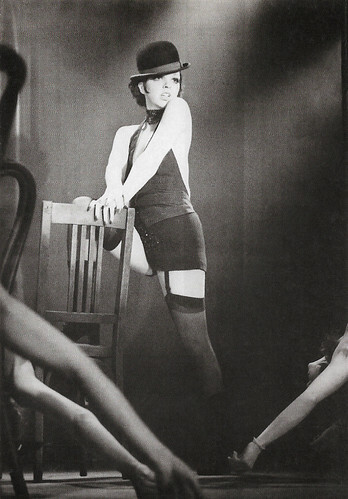
French postcard in the Collection Cinéma by Editions Art & Scene, Paris, no. CA 100. Liza Minelli in Cabaret (Bob Fosse, 1972).
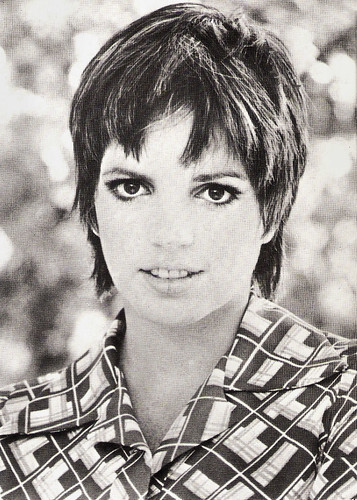
French postcard by Travelling Editions, Paris, no. CP 99.
A stylised survivor
Liza May Minnelli was born in 1946 in Los Angeles, California. She was the daughter of Judy Garland and film director Vincente Minnelli. Her parents named her after Ira Gershwin's song 'Liza (All the Clouds Will Roll Away)'. She was practically raised at MGM studios while her parents worked long hours there and she made her film debut at fourteen months of age in the musical In the Good Old Summertime (Robert Z. Leonard, 1949).
Her parents divorced in 1951 when Liza was only 5 years old. In 1952, her mother married Sidney Luft and in the following years, sister Lorna Luft and brother Joey Luft were born. Her father, Vincente Minnelli, later married Georgette Magnani, mother of her half-sister Christiane Nina "Tina Nina" Minnelli.
Because Liza constantly travelled with her mother, she spent most of her childhood in hotels. She was the inspiration for the character Eloise, who grew up in the Plaza Hotel. The Eloise books were written by Liza's godmother, Kay Thompson.
At sixteen, Liza was on her own in New York City, struggling to begin her career in show business. Her first recognition came for the play 'Best Foot Forward' which ran for seven months in 1963. A year later, Judy invited 18-year-old Liza to appear with her for a show at the London Palladium. This show sold out immediately and a second night was added to it. Liza's performance in London was a huge turning point in both her career and her relationship with her mother. The audience absolutely loved Liza and Judy realised that Liza was now an adult with her own career.
It was at the Palladium that Liza met her first husband, Peter Allen, a friend of Judy's. Liza won a Tony award at age nineteen for 'Flora, the Red Menace' (1965). It marked the start of her lifelong collaboration with John Kander and Fred Ebb. They wrote, produced or directed many of Minnelli's future stage acts and television series and helped create her stage persona of a stylised survivor, and her anthems 'New York, New York', 'Cabaret', and 'Maybe This Time' This contributed to Minnelli's status as an enduring gay icon.
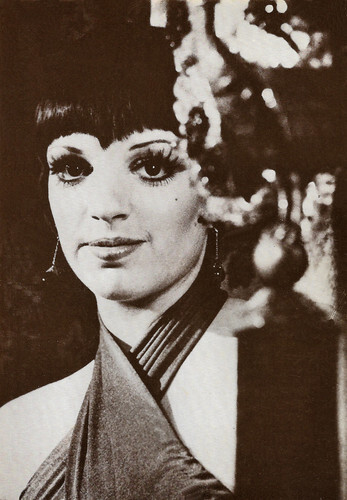
French postcard by Delta-Productions, Saint Jean-De-Vedas, no. CP-218. Caption: Elsa Minelli (sic).
The trendiest disco club in the world
Liza Minnelli was nominated for her first Academy Award at age twenty-three for the acclaimed role of Pookie Adams in The Sterile Cuckoo (Alan J. Pakula, 1969). Other dramatic roles followed and, in 1972, she won an Oscar for her role as Sally Bowles in the musical Cabaret (Bob Fosse, 1972).
The seventies were a busy time for Liza. She worked steadily in film, stage and music. Memorable films were her father's A Matter of Time (Vincente Minnelli, 1976) with Ingrid Bergman and New York, New York (Martin Scorsese, 1977) with Robert De Niro . The title song 'Theme from New York, New York', first sung by Minnelli, would become a big hit in Frank Sinatra 's performance. Scorsese directed her again in 1977 in the Broadway musical 'The Act', for which she would receive her third Tony Award.
She started focusing on stage performances and her singing career in later years. She often performed with Frank Sinatra and Sammy Davis Jr. At the time, she and her good friend Halston were regulars at Studio 54, the trendiest disco club in the world. She suffered three miscarriages during her third marriage to sculptor Mark Gero. The first occurred just a week after their wedding in December 1979.
In the 1980s, she suffered from drug addictions and poor health. As a result, she had to undergo several operations, including on her hips and knees and spent time in rehab. Minnelli did not establish herself as a leading film star. Later films such as the thriller Rent-a-Cop (Jerry London, 1987) with Burt Reynolds and the musical comedy Stepping Out (Lewis Gilbert, 1991) with Julie Walters and Shelley Winters were not successful.
Only the comedy Arthur (Steve Gordon, 1981) with Dudley Moore was a huge box-office hit. Minnelli married four times, to singer Peter Allen (1967-1974), film producer Jack Haley Jr. (1974-1979), sculptor Mark Gero (1979-1992) and concert promoter David Gest (2002-2003).
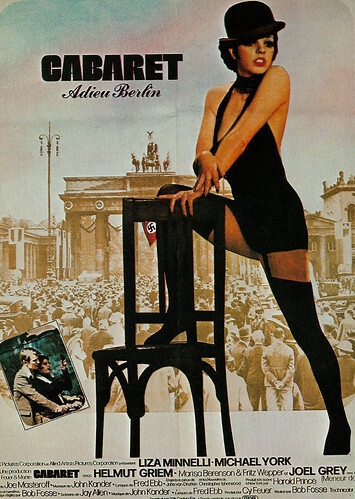
French postcard by Editions F. Nugeron, no. E 86. French affiche with Liza Minelli in Cabaret (Bob Fosse, 1972).
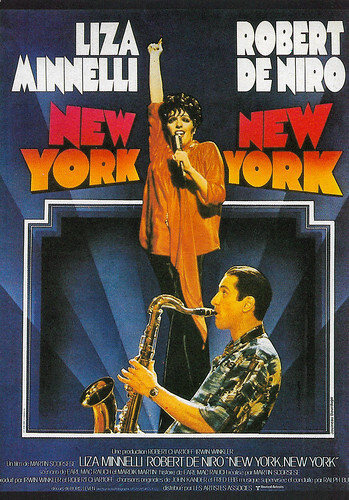
French postcard by Editions F. Nugeron, no. E 434. Image: French poster of New York, New York (Martin Scorsese, 1977) starring Liza Minnelli and Robert De Niro.
A large following of immensely loyal fans
Over the past decades, Liza Minnelli's career has leaned more towards stage performances and she has a long list of musical albums which she continues to add to. She teamed with Frank Sinatra in his 'Duets' CD and Sammy Davis Jr. joined them for a series of concerts and TV shows which were extremely well-received.
Liza had to deal with tabloid stories of drug abuse and ill health and had a number of high-profile stays at drug rehabilitation clinics. Her hectic schedule slowed down in recent years, but she still has a large following of immensely loyal fans who continue to cheer her on.
In 1990. Liza Minnelli received the Grammy Legend Award. It made her one of the few artists who have won American entertainment's top four awards - the Oscar, the Tony, the Emmy and the Grammy. She won the Tony twice, for 'Flora, the Red Menace' (1965) and 'The Act' (1977); an Oscar for Best Actress for Cabaret (1972); and an Emmy in 1973 for Liza with a Z (1972).
In 1974, she also won a Special Tony Award "for adding lustre to the Broadway theatre season". In 2009, she was again awarded the Tony Award for her show, 'Liza's at the Palace' for Special Theatrical Presentation at the Palace Theatre in New York City.
She was also nominated as Best Actress (Musical) in 1984 for 'The Rink', but lost that award to her co-star, Chita Rivera. Last but not least, Minnelli is a Knight of the French Legion of Honour.
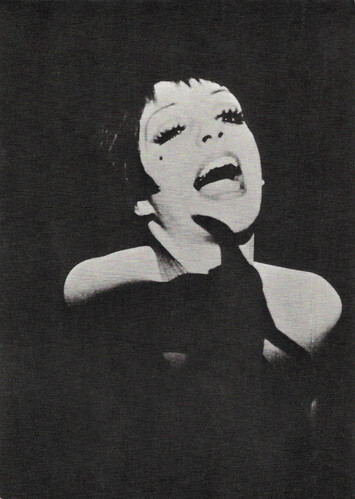
French postcard by Travelling Editions, Paris, no. CP 32.
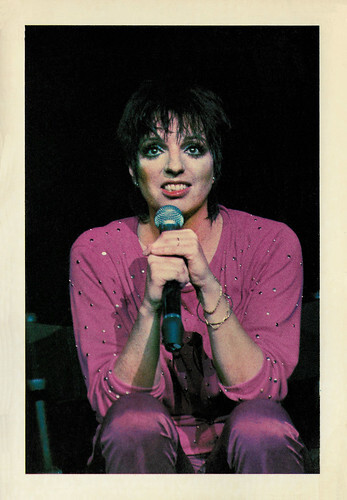
Italian postcard by Grafiche Corsini, Firenze, no. C 11. Photo: Riccardo Bettini.
Sources: (IMDb), Wikipedia (Dutch, German and English) and .

French postcard in the Collection Cinéma by Editions Art & Scene, Paris, no. CA 100. Liza Minelli in Cabaret (Bob Fosse, 1972).

French postcard by Travelling Editions, Paris, no. CP 99.
A stylised survivor
Liza May Minnelli was born in 1946 in Los Angeles, California. She was the daughter of Judy Garland and film director Vincente Minnelli. Her parents named her after Ira Gershwin's song 'Liza (All the Clouds Will Roll Away)'. She was practically raised at MGM studios while her parents worked long hours there and she made her film debut at fourteen months of age in the musical In the Good Old Summertime (Robert Z. Leonard, 1949).
Her parents divorced in 1951 when Liza was only 5 years old. In 1952, her mother married Sidney Luft and in the following years, sister Lorna Luft and brother Joey Luft were born. Her father, Vincente Minnelli, later married Georgette Magnani, mother of her half-sister Christiane Nina "Tina Nina" Minnelli.
Because Liza constantly travelled with her mother, she spent most of her childhood in hotels. She was the inspiration for the character Eloise, who grew up in the Plaza Hotel. The Eloise books were written by Liza's godmother, Kay Thompson.
At sixteen, Liza was on her own in New York City, struggling to begin her career in show business. Her first recognition came for the play 'Best Foot Forward' which ran for seven months in 1963. A year later, Judy invited 18-year-old Liza to appear with her for a show at the London Palladium. This show sold out immediately and a second night was added to it. Liza's performance in London was a huge turning point in both her career and her relationship with her mother. The audience absolutely loved Liza and Judy realised that Liza was now an adult with her own career.
It was at the Palladium that Liza met her first husband, Peter Allen, a friend of Judy's. Liza won a Tony award at age nineteen for 'Flora, the Red Menace' (1965). It marked the start of her lifelong collaboration with John Kander and Fred Ebb. They wrote, produced or directed many of Minnelli's future stage acts and television series and helped create her stage persona of a stylised survivor, and her anthems 'New York, New York', 'Cabaret', and 'Maybe This Time' This contributed to Minnelli's status as an enduring gay icon.

French postcard by Delta-Productions, Saint Jean-De-Vedas, no. CP-218. Caption: Elsa Minelli (sic).
The trendiest disco club in the world
Liza Minnelli was nominated for her first Academy Award at age twenty-three for the acclaimed role of Pookie Adams in The Sterile Cuckoo (Alan J. Pakula, 1969). Other dramatic roles followed and, in 1972, she won an Oscar for her role as Sally Bowles in the musical Cabaret (Bob Fosse, 1972).
The seventies were a busy time for Liza. She worked steadily in film, stage and music. Memorable films were her father's A Matter of Time (Vincente Minnelli, 1976) with Ingrid Bergman and New York, New York (Martin Scorsese, 1977) with Robert De Niro . The title song 'Theme from New York, New York', first sung by Minnelli, would become a big hit in Frank Sinatra 's performance. Scorsese directed her again in 1977 in the Broadway musical 'The Act', for which she would receive her third Tony Award.
She started focusing on stage performances and her singing career in later years. She often performed with Frank Sinatra and Sammy Davis Jr. At the time, she and her good friend Halston were regulars at Studio 54, the trendiest disco club in the world. She suffered three miscarriages during her third marriage to sculptor Mark Gero. The first occurred just a week after their wedding in December 1979.
In the 1980s, she suffered from drug addictions and poor health. As a result, she had to undergo several operations, including on her hips and knees and spent time in rehab. Minnelli did not establish herself as a leading film star. Later films such as the thriller Rent-a-Cop (Jerry London, 1987) with Burt Reynolds and the musical comedy Stepping Out (Lewis Gilbert, 1991) with Julie Walters and Shelley Winters were not successful.
Only the comedy Arthur (Steve Gordon, 1981) with Dudley Moore was a huge box-office hit. Minnelli married four times, to singer Peter Allen (1967-1974), film producer Jack Haley Jr. (1974-1979), sculptor Mark Gero (1979-1992) and concert promoter David Gest (2002-2003).

French postcard by Editions F. Nugeron, no. E 86. French affiche with Liza Minelli in Cabaret (Bob Fosse, 1972).

French postcard by Editions F. Nugeron, no. E 434. Image: French poster of New York, New York (Martin Scorsese, 1977) starring Liza Minnelli and Robert De Niro.
A large following of immensely loyal fans
Over the past decades, Liza Minnelli's career has leaned more towards stage performances and she has a long list of musical albums which she continues to add to. She teamed with Frank Sinatra in his 'Duets' CD and Sammy Davis Jr. joined them for a series of concerts and TV shows which were extremely well-received.
Liza had to deal with tabloid stories of drug abuse and ill health and had a number of high-profile stays at drug rehabilitation clinics. Her hectic schedule slowed down in recent years, but she still has a large following of immensely loyal fans who continue to cheer her on.
In 1990. Liza Minnelli received the Grammy Legend Award. It made her one of the few artists who have won American entertainment's top four awards - the Oscar, the Tony, the Emmy and the Grammy. She won the Tony twice, for 'Flora, the Red Menace' (1965) and 'The Act' (1977); an Oscar for Best Actress for Cabaret (1972); and an Emmy in 1973 for Liza with a Z (1972).
In 1974, she also won a Special Tony Award "for adding lustre to the Broadway theatre season". In 2009, she was again awarded the Tony Award for her show, 'Liza's at the Palace' for Special Theatrical Presentation at the Palace Theatre in New York City.
She was also nominated as Best Actress (Musical) in 1984 for 'The Rink', but lost that award to her co-star, Chita Rivera. Last but not least, Minnelli is a Knight of the French Legion of Honour.

French postcard by Travelling Editions, Paris, no. CP 32.

Italian postcard by Grafiche Corsini, Firenze, no. C 11. Photo: Riccardo Bettini.
Sources: (IMDb), Wikipedia (Dutch, German and English) and .
Published on September 07, 2023 22:00
September 6, 2023
Barry Norton
Barry Norton (1905-1956) was a boyishly handsome Argentine-born actor, who had a career in the United States. In Hollywood, he acted in over 90 films by F.W. Murnau and others. He started in silent films in 1925 and is perhaps best known for his role as Juan Harker in Universal Pictures' Spanish-language version of Drácula (1931), the English-language role of Jonathan Harker originated by David Manners.
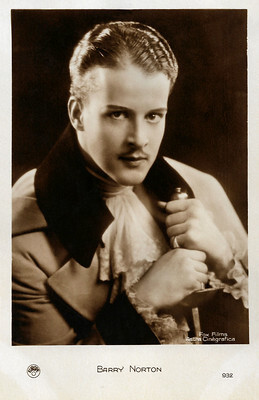
French postcard by Europe, no. 4932. Photo: Fox Films / Astra Cinégrafica.

Italian postcard by G.B. Falci Editore, Milano, no. 711 Photo: Charles Munn Autrey / Fox. Charles Morton, Janet Gaynor, Nancy Drexel, and Barry Norton in 4 Devils (Friedrich Wilhelm Murnau, 1928). 4 Devils is one of the most famous 'lost' films.
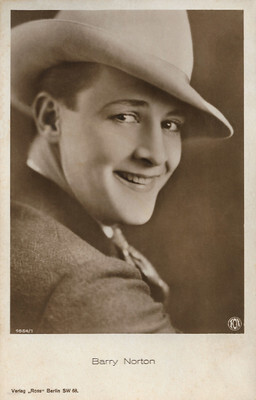
German postcard by Ross Verlag, no. 1854/1, 1927-1928. Photo: Fox.
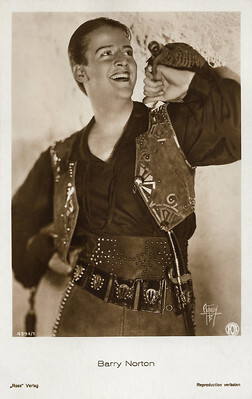
German postcard by Ross Verlag, no. 4394/1, 1929-1930. Photo: Max Munn Autrey / Fox.
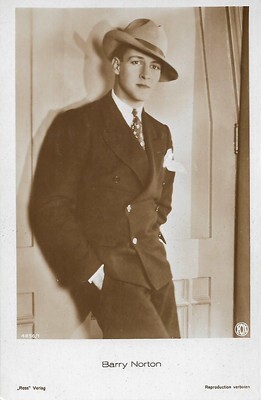
German postcard by Ross Verlag, no. 4856/1, 1929-1930. Photo: Fox.
There's a boy that is a 'natural'
Barry Norton was born Alfredo Carlos Birabén in 1905 in Buenos Aires, Argentina. He was the scion of a wealthy Argentine family. In 1923, Norton emigrated to the United States as a second cabin class passenger under the name of Carlos Manuel A. Biraben on the S/S Vestris, which had sailed from Buenos Aires, on 12 March, and arrived at the Port of New York on 1 April 1923.
Years later, he became a naturalised United States citizen. He was a talented ballroom dancer. After stops in New York City and Chicago, he finally came to Hollywood, where he first worked as an office assistant for Douglas Fairbanks .
On-screen, Norton first appeared as an extra in Fairbanks' silent action-adventure film The Black Pirate (Albert Parker, 1926). The boyish-looking actor signed a contract with the Fox Film Corporation and was soon cast in The Lily (Victor Schertzinger, 1926) with Belle Bennett.
His big break came when he was given the role of Pvt. "Mother's Boy" Lewisohn in the silent comedy-drama war film What Price Glory? (Raoul Walsh, 1926) which turned out to be a huge commercial success. Another success was Sunrise: A Song of Two Humans (F.W. Murnau, 1927) starring George O'Brien, Janet Gaynor , and Margaret Livingston . Norton only appeared in a bit role but he landed a substantial role in Friedrich Wilhelm Murnau 's 4 Devils (F.W. Murnau, 1928) opposite Janet Gaynor and Charles Morton .
Norton then landed a leading role as Emil Jannings ' son in the drama Sins of the Fathers (Ludwig Berger, 1928). He also played a leading role opposite Gary Cooper and Fay Wray in Legion of the Condemned (William Wellman, 1928) which was also very successful. His acting was well-received by audiences and critics at the time, and, during the silent era, he avoided being typecast as a Latin lover. One theatre owner in Golden City, Montana, said, "[Norton] has as yet to show me a bad performance. There's a boy that is a 'natural'."

Italian postcard by G.B. Falci Editore, Milano, no. 708. Photo: Max Munn Autrey / Fox. Janet Gaynor , Nancy Drexel, Barry Norton and Charles Morton in 4 Devils (Friedrich Wilhelm Murnau, 1928). 4 Devils is one of the most famous 'lost' films.
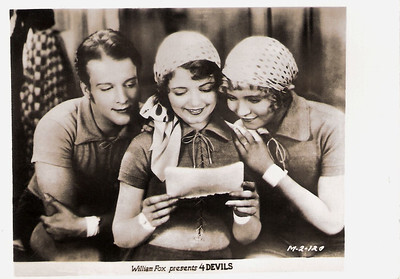
Dutch postcard. Photo: Fox. Barry Norton, Janet Gaynor and Nancy Drexel in 4 Devils (F.W. Murnau, 1928).
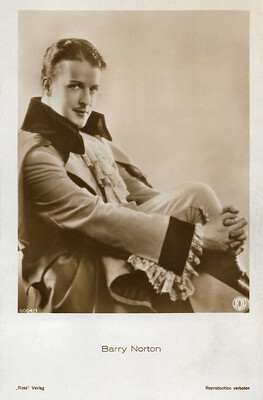
German postcard by Ross Verlag, no. 5004/1, 1930-1931. Photo: Fox. Imprint on the back of Ballerini & Fratini, Firenze.
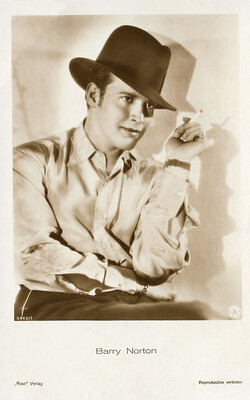
German postcard by Ross Verlag, no. 5468/1, 1930-1931. Photo: Fox.
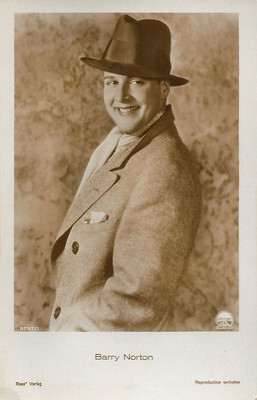
German postcard by Ross Verlag, no. 5737/1, 1930-1931. Photo: Paramount Pictures.
Usually playing sophisticated Europeans
In the early 1930s, Barry Norton could still get interesting roles in major films. He made a brief but incisive appearance in Josef von Sternberg 's Dishonoured (1931). At the end of the film, he is seen as a young lieutenant who refuses to carry out the execution of a spy played by Marlene Dietrich .
The Hollywood studios started producing alternate-language versions of their prestige productions, and he became one of the dozens of Latino actors needed. In Drácula (George Melford, 1930) he played the vampire's antagonist, Juan Harker. It was simultaneously shot with Bela Lugosi 's classic Dracula (Tod Browning, 1931) in the late hours and using the same sets. Norton also appeared in Spanish-language versions of Paramount on Parade (Edmund Goulding, a.o., 1930), The Benson Murder Case (Frank Tuttle, 1930), and The Criminal Code (Howard Hawks, 1931).
In a few cases, he appeared in both versions of a film. Examples include Storm Over the Andes/Alas sobre El Chaco (Christy Cabanne, 1935), Devil Monster/El diablo del Mar (S. Edwin Graham, 1936), and Captain Calamity/El capitan Tormenta (John Reinhardt, 1936), the latter film reuniting him with Lupita Tovar, his romantic interest from Dracula.
In addition to roles in Spanish-territory films, he had roles in numerous major films, usually playing sophisticated Europeans. With the decline in Spanish-language film production in Los Angeles, Norton's opportunities for leading roles became less and less frequent. Though he had a pleasing voice, his Argentine accent seemed incongruous with his appearance. According to some sources, he never mastered English very well. In 1933, he secured what would be his last important role, playing Jean Parker's Spanish fiancé in Frank Capra's Lady for a Day (1933). Although he would continue to work for another 15 years, Norton's last credited screen role would be in the comedy Should Husbands Work? (Gus Meins, 1939) starring James Gleason. For the rest of his career, Norton continued to reside in Los Angeles and obtain small roles in films.
Norton was married to Josephine Byers, a woman from California by whom he had a daughter, Sharon, and two grandchildren. In her autobiography 'Being and Becoming', actress Myrna Loy wrote that she briefly dated Norton. Other sources link him romantically with Dorothy Dare and Alice Terry . In the latter's case, they appear to have been friends rather than lovers. Barry Norton died of a heart attack in 1956 in Los Angeles, Hollywood, California. He was 51 years old. He died penniless and his old Hollywood friends – among them Antonio Moreno , Gilbert Roland , Gertrude Astor, Philo McCullough and Charles Morton – took up a collection to pay for his cremation, which required the permission of his brother in Buenos Aires.
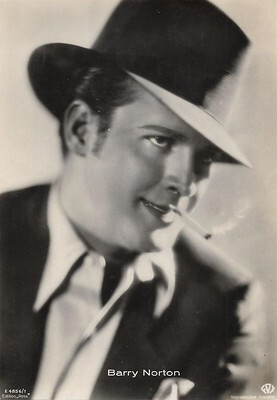
French postcard by Edition Ross, no. E 4856-1. Photo: Fox.
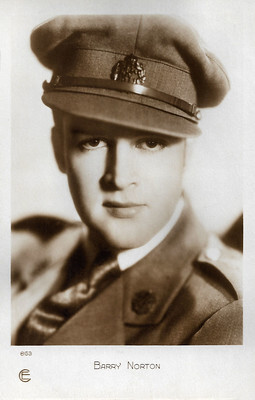
French postcard by Cinémagazine-Edition, no. 863.
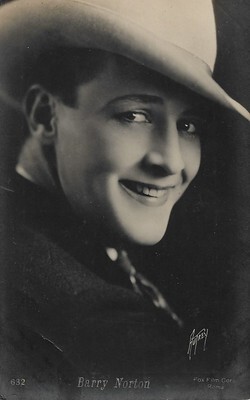
Italian postcard, no. 632. Photo: Autrey / Fox Film Corp., Rome.
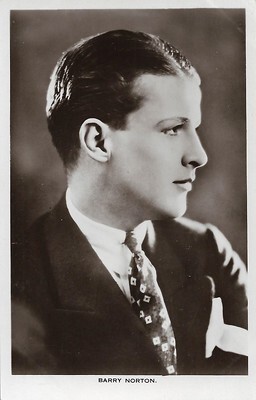
British postcard in the Picturegoer series, London, no. 423.
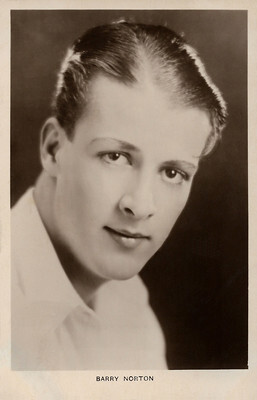
British postcard in the Picturegoer Series, London, no. 423a. Sent by mail in the Netherlands in 1931.
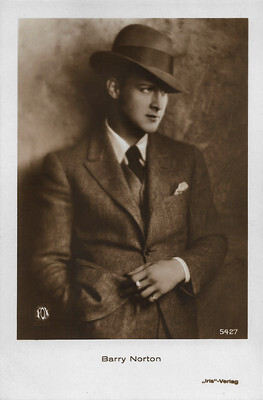
Austrian postcard by Iris Verlag, no. 5427. Photo: Fox.
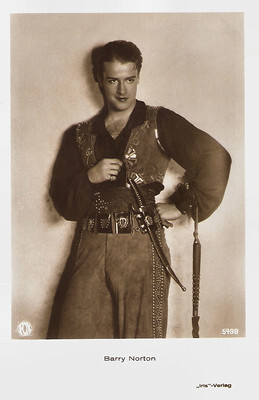
Austrian postcard by Iris Verlag, no. 5498. Photo: Fox.
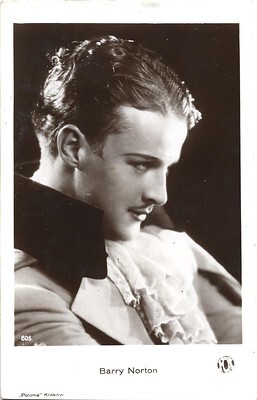
Polish postcard by Polonia, Krakow, no. 805. Photo: Fox Film.
Sources: Wikipedia and .

French postcard by Europe, no. 4932. Photo: Fox Films / Astra Cinégrafica.

Italian postcard by G.B. Falci Editore, Milano, no. 711 Photo: Charles Munn Autrey / Fox. Charles Morton, Janet Gaynor, Nancy Drexel, and Barry Norton in 4 Devils (Friedrich Wilhelm Murnau, 1928). 4 Devils is one of the most famous 'lost' films.

German postcard by Ross Verlag, no. 1854/1, 1927-1928. Photo: Fox.

German postcard by Ross Verlag, no. 4394/1, 1929-1930. Photo: Max Munn Autrey / Fox.

German postcard by Ross Verlag, no. 4856/1, 1929-1930. Photo: Fox.
There's a boy that is a 'natural'
Barry Norton was born Alfredo Carlos Birabén in 1905 in Buenos Aires, Argentina. He was the scion of a wealthy Argentine family. In 1923, Norton emigrated to the United States as a second cabin class passenger under the name of Carlos Manuel A. Biraben on the S/S Vestris, which had sailed from Buenos Aires, on 12 March, and arrived at the Port of New York on 1 April 1923.
Years later, he became a naturalised United States citizen. He was a talented ballroom dancer. After stops in New York City and Chicago, he finally came to Hollywood, where he first worked as an office assistant for Douglas Fairbanks .
On-screen, Norton first appeared as an extra in Fairbanks' silent action-adventure film The Black Pirate (Albert Parker, 1926). The boyish-looking actor signed a contract with the Fox Film Corporation and was soon cast in The Lily (Victor Schertzinger, 1926) with Belle Bennett.
His big break came when he was given the role of Pvt. "Mother's Boy" Lewisohn in the silent comedy-drama war film What Price Glory? (Raoul Walsh, 1926) which turned out to be a huge commercial success. Another success was Sunrise: A Song of Two Humans (F.W. Murnau, 1927) starring George O'Brien, Janet Gaynor , and Margaret Livingston . Norton only appeared in a bit role but he landed a substantial role in Friedrich Wilhelm Murnau 's 4 Devils (F.W. Murnau, 1928) opposite Janet Gaynor and Charles Morton .
Norton then landed a leading role as Emil Jannings ' son in the drama Sins of the Fathers (Ludwig Berger, 1928). He also played a leading role opposite Gary Cooper and Fay Wray in Legion of the Condemned (William Wellman, 1928) which was also very successful. His acting was well-received by audiences and critics at the time, and, during the silent era, he avoided being typecast as a Latin lover. One theatre owner in Golden City, Montana, said, "[Norton] has as yet to show me a bad performance. There's a boy that is a 'natural'."

Italian postcard by G.B. Falci Editore, Milano, no. 708. Photo: Max Munn Autrey / Fox. Janet Gaynor , Nancy Drexel, Barry Norton and Charles Morton in 4 Devils (Friedrich Wilhelm Murnau, 1928). 4 Devils is one of the most famous 'lost' films.

Dutch postcard. Photo: Fox. Barry Norton, Janet Gaynor and Nancy Drexel in 4 Devils (F.W. Murnau, 1928).

German postcard by Ross Verlag, no. 5004/1, 1930-1931. Photo: Fox. Imprint on the back of Ballerini & Fratini, Firenze.

German postcard by Ross Verlag, no. 5468/1, 1930-1931. Photo: Fox.

German postcard by Ross Verlag, no. 5737/1, 1930-1931. Photo: Paramount Pictures.
Usually playing sophisticated Europeans
In the early 1930s, Barry Norton could still get interesting roles in major films. He made a brief but incisive appearance in Josef von Sternberg 's Dishonoured (1931). At the end of the film, he is seen as a young lieutenant who refuses to carry out the execution of a spy played by Marlene Dietrich .
The Hollywood studios started producing alternate-language versions of their prestige productions, and he became one of the dozens of Latino actors needed. In Drácula (George Melford, 1930) he played the vampire's antagonist, Juan Harker. It was simultaneously shot with Bela Lugosi 's classic Dracula (Tod Browning, 1931) in the late hours and using the same sets. Norton also appeared in Spanish-language versions of Paramount on Parade (Edmund Goulding, a.o., 1930), The Benson Murder Case (Frank Tuttle, 1930), and The Criminal Code (Howard Hawks, 1931).
In a few cases, he appeared in both versions of a film. Examples include Storm Over the Andes/Alas sobre El Chaco (Christy Cabanne, 1935), Devil Monster/El diablo del Mar (S. Edwin Graham, 1936), and Captain Calamity/El capitan Tormenta (John Reinhardt, 1936), the latter film reuniting him with Lupita Tovar, his romantic interest from Dracula.
In addition to roles in Spanish-territory films, he had roles in numerous major films, usually playing sophisticated Europeans. With the decline in Spanish-language film production in Los Angeles, Norton's opportunities for leading roles became less and less frequent. Though he had a pleasing voice, his Argentine accent seemed incongruous with his appearance. According to some sources, he never mastered English very well. In 1933, he secured what would be his last important role, playing Jean Parker's Spanish fiancé in Frank Capra's Lady for a Day (1933). Although he would continue to work for another 15 years, Norton's last credited screen role would be in the comedy Should Husbands Work? (Gus Meins, 1939) starring James Gleason. For the rest of his career, Norton continued to reside in Los Angeles and obtain small roles in films.
Norton was married to Josephine Byers, a woman from California by whom he had a daughter, Sharon, and two grandchildren. In her autobiography 'Being and Becoming', actress Myrna Loy wrote that she briefly dated Norton. Other sources link him romantically with Dorothy Dare and Alice Terry . In the latter's case, they appear to have been friends rather than lovers. Barry Norton died of a heart attack in 1956 in Los Angeles, Hollywood, California. He was 51 years old. He died penniless and his old Hollywood friends – among them Antonio Moreno , Gilbert Roland , Gertrude Astor, Philo McCullough and Charles Morton – took up a collection to pay for his cremation, which required the permission of his brother in Buenos Aires.

French postcard by Edition Ross, no. E 4856-1. Photo: Fox.

French postcard by Cinémagazine-Edition, no. 863.

Italian postcard, no. 632. Photo: Autrey / Fox Film Corp., Rome.

British postcard in the Picturegoer series, London, no. 423.

British postcard in the Picturegoer Series, London, no. 423a. Sent by mail in the Netherlands in 1931.

Austrian postcard by Iris Verlag, no. 5427. Photo: Fox.

Austrian postcard by Iris Verlag, no. 5498. Photo: Fox.

Polish postcard by Polonia, Krakow, no. 805. Photo: Fox Film.
Sources: Wikipedia and .
Published on September 06, 2023 22:00
September 5, 2023
Die Herrin der Welt (1919)
In the German adventure serial Die Herrin der Welt/Mistress of the World (1919) the title role was played by one of the first divas of the German cinema, Mia May. The producer, writer and director of the popular serial was Mia's husband, Joe May. He brought together talent from across German cinema, including many who would work behind the camera during the emergence of Expressionist cinema. The first film was released in Germany on 5 December 1919, and this was followed each week by the release of the subsequent episodes.
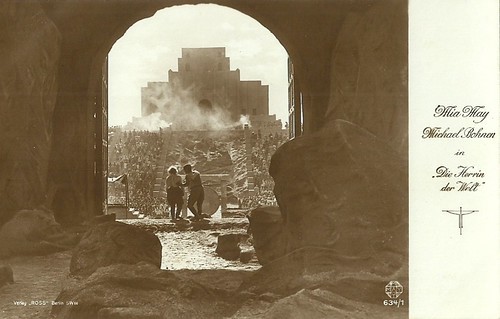
German postcard by Ross Verlag, no. 634/1. Photo: May Film. Mia May and Michael Bohnen in Die Herrin der Welt/Mistress of the World (Joe May and others, 1919). Maug Gregaard (Mia May) and Consul Madsen (Michael Bohnen) at Ophir, the City of the Past.
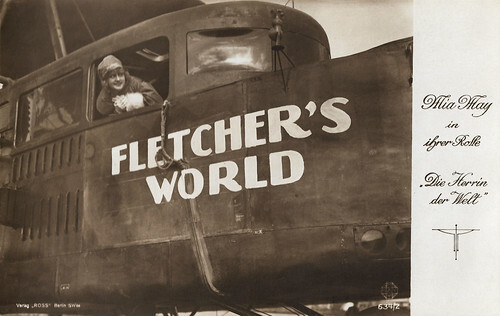
German postcard by Ross Verlag, no. 634/2. Photo: May Film. Mia May in Die Herrin der Welt/Mistress of the World (Joe May and others, 1919).
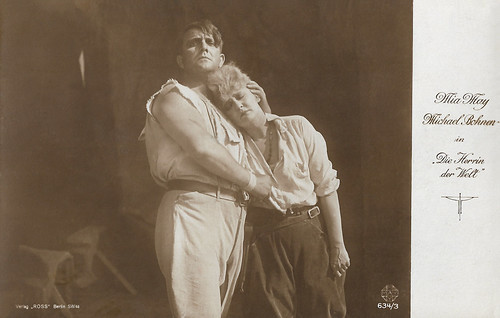
German postcard by Ross Verlag, no. 634/3. Photo: May Film. Mia May and Michael Bohnen in Die Herrin der Welt (Joe May and others, 1919). Mia May as Maud Gregaard and Michael Bohnen as Consul Madsen.
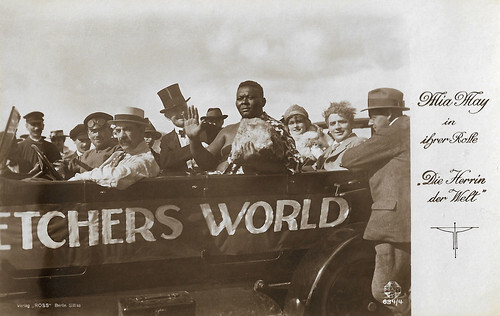
German postcard by Ross Verlag, no. 634/4. Photo: May Film. Mia May and Michael Bohnen in Die Herrin der Welt/Mistress of the World (Joe May and others, 1919). The man with the top hat is Hermann Picha, who plays newspaper mogul Jonathan Fletcher.
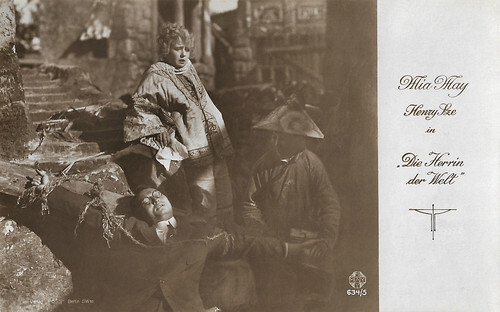
German postcard by Ross Verlag, no. 634/5. Photo: May Film. Mia May and Henry Sze in Die Herrin der Welt/Mistress of the World (Joe May and others, 1919). Mia May as Maud Gregaard and Henry Sze as Dr. Kien-Lung.
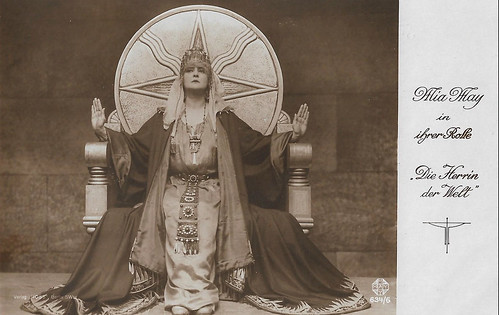
German postcard by Ross Verlag, no. 634/6. Photo: May Film. Mia May in Die Herrin der Welt/Mistress of the World (Joe May and others, 1919). Mia May is Maud Gregaard, who at one point is considered the reincarnation of the goddess Astarte.
The Indiana Jones-like story
In 1919, Joe May, Joseph Klein, Uwe Jenss Krafft, and Karl Gerhardt shot the various episodes for the eight-part German silent serial Die Herrin der Welt/Mistress of the World (1919), one of the most notable adventure series of the Weimar cinema and considered the first monumental film in German film history.
The star of the serial was Joe May's wife Mia May , and her male film partner was played by Michael Bohnen. May shot episodes 1, 2, 3 and 8, Uwe Jenss Krafft 4 to 6, and Karl Gerhardt 7. Joseph Klein was co-director for parts 1 and 4.
The Indiana Jones-like story follows the young Maud Gregaard ( Mia May ) on her globe-trotting adventures to find the legendary lost treasure of the Queen of Sheba.
She hopes it will enable her to bring revenge on the man who drew her father to commit suicide and led to her own social destruction. Once in China, she is taken captive by an evil man and nearly killed in the belief she is a witch.
All eight parts were full-length. Even if self-sustaining features they referred to future developments without American-styled cliffhangers. Even if part of the press was critical, German audiences loved it and it was a bigger box office than the contemporary Das Cabinet des Dr. Caligari/The Cabinet of Dr. Caligari (Robert Wiene, 1920).
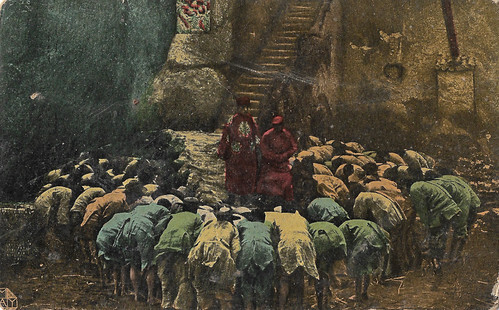
Spanish collectors card by Chocolat Imperiale, Barcelona, episode 1, no. 5. Photo: Distr. J. Gurgui, Barcelona / May Film. Publicity still for Die Herrin der Welt/The Mistress of the World (1919), starring Mia May. Spanish film title: La dueñá del mundo.
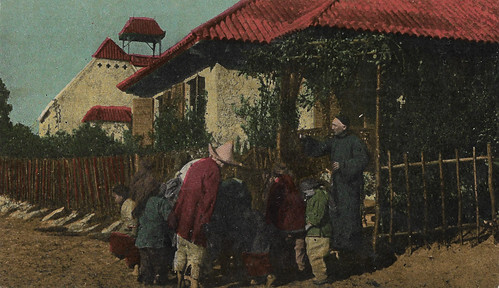
Spanish collectors card by Chocolat Imperiale, Barcelona, episode 3, no. 3. Photo: Distr. J. Gurgui, Barcelona / May Film. Publicity still for Die Herrin der Welt/The Mistress of the World (1919).

Spanish collectors card by Chocolat Imperiale, Barcelona, episode 4, no. 4. Photo: Distr. J. Gurgui, Barcelona / May Film. Mia May in Die Herrin der Welt/The Mistress of the World (1919).
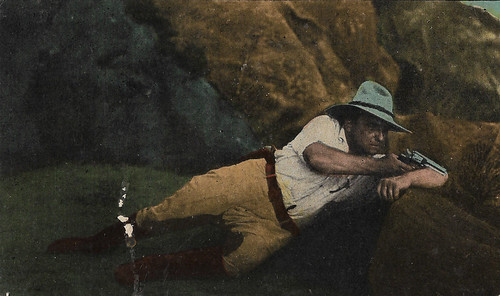
Spanish collectors card by Chocolat Imperiale, Barcelona, episode 4, no. 5. Photo: Distr. J. Gurgui, Barcelona / May Film. Michael Bohnen in Die Herrin der Welt/The Mistress of the World (1919).
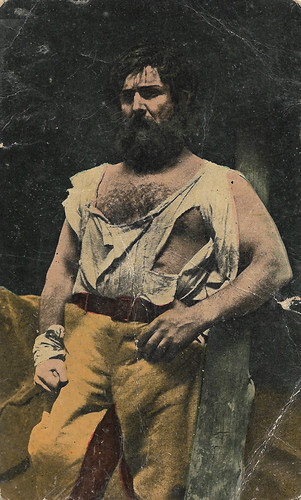
Spanish collectors card by Chocolat Imperiale, Barcelona, episode 5, no. 1. Photo: Distr. J. Gurgui, Barcelona / May Film. Michael Bohnen as Consul Madsen in Die Herrin der Welt/The Mistress of the World (1919). Spanish film title: La dueñá del mundo.
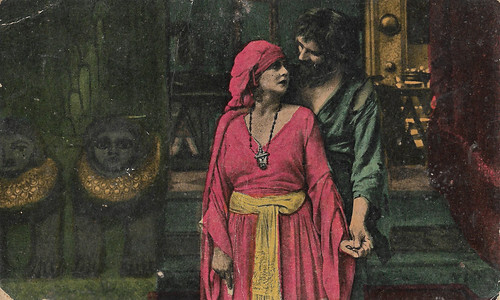
Spanish collectors card by Chocolat Imperiale, Barcelona, episode 5, no. 3. Photo: Distr. J. Gurgui, Barcelona / May Film. Mia May and Michael Bohnen in Die Herrin der Welt/The Mistress of the World (1919).
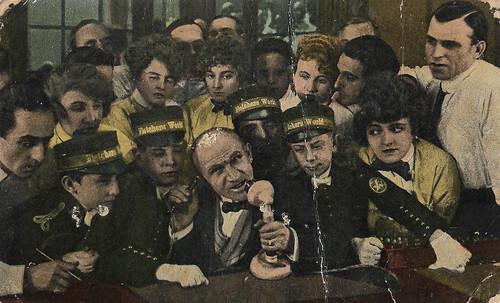
Spanish collectors card by Chocolat Imperiale, Barcelona, episode 6, no. 2. Photo: Distr. J. Gurgui, Barcelona / May Film. Publicity still for Die Herrin der Welt/The Mistress of the World (1919), starring Mia May. The man in the middle may be German actor Hermann Picha, who plays newspaper mogul Jonathan Fletcher. Spanish film title: La dueñá del mundo.
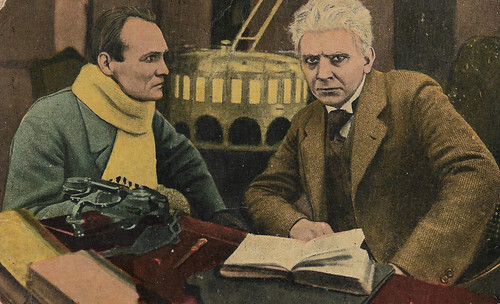
Spanish collectors card by Chocolat Imperiale, Barcelona, episode 7, no. 7. Photo: Distr. J. Gurgui, Barcelona / May Film. Bernhard Goetzke (left) in Die Herrin der Welt/The Mistress of the World (1919). The man on the right could be actor Paul Hansen, who plays the engineer Allan Stanley. He is the main male actor of episode 7.
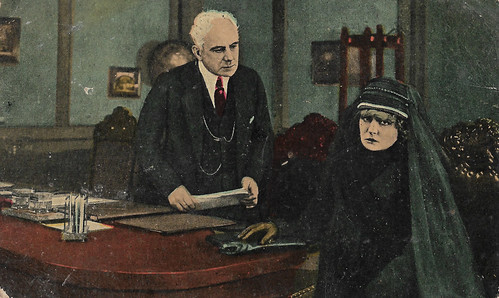
Spanish collectors card by Chocolat Imperiale, Barcelona, episode 7, no. 8 in a series of 8 cromos. Photo: J. Gurgui, Barcelona / May Film. Mia May and Rudolf Lettinger as Detective Hunt in the serial Die Herrin der Welt/The Mistress of the World (1919).
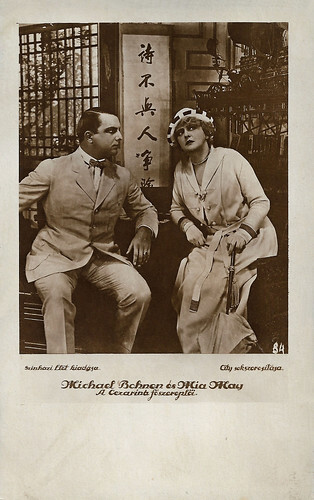
Hungarian postcard, no. 84. Photo: Színházi Élet Kiadási / City Sokszorositása. Michael Bohnen and Mia May in Herrin der Welt/Mistress of the World (Joe May, 1919-1920).
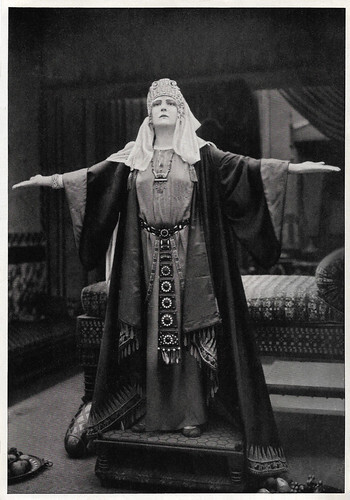
German collectors card by Ross Verlag in the series Vom Werden deutscher Filmkunst - Der Stumme Film, picture no. 62, group 40. Photo: Ufa. Mia May in Die Herrin der Welt/Mistress of the World (Joe May and others, 1919).
Sources: Wikipedia (German and English), and IMDb.

German postcard by Ross Verlag, no. 634/1. Photo: May Film. Mia May and Michael Bohnen in Die Herrin der Welt/Mistress of the World (Joe May and others, 1919). Maug Gregaard (Mia May) and Consul Madsen (Michael Bohnen) at Ophir, the City of the Past.

German postcard by Ross Verlag, no. 634/2. Photo: May Film. Mia May in Die Herrin der Welt/Mistress of the World (Joe May and others, 1919).

German postcard by Ross Verlag, no. 634/3. Photo: May Film. Mia May and Michael Bohnen in Die Herrin der Welt (Joe May and others, 1919). Mia May as Maud Gregaard and Michael Bohnen as Consul Madsen.

German postcard by Ross Verlag, no. 634/4. Photo: May Film. Mia May and Michael Bohnen in Die Herrin der Welt/Mistress of the World (Joe May and others, 1919). The man with the top hat is Hermann Picha, who plays newspaper mogul Jonathan Fletcher.

German postcard by Ross Verlag, no. 634/5. Photo: May Film. Mia May and Henry Sze in Die Herrin der Welt/Mistress of the World (Joe May and others, 1919). Mia May as Maud Gregaard and Henry Sze as Dr. Kien-Lung.

German postcard by Ross Verlag, no. 634/6. Photo: May Film. Mia May in Die Herrin der Welt/Mistress of the World (Joe May and others, 1919). Mia May is Maud Gregaard, who at one point is considered the reincarnation of the goddess Astarte.
The Indiana Jones-like story
In 1919, Joe May, Joseph Klein, Uwe Jenss Krafft, and Karl Gerhardt shot the various episodes for the eight-part German silent serial Die Herrin der Welt/Mistress of the World (1919), one of the most notable adventure series of the Weimar cinema and considered the first monumental film in German film history.
The star of the serial was Joe May's wife Mia May , and her male film partner was played by Michael Bohnen. May shot episodes 1, 2, 3 and 8, Uwe Jenss Krafft 4 to 6, and Karl Gerhardt 7. Joseph Klein was co-director for parts 1 and 4.
The Indiana Jones-like story follows the young Maud Gregaard ( Mia May ) on her globe-trotting adventures to find the legendary lost treasure of the Queen of Sheba.
She hopes it will enable her to bring revenge on the man who drew her father to commit suicide and led to her own social destruction. Once in China, she is taken captive by an evil man and nearly killed in the belief she is a witch.
All eight parts were full-length. Even if self-sustaining features they referred to future developments without American-styled cliffhangers. Even if part of the press was critical, German audiences loved it and it was a bigger box office than the contemporary Das Cabinet des Dr. Caligari/The Cabinet of Dr. Caligari (Robert Wiene, 1920).

Spanish collectors card by Chocolat Imperiale, Barcelona, episode 1, no. 5. Photo: Distr. J. Gurgui, Barcelona / May Film. Publicity still for Die Herrin der Welt/The Mistress of the World (1919), starring Mia May. Spanish film title: La dueñá del mundo.

Spanish collectors card by Chocolat Imperiale, Barcelona, episode 3, no. 3. Photo: Distr. J. Gurgui, Barcelona / May Film. Publicity still for Die Herrin der Welt/The Mistress of the World (1919).

Spanish collectors card by Chocolat Imperiale, Barcelona, episode 4, no. 4. Photo: Distr. J. Gurgui, Barcelona / May Film. Mia May in Die Herrin der Welt/The Mistress of the World (1919).

Spanish collectors card by Chocolat Imperiale, Barcelona, episode 4, no. 5. Photo: Distr. J. Gurgui, Barcelona / May Film. Michael Bohnen in Die Herrin der Welt/The Mistress of the World (1919).

Spanish collectors card by Chocolat Imperiale, Barcelona, episode 5, no. 1. Photo: Distr. J. Gurgui, Barcelona / May Film. Michael Bohnen as Consul Madsen in Die Herrin der Welt/The Mistress of the World (1919). Spanish film title: La dueñá del mundo.

Spanish collectors card by Chocolat Imperiale, Barcelona, episode 5, no. 3. Photo: Distr. J. Gurgui, Barcelona / May Film. Mia May and Michael Bohnen in Die Herrin der Welt/The Mistress of the World (1919).

Spanish collectors card by Chocolat Imperiale, Barcelona, episode 6, no. 2. Photo: Distr. J. Gurgui, Barcelona / May Film. Publicity still for Die Herrin der Welt/The Mistress of the World (1919), starring Mia May. The man in the middle may be German actor Hermann Picha, who plays newspaper mogul Jonathan Fletcher. Spanish film title: La dueñá del mundo.

Spanish collectors card by Chocolat Imperiale, Barcelona, episode 7, no. 7. Photo: Distr. J. Gurgui, Barcelona / May Film. Bernhard Goetzke (left) in Die Herrin der Welt/The Mistress of the World (1919). The man on the right could be actor Paul Hansen, who plays the engineer Allan Stanley. He is the main male actor of episode 7.

Spanish collectors card by Chocolat Imperiale, Barcelona, episode 7, no. 8 in a series of 8 cromos. Photo: J. Gurgui, Barcelona / May Film. Mia May and Rudolf Lettinger as Detective Hunt in the serial Die Herrin der Welt/The Mistress of the World (1919).

Hungarian postcard, no. 84. Photo: Színházi Élet Kiadási / City Sokszorositása. Michael Bohnen and Mia May in Herrin der Welt/Mistress of the World (Joe May, 1919-1920).

German collectors card by Ross Verlag in the series Vom Werden deutscher Filmkunst - Der Stumme Film, picture no. 62, group 40. Photo: Ufa. Mia May in Die Herrin der Welt/Mistress of the World (Joe May and others, 1919).
Sources: Wikipedia (German and English), and IMDb.
Published on September 05, 2023 22:00
September 4, 2023
Aud Egede Nissen
Norwegian film actress Aud Egede Nissen (1893-1974) was a star of the German silent cinema. During the 1910s, she produced dozens of her own films. In the 1930s she returned to Norway, where she appeared in some films but acted mainly on stage.
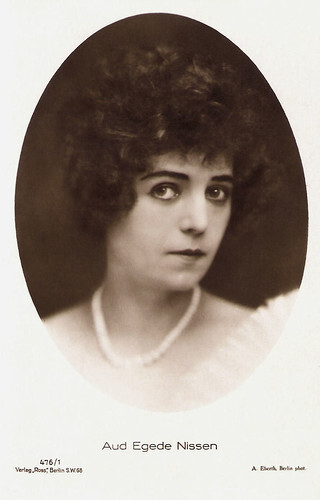
German postcard by Ross Verlag, no. 476/1, 1919-1924. Photo: A. Eberth, Berlin.

German postcard by Rotophot in the Film-Sterne series, no. 553/2. Photo: ENF (Egede-Nissen-Film). Aud Egede Nissen and Georg Alexander in the German silent film Die lachende Seele/The Laughing Soul (Georg Alexander, 1919).
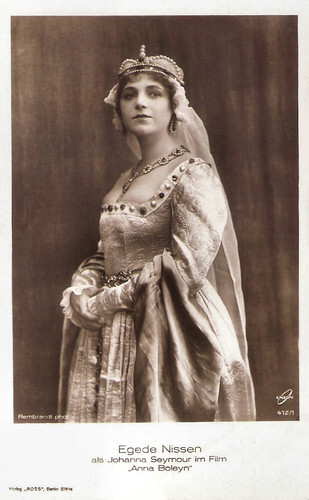
German postcard by Ross Verlag, Berlin, no. 472/1, 1919-1924. Photo: Rembrandt Phot. / Union Film. Aud Egede Nissen as Jane Seymour in Anna Boleyn (Ernst Lubitsch, 1920).
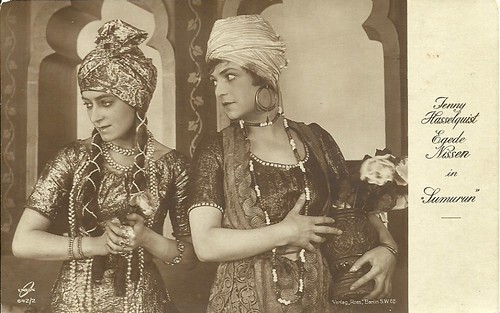
German postcard by Ross Verlag, Berlin, no. 642/2, 1919-1924. Photo: Union Film. Jenny Hasselqvist and Aud Egede Nissen Sumurun (Ernst Lubitsch, 1920). Collection: Didier Hanson.
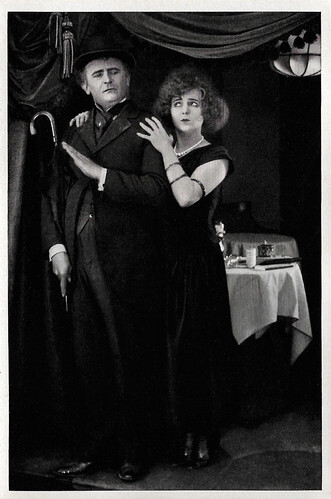
German collectors card by Ross Verlag in the series Vom Werden deutscher Filmkunst - Der Stumme Film, picture no. 103, group 43. Photo: Stern-Film. Eugen Klöpfer and Aud Egede Nissen in Die Strasse/The Street (Karl Grune, 1923).
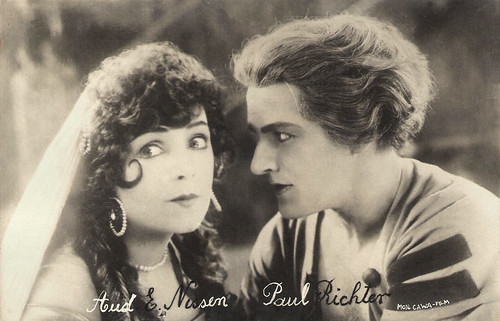
Vintage postcard. Photo: Mon. Cawa-Film. Aud Egede Nissen and Paul Richter in Pietro der Korsar/Peter the Pirate (Arthur Robison, 1925).
The first female detective
Aud Egede Nissen, aka Aud Richter, was born in Bergen, Norway, in 1893. She was the daughter of Norwegian politician Adam Egede-Nissen. Her four younger sisters and two younger brothers would become actors as well.
She started her film career in the Danish film Scenens børn/Children of the Stage; or, When Love Speaks (Bjørn Bjørnson, 1913). This film is now believed to be lost. After four films in Denmark, mostly shorts, she moved to Germany in 1914 and debuted there with the Dania-Film production Um ein Weib/Because of a Woman (Carl Schönfeld, 1914).
During the First World War, Nissen had an enormously productive career, changing from one company to another: from Nation Film and the direction of Alfred Halm to Literaria Film with Georg Jacoby directing, from Luna Film with Fred Sauer (who also directed her for Salden Film) to Greenbaum Film with Max Mack . She played a.o. in the serial Homunculus (Otto Rippert, 1916) with Theodor Loos .
In 1916/1917 she founded her own production company where her husband Georg Alexander directed her in films with herself in the lead. She appeared in more than one film per month (!), including Ich heirate meine Puppe/I Married My Doll (1917), and Das Geheimnis der Briefmarke/The Secret of the Stamp (1917). Very popular was the Ada-van-Ehlers serial. Ada van Ehlers impersonated the first female detective.
Slowly, Egede Nissen became more producer than an actress in 1917-1918, though she also continued to act in her own films as well. Nissen’s last own production within this constant and long production line probably was 100.000 Dollars (1919), as always directed by Georg Alexander , though still in 1921 the film Die Idee des Dr. Pax was released, which was a Nissen production as well.
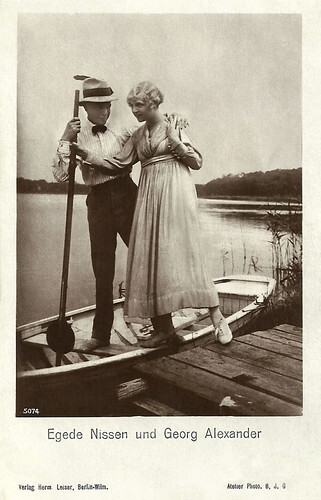
With Georg Alexander . German postcard by Verlag Hermann Leiser, Berlin, no. 5074. Photo: Atelier B.J.G.

German postcard by Photochemie, no. K. 2245. Photo: Egede Nissen-Film. Georg Alexander and Aud Egede Nissen in the German silent melodrama Der Rosenkranz/The Rosary (Georg Alexander, 1918).
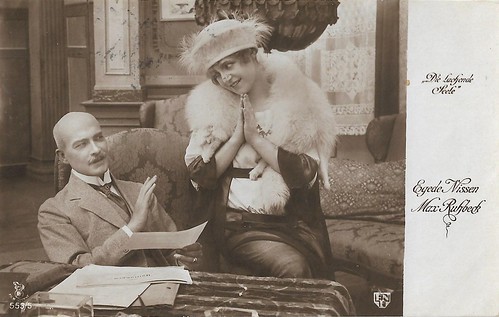
German postcard by Rotophot in the Film-Sterne series, no. 553/2. Photo: ENF (Egede-Nissen-Film). Aud Egede Nissen and Max Ruhbeck in Die lachende Seele/The Laughing Soul (Georg Alexander, 1919).
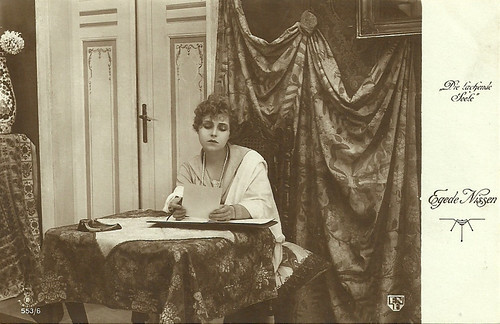
German postcard by Rotophot in the Film-Sterne series, no. 553/6. Photo: ENF (Egede-Nissen-Film). Aud Egede Nissen in Die lachende Seele/The Laughing Soul (Georg Alexander, 1919).
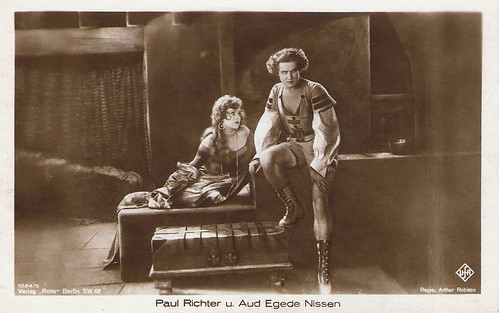
German postcard by Ross Verlag, Berlin, no. 1024/5, 1927-1928. Photo: Ufa. Aud Egede Nissen and Paul Richter in Pietro der Korsar/Peter the Pirate (Arthur Robison, 1925).
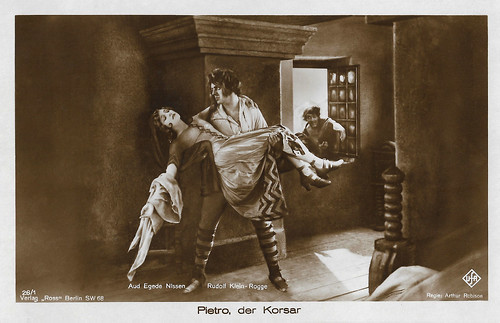
German postcard by Ross Verlag, Berlin, no. 26/1. Photo: Ufa. Aud Egede Nissen and Rudolf Klein-Rogge in Pietro der Korsar/Peter the Pirate (Arthur Robison, 1925).
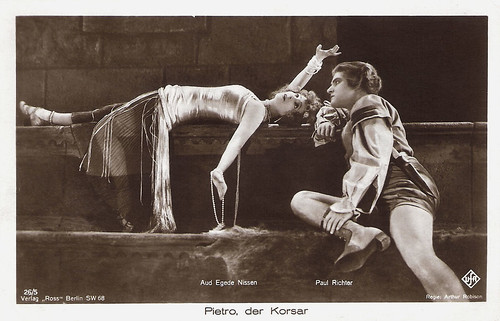
German postcard by Ross Verlag, Berlin, no. 26/5, 1927-1928. Photo: Ufa. Aud Egede Nissen and Paul Richter in Pietro der Korsar/Peter the Pirate (Arthur Robison, 1925).
Lubitsch, Lang and Murnau
Around 1920. Aud Egede Nissen shifted to performing in major productions. She was Sumurun’s ( Pola Negri ) servant Haidee in Ernst Lubitsch ’s murderous exotic tale Sumurun (1920), the daughter of a merchant freed from Chinese bandits by a reporter in Schiffen und Menschen/Ships and People (Carl Boese, 1920), a female artist in the third sequel to Die Lieblingsfrau der Maharadscha/The Favorite Wife of the Maharadja (Max Mack, 1920), Jane Seymour in Lubitsch’ epic Anna Boleyn (Ernst Lubitsch, 1920), and the dancer Cara Carozza, accomplice to evil hypnotist Mabuse, in Fritz Lang ’s thriller Dr. Mabuse, der Spieler/Dr. Mabuse: The Gambler (1921/1922).
In 1922 Nissen was Melanie Lubota, the sister of the main character ( Alfred Abel ) in F.W. Murnau 's Phantom/The Phantom. In 1923 she was the prostitute in the expressionist drama Die Strasse/The Street (Karl Grune, 1923). The story is about a man, who leaves his wife and humdrum life to seek the excitement of a Parisian street. He spends most of the story chasing after a prostitute thief, which eventually leads him to prison and despair. He then returns to his previous life. In Carlos un Elisabeth (Richard Oswald, 1923), Nissen played Princess Eboli opposite Conrad Veidt .
Later she had the female leads in three realist films by Gerhard Lamprecht: Menschen untereinander (Gerhard Lamprecht, 1925), Die Verrufenen (Gerhard Lamprecht, 1925), and Schwester Veronika (Gerhard Lamprecht, 1925). Other films were the Dutch-German coproduction Droomkoninkje/Die vom Schicksal verfolgten/Little Dream King (Henk Kleinman, 1926), and Die Villa im Tiergarten/The Villa in the Zoo (Franz Osten, 1926).
In such films as Pietro, der Korsar/Pietro the Cossack (Artur Robison, 1925), and Der König der Mittelsturmer/King Of The Centre-forward (1927) she appeared opposite her second husband, Paul Richter . The latter can be considered the first real German soccer feature.
In her last silent film, Die Frau im Talar/The Woman in the Robe (Adolf Trotz, 1929), clearly designed for her, Aud Egede Nissen played a female prosecutor in a Norwegian (!) harbour town, who must judge the man she loves ( Paul Richter ) for a fraud committed by her own father out of despair.
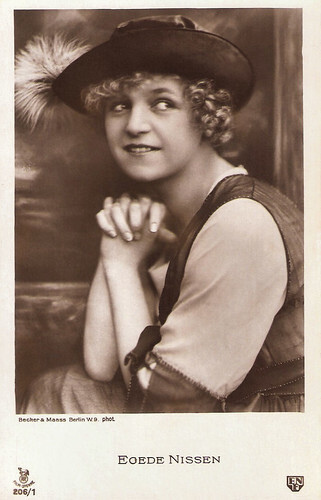
German postcard by Rotophot in the Film Sterne series, no. 206/1. Photo: Becker & Maas / Egede-Nissen-Film (ENF).
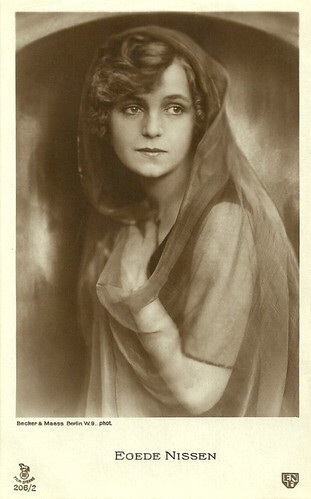
German postcard by Rotophot in the Film-Sterne series, no. 206/2. Photo: Becker & Maass, Berlin / ENF.
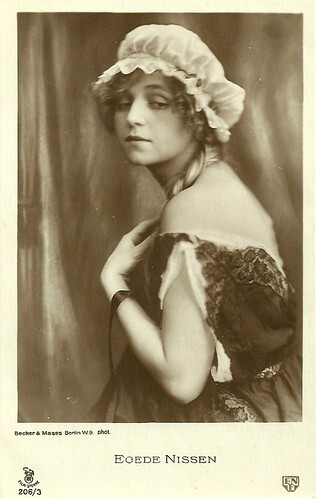
German postcard by Rotophot in the Film-Sterne series, no. 206/3. Photo: Becker & Maass, Berlin / ENF.
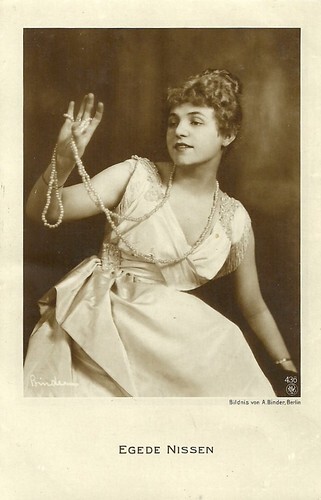
German postcard by NPG, no. 436. Photo: Alex Binder, Berlin.
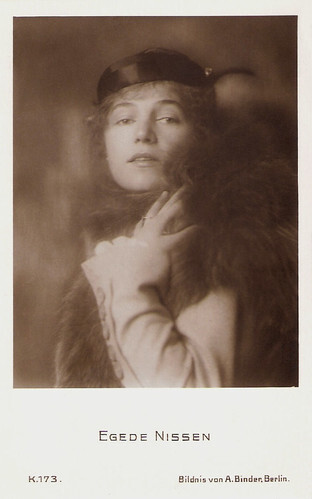
German postcard by Photochemie, Berlin, no. K. 173. Photo: Alex Binder, Berlin.
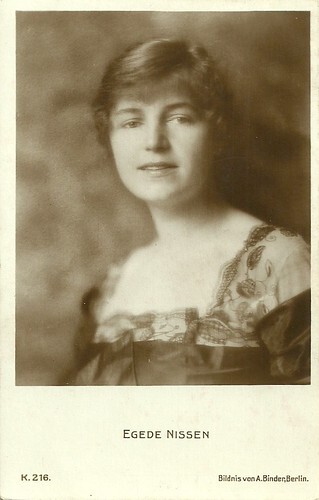
German postcard by Photochemie, Berlin, no K. 216. Photo: Alex Binder, Berlin.
Back to Norway
Aud Egede Nissen played roles in the German sound film Zwischen Nacht und Morgen/Between Night and Dawn (Gerhard Lamprecht, 1931) opposite Oscar Homolka , and the Danish film Eskimo (Georg Schnéevoigt, 1930), starring Mona Mårtenson . She broke up with Richter and went back to Norway in 1931.
In Norway, her experience was appreciated and she became the production manager for two films: En glad gutt/A Happy Boy (John W. Brunius, 1932) and Syndere i sommersol/Sinners in summer sun (Einar Sissener, 1934). She also played small parts in two films during the war years, Hansen og Hansen/Hansen and Hansen (Alfred Maurstad, 1941) and the romantic drama Trysil-Knut (Rasmus Breistein, 1942), starring Alfred Maurstad.
During the 1930s Nissen debuted on the Norwegian stage and played a large number of roles in 1934-1935, including Hermione in 'The Winter's Tale' (1934) and Gertrud in 'Hamlet' (1935). In 1939 she debuted as a theatre director with the play 'Ansikt til ansikt' (Face to Face). In particular, between 1955 and 1962 she directed many plays.
Aud Egede Nissen died in Oslo, Norway, in 1974. From 1915 to 1924, she was married to actor-director Georg Alexander . She then married actor Paul Richter whom she divorced in 1931. Her son by Georg Alexander , named after his stepfather Georg Richter, also became an actor and producer. Since 1940 she was married to Dag Havrevold.
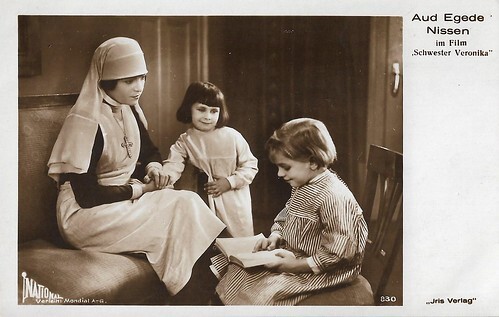
Austrian postcard by Iris Verlag, no. 830. Photo: National Film / Distr. Mondial A.G. Aud Egede Nissen in Schwester Veronica/Sister Veronica (Gerhard Lamprecht, 1927).
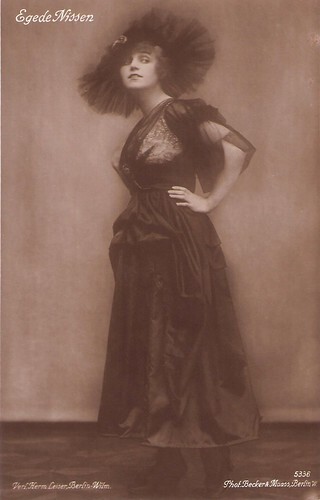
German postcard by Verl. Herm. Leiser, Berlin-Wilm, no. 5336. Photo: Becker & Maas, Berlin-W.
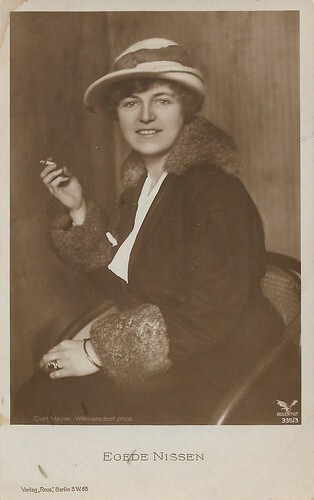
German postcard by Ross Verlag, Berlin, no. 335/3, 1919-1924. Photo: Curt Meyer, Berlin / Adler-Film.
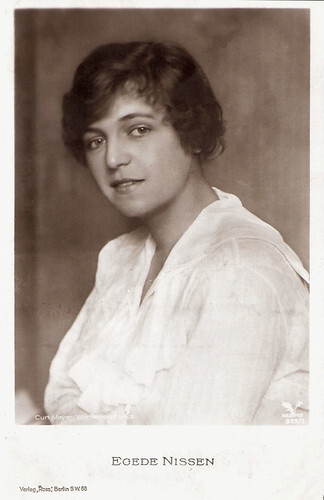
German postcard by Ross Verlag, Berlin, no. 385/2, 1919-1924. Photo: Curt Mayer, Wilmendorf / Adler-Film.
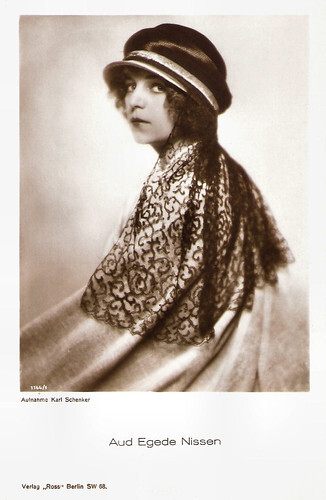
German postcard by Ross Verlag, Berlin, no. 1144/1, 1927-1928. Photo: Karl Schenker, Berlin.
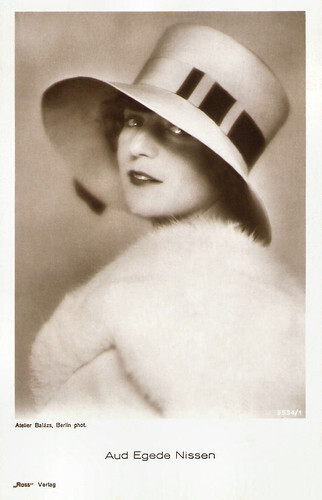
German postcard by Ross Verlag, Berlin, no. 3534/1, 1928-1929. Photo: Atelier Balázs, Berlin.
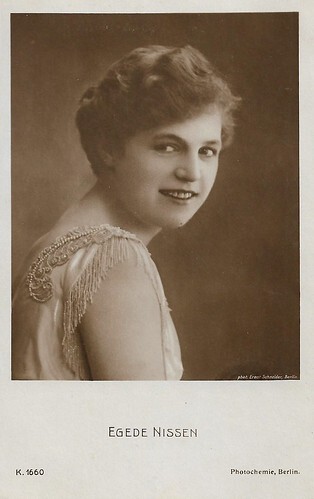
German postcard by Photochemie, no. K. 1660. Photo: Ernst Schneider.
Aud Egede Nissen in the silent Norwegian-German crime film Bergenstoget plyndret inatt/Schneeschuhbanditen (Uwe Jenns Krafft, 1928) with Paul Richter . Source: Norskfilminstitutt (YouTube).
Sources: Thomas Staedeli (Cyranos), Filmportal.de (German), Wikipedia, and .

German postcard by Ross Verlag, no. 476/1, 1919-1924. Photo: A. Eberth, Berlin.

German postcard by Rotophot in the Film-Sterne series, no. 553/2. Photo: ENF (Egede-Nissen-Film). Aud Egede Nissen and Georg Alexander in the German silent film Die lachende Seele/The Laughing Soul (Georg Alexander, 1919).

German postcard by Ross Verlag, Berlin, no. 472/1, 1919-1924. Photo: Rembrandt Phot. / Union Film. Aud Egede Nissen as Jane Seymour in Anna Boleyn (Ernst Lubitsch, 1920).

German postcard by Ross Verlag, Berlin, no. 642/2, 1919-1924. Photo: Union Film. Jenny Hasselqvist and Aud Egede Nissen Sumurun (Ernst Lubitsch, 1920). Collection: Didier Hanson.

German collectors card by Ross Verlag in the series Vom Werden deutscher Filmkunst - Der Stumme Film, picture no. 103, group 43. Photo: Stern-Film. Eugen Klöpfer and Aud Egede Nissen in Die Strasse/The Street (Karl Grune, 1923).

Vintage postcard. Photo: Mon. Cawa-Film. Aud Egede Nissen and Paul Richter in Pietro der Korsar/Peter the Pirate (Arthur Robison, 1925).
The first female detective
Aud Egede Nissen, aka Aud Richter, was born in Bergen, Norway, in 1893. She was the daughter of Norwegian politician Adam Egede-Nissen. Her four younger sisters and two younger brothers would become actors as well.
She started her film career in the Danish film Scenens børn/Children of the Stage; or, When Love Speaks (Bjørn Bjørnson, 1913). This film is now believed to be lost. After four films in Denmark, mostly shorts, she moved to Germany in 1914 and debuted there with the Dania-Film production Um ein Weib/Because of a Woman (Carl Schönfeld, 1914).
During the First World War, Nissen had an enormously productive career, changing from one company to another: from Nation Film and the direction of Alfred Halm to Literaria Film with Georg Jacoby directing, from Luna Film with Fred Sauer (who also directed her for Salden Film) to Greenbaum Film with Max Mack . She played a.o. in the serial Homunculus (Otto Rippert, 1916) with Theodor Loos .
In 1916/1917 she founded her own production company where her husband Georg Alexander directed her in films with herself in the lead. She appeared in more than one film per month (!), including Ich heirate meine Puppe/I Married My Doll (1917), and Das Geheimnis der Briefmarke/The Secret of the Stamp (1917). Very popular was the Ada-van-Ehlers serial. Ada van Ehlers impersonated the first female detective.
Slowly, Egede Nissen became more producer than an actress in 1917-1918, though she also continued to act in her own films as well. Nissen’s last own production within this constant and long production line probably was 100.000 Dollars (1919), as always directed by Georg Alexander , though still in 1921 the film Die Idee des Dr. Pax was released, which was a Nissen production as well.

With Georg Alexander . German postcard by Verlag Hermann Leiser, Berlin, no. 5074. Photo: Atelier B.J.G.

German postcard by Photochemie, no. K. 2245. Photo: Egede Nissen-Film. Georg Alexander and Aud Egede Nissen in the German silent melodrama Der Rosenkranz/The Rosary (Georg Alexander, 1918).

German postcard by Rotophot in the Film-Sterne series, no. 553/2. Photo: ENF (Egede-Nissen-Film). Aud Egede Nissen and Max Ruhbeck in Die lachende Seele/The Laughing Soul (Georg Alexander, 1919).

German postcard by Rotophot in the Film-Sterne series, no. 553/6. Photo: ENF (Egede-Nissen-Film). Aud Egede Nissen in Die lachende Seele/The Laughing Soul (Georg Alexander, 1919).

German postcard by Ross Verlag, Berlin, no. 1024/5, 1927-1928. Photo: Ufa. Aud Egede Nissen and Paul Richter in Pietro der Korsar/Peter the Pirate (Arthur Robison, 1925).

German postcard by Ross Verlag, Berlin, no. 26/1. Photo: Ufa. Aud Egede Nissen and Rudolf Klein-Rogge in Pietro der Korsar/Peter the Pirate (Arthur Robison, 1925).

German postcard by Ross Verlag, Berlin, no. 26/5, 1927-1928. Photo: Ufa. Aud Egede Nissen and Paul Richter in Pietro der Korsar/Peter the Pirate (Arthur Robison, 1925).
Lubitsch, Lang and Murnau
Around 1920. Aud Egede Nissen shifted to performing in major productions. She was Sumurun’s ( Pola Negri ) servant Haidee in Ernst Lubitsch ’s murderous exotic tale Sumurun (1920), the daughter of a merchant freed from Chinese bandits by a reporter in Schiffen und Menschen/Ships and People (Carl Boese, 1920), a female artist in the third sequel to Die Lieblingsfrau der Maharadscha/The Favorite Wife of the Maharadja (Max Mack, 1920), Jane Seymour in Lubitsch’ epic Anna Boleyn (Ernst Lubitsch, 1920), and the dancer Cara Carozza, accomplice to evil hypnotist Mabuse, in Fritz Lang ’s thriller Dr. Mabuse, der Spieler/Dr. Mabuse: The Gambler (1921/1922).
In 1922 Nissen was Melanie Lubota, the sister of the main character ( Alfred Abel ) in F.W. Murnau 's Phantom/The Phantom. In 1923 she was the prostitute in the expressionist drama Die Strasse/The Street (Karl Grune, 1923). The story is about a man, who leaves his wife and humdrum life to seek the excitement of a Parisian street. He spends most of the story chasing after a prostitute thief, which eventually leads him to prison and despair. He then returns to his previous life. In Carlos un Elisabeth (Richard Oswald, 1923), Nissen played Princess Eboli opposite Conrad Veidt .
Later she had the female leads in three realist films by Gerhard Lamprecht: Menschen untereinander (Gerhard Lamprecht, 1925), Die Verrufenen (Gerhard Lamprecht, 1925), and Schwester Veronika (Gerhard Lamprecht, 1925). Other films were the Dutch-German coproduction Droomkoninkje/Die vom Schicksal verfolgten/Little Dream King (Henk Kleinman, 1926), and Die Villa im Tiergarten/The Villa in the Zoo (Franz Osten, 1926).
In such films as Pietro, der Korsar/Pietro the Cossack (Artur Robison, 1925), and Der König der Mittelsturmer/King Of The Centre-forward (1927) she appeared opposite her second husband, Paul Richter . The latter can be considered the first real German soccer feature.
In her last silent film, Die Frau im Talar/The Woman in the Robe (Adolf Trotz, 1929), clearly designed for her, Aud Egede Nissen played a female prosecutor in a Norwegian (!) harbour town, who must judge the man she loves ( Paul Richter ) for a fraud committed by her own father out of despair.

German postcard by Rotophot in the Film Sterne series, no. 206/1. Photo: Becker & Maas / Egede-Nissen-Film (ENF).

German postcard by Rotophot in the Film-Sterne series, no. 206/2. Photo: Becker & Maass, Berlin / ENF.

German postcard by Rotophot in the Film-Sterne series, no. 206/3. Photo: Becker & Maass, Berlin / ENF.

German postcard by NPG, no. 436. Photo: Alex Binder, Berlin.

German postcard by Photochemie, Berlin, no. K. 173. Photo: Alex Binder, Berlin.

German postcard by Photochemie, Berlin, no K. 216. Photo: Alex Binder, Berlin.
Back to Norway
Aud Egede Nissen played roles in the German sound film Zwischen Nacht und Morgen/Between Night and Dawn (Gerhard Lamprecht, 1931) opposite Oscar Homolka , and the Danish film Eskimo (Georg Schnéevoigt, 1930), starring Mona Mårtenson . She broke up with Richter and went back to Norway in 1931.
In Norway, her experience was appreciated and she became the production manager for two films: En glad gutt/A Happy Boy (John W. Brunius, 1932) and Syndere i sommersol/Sinners in summer sun (Einar Sissener, 1934). She also played small parts in two films during the war years, Hansen og Hansen/Hansen and Hansen (Alfred Maurstad, 1941) and the romantic drama Trysil-Knut (Rasmus Breistein, 1942), starring Alfred Maurstad.
During the 1930s Nissen debuted on the Norwegian stage and played a large number of roles in 1934-1935, including Hermione in 'The Winter's Tale' (1934) and Gertrud in 'Hamlet' (1935). In 1939 she debuted as a theatre director with the play 'Ansikt til ansikt' (Face to Face). In particular, between 1955 and 1962 she directed many plays.
Aud Egede Nissen died in Oslo, Norway, in 1974. From 1915 to 1924, she was married to actor-director Georg Alexander . She then married actor Paul Richter whom she divorced in 1931. Her son by Georg Alexander , named after his stepfather Georg Richter, also became an actor and producer. Since 1940 she was married to Dag Havrevold.

Austrian postcard by Iris Verlag, no. 830. Photo: National Film / Distr. Mondial A.G. Aud Egede Nissen in Schwester Veronica/Sister Veronica (Gerhard Lamprecht, 1927).

German postcard by Verl. Herm. Leiser, Berlin-Wilm, no. 5336. Photo: Becker & Maas, Berlin-W.

German postcard by Ross Verlag, Berlin, no. 335/3, 1919-1924. Photo: Curt Meyer, Berlin / Adler-Film.

German postcard by Ross Verlag, Berlin, no. 385/2, 1919-1924. Photo: Curt Mayer, Wilmendorf / Adler-Film.

German postcard by Ross Verlag, Berlin, no. 1144/1, 1927-1928. Photo: Karl Schenker, Berlin.

German postcard by Ross Verlag, Berlin, no. 3534/1, 1928-1929. Photo: Atelier Balázs, Berlin.

German postcard by Photochemie, no. K. 1660. Photo: Ernst Schneider.
Aud Egede Nissen in the silent Norwegian-German crime film Bergenstoget plyndret inatt/Schneeschuhbanditen (Uwe Jenns Krafft, 1928) with Paul Richter . Source: Norskfilminstitutt (YouTube).
Sources: Thomas Staedeli (Cyranos), Filmportal.de (German), Wikipedia, and .
Published on September 04, 2023 22:00
September 3, 2023
Isabelle Adjani
Isabelle Adjani(1955) is a dark-haired beauty with porcelain skin and expressive blue eyes, who has appeared in nearly 50 films since 1970. The French film actress holds the record for most César Awards for Best Actress with five, for Possession (1981), L'Été Meurtrier/One Deadly Summer (1983), Camille Claudel (1988), La Reine Margot/Queen Margot (1994) and La journée de la jupe/Skirt Day (2009). She also received two Oscar nominations for Best Actress.

French postcard by Editions F. Nugeron, no. 22.

French postcard by Editions La Malibran, Paris, no. CF 43, 1991. Isabelle Adjani and François Truffaut in L'histoire d'Adèle H./The Story of Adèle H. (François Truffaut, 1975).

Romanian postcard by Casa Filmului Acin. Photo: publicity still for Les soeurs Brontë/The Bronte Sisters (André Téchniné, 1979) with Marie-France Pisier as Charlotte Bronte, Isabelle Huppert as Anne Bronte, and Isabelle Adjani as Emily Brontë.
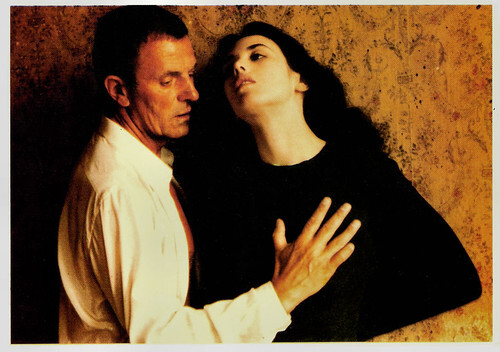
French postcard in the Collection Cinéma Couleur by Editions La Malibran, Paris, no. MC 25. Heinz Bennent and Isabelle Adjani in Possession (Andrzej Zulawski, 1981).
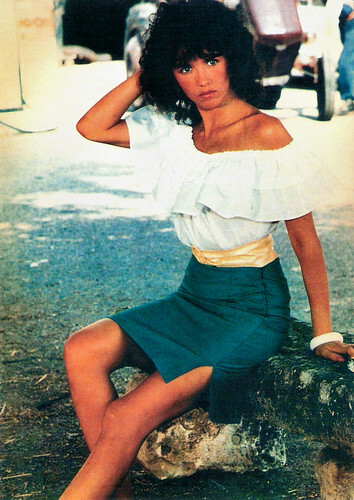
French postcard in the série acteurs by Les Editions GIL, no. 5. Isabelle Adjani in L'Été Meurtrier/One Deadly Summer (Jean Becker, 1983).
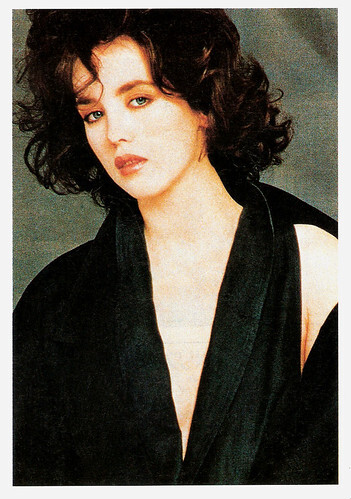
French postcard by Ebullitions, no. 571.
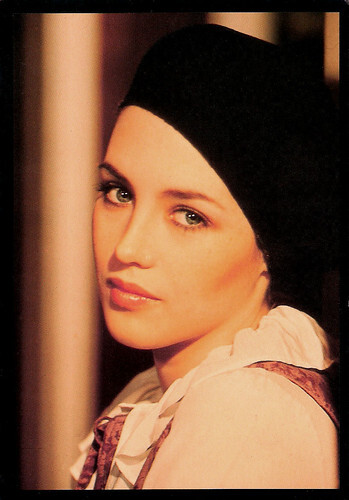
French postcard by Humour a la Carte, Paris, no. ST-158.
The intense, unstable, love-obsessed Adèle Hugo
Isabelle Yasmine Adjani was born in the immigrant neighbourhood Gennevilliers in Hauts-de-Seine, a suburb of Paris, in 1955. Her father, Mohammed Cherif Adjani was Algerian. He was a soldier in the French Army in World War II. Her mother Augusta, called 'Gusti', was German. Isabelle grew up bi-lingual, speaking German and French fluently.
After winning a school recitation contest, she began acting in amateur theatre by the age of twelve. At the age of 14, she starred in her first motion picture Le Petit bougnat/Little Bougnat (Bernard Michel, 1970), while on summer vacation. She made her second film, the coming-of-age drama Faustine et le bel été/Faustine and the Beautiful Summer (Nina Companeez, 1971), also while she was still at school.
In 1972, the 17-year-old joined the prestigious Comédie française as the youngest company member ever. There she gained fame as a classical actress for her interpretation of Agnès, the main female role in Molière's 'L'École des femmes' (The School For Wives). After only two years she left the Comédie française, to pursue a film career. She played minor roles in several films and enjoyed modest success as the spoiled teenage daughter of Lino Ventura in La Gifle/The Slap (Claude Pinoteau, 1974). She won the prestigious Prix Suzanne Bianchetti for Most Promising Actress.
The following year, she landed her first major role as the mentally unbalanced daughter of author Victor Hugo in L Histoire d Adele H./The Story of Adèle H. (François Truffaut, 1975). Critics were enthused over her performance as the intense, unstable, love-obsessed Adèle Hugo. She was nominated for the Best Actress Oscar and received offers for roles in international films. For André Téchiné, she co-starred with Gerard Depardieu in Barocco (1976), as the instigator of a plot to blackmail a politician, and in Les Soeurs Bronte/The Bronte Sisters (1978), as Emily Bronte.
In Roman Polanski's psychological thriller Le Locataire/The Tenant (1976), Adjani was the suicidal former occupant of the apartment rented by a confused man (Polanski himself). In Hollywood, she played a gambler opposite Ryan O’Neal in the crime thriller The Driver (Walter Hill, 1978). She then portrayed Lucy in the Horror film Nosferatu/Nosferatu the Vampyre (Werner Herzog, 1979), a retelling of the Dracula legend featuring Klaus Kinski . In 1980 she had a son, Barnabé Nuytten with Flemish cinematographer Bruno Nuytten.

French postcard by Editions La Malibran, Paris, 1989. no. CF 58. Isabelle Adjani in Les soeurs Brontë/The Brontë Sisters (André Téchiné, 1979).

French postcard by Especially for you, no. 9.

French postcard by Humour à la Carte, Paris, no. 3473. Photo: D.R.
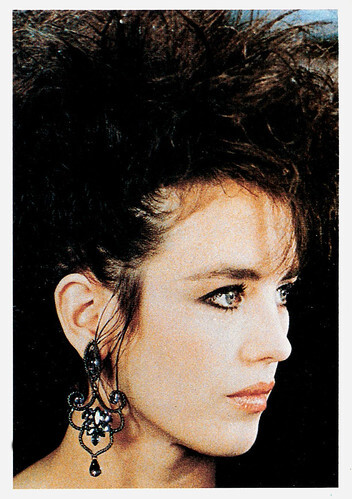
French postcard by Ebullitions, no. 632.
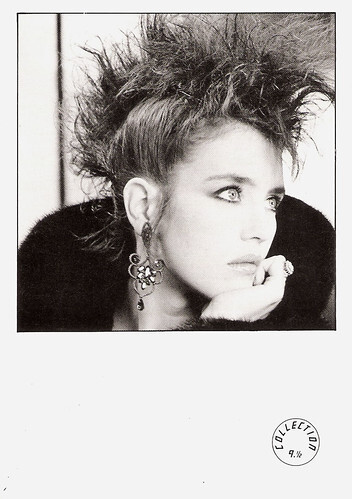
French postcard by Humour à la Carte, Paris, no. ST 73. Photo: D.R.

French postcard in the Collection Cinéma by Star, Neuilly.
Tour de force performance
In 1981, Isabelle Adjani received a double Best Actress Award at the Cannes Film Festival for her part as the impoverished mistress of Alan Bates in Merchant-Ivory's Quartet (James Ivory, 1981), and for her role as the unfaithful wife of Sam Neill, struggling with demons in the Horror film Possession (Andrzej Zulawski, 1981).
Yuri German at AllMovie : “Filmed amidst the oppressive backdrop of the Berlin Wall by the expatriate Polish director Andrzej Zulawski (who was unable to work in his homeland after too many clashes with the authorities), the picture is so relentlessly intense and so deliberately esoteric, that most viewers would find it too hard to connect with. Still, its symbolism, its unbridled and flashy directorial style, and the tour de force performance by Isabelle Adjani earned this unique tale a cult following in Europe.”
The following year, she received her first César Award for Possession. In 1983, she won the César again, now for her depiction of a vengeful woman in the blockbuster L'Été Meurtrier/One Deadly Summer (Jean Becker, 1983). That same year, she released the French pop album 'Pull Marine' written and produced by Serge Gainsbourg . She starred in a music video for the hit title song 'Pull Marine', which was directed by Luc Besson.
For the then 26-year-old Besson, she also starred in the successful comedy thriller Subway (Luc Besson, 1985) opposite Christophe Lambert . From 1986 to 1987, Adjani was romantically linked to actor Warren Beatty with whom she co-starred in the commercial failure Ishtar (Elaine May, 1987).
In 1988, she co-produced and starred in a biopic of the sculptor Camille Claudel (Bruno Nuytten, 1988), the mistress of August Rodin ( Gerard Depardieu ). As she had done in her portrait of Adele Hugo, Adjani fully conveyed the passion and spirit of a strong-willed woman who descends into madness. She received her third César, a second Oscar nomination and a Berlin Film Festival Best Actress Award for this role. Following this publicity, she was chosen by People magazine as one of the '50 Most Beautiful People' in the world.

French postcard in the Signes du Zodiaque series by Editions F. Nugeron, no. 1. Caption: Cancer (22 Juin - 22 Juilliet).
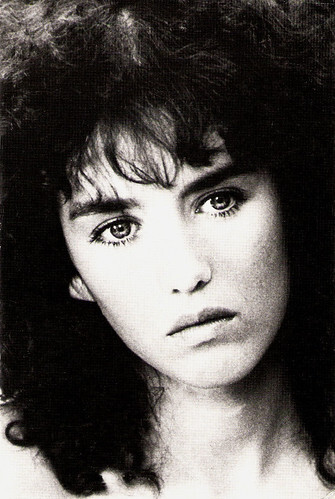
French postcard by Ebullitions, no. 26.
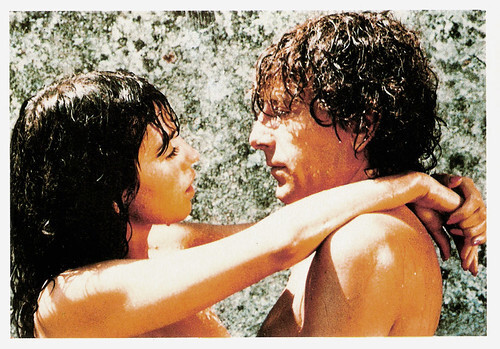
French postcard by Ebullitions, no. 17. Photo: publicity still for L'Été Meurtrier/One Deadly Summer (1983) with Alain Souchon.
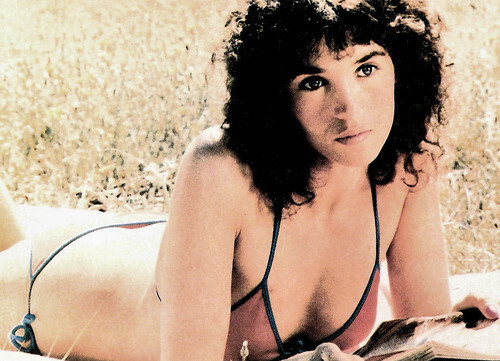
French postcard in the série acteurs by Les Editions Gil, no. 20. Photo: Isabelle Adjani in L'Été Meurtrier/One Deadly Summer (Jean Becker, 1983).
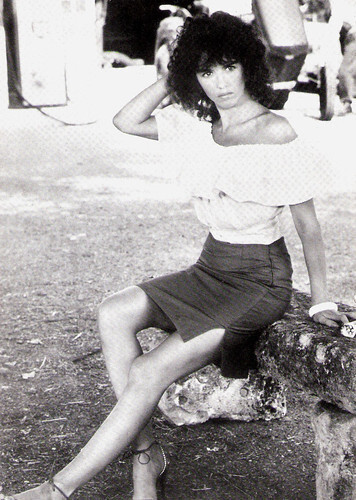
West German postcard by Christa Karten, Berlin, no. 113. Isabelle Adjani in L'Été Meurtrier/One Deadly Summer (Jean Becker, 1983).
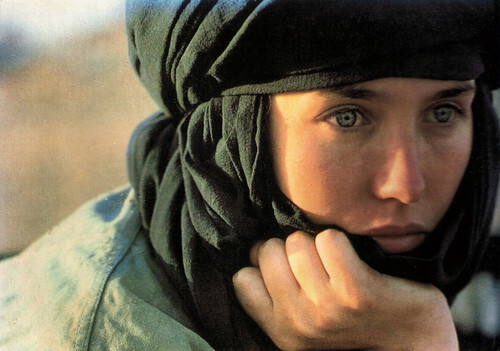
French postcard by Editions F. Nugeron, no. 6. Photo: Collection de l'École de Cinéma Camiris, Lyon. Isabelle Adjani in Ishtar (Elaine May, 1987).
A galaxy of fragile women
Isabelle Adjani won her fourth César for the ensemble epic La Reine Margot/Queen Margot (Patrice Chéreau, 1994), based on Victor Hugo 's novel. The film provided her with another portrayal in her galaxy of fragile women surrounded by violence. She had a relationship with Daniel Day Lewis from 1989 to 1995. He left her during her pregnancy with their son, Gabriel-Kane Day Lewis, who was born in 1995. The following year, she was teamed with Sharon Stone for Diabolique (Jeremiah S. Chechik, 1996), a remake of the classic psychological thriller Les Diaboliques by Henri-Georges Clouzot. Adjani again seemed out of her element as the meek, sickly wife of a belligerent school headmaster (Chazz Palminteri).
Sandra Brennan at AllMovie: “She also continued to be highly visible on the political scene, staunchly supporting Algerian rebel activities and actively fighting racism against North African immigrants (such as her father) in France. She was particularly outspoken concerning the activities of the French National Front. In 1986, the anti-immigration group organised a smear campaign against her, starting rumours that she was dying of AIDS. This actually resulted in newspaper reports of Adjani's death, which caused her to go on national television to prove that she was, in fact, still alive.”
In 2000, she made a rare stage acting appearance in the title role of a Parisian production of La Dame aux Camelias (Camille). After a five-year hiatus, Adjani returned to the screen starring in La Repentie/The Repentent (Laetitia Masson, 2002) with Samy Frey . The following year she appeared in the drama Monsieur Ibrahim et les fleurs du Coran/Monsieur Ibrahim (François Dupeyron, 2003) featuring Omar Sharif, and assumed a role originally meant for Sophie Marceau in the black comedy Bon Voyage (Jean-Paul Rappeneau, 2003). Adjani was engaged to composer Jean Michel Jarre, but they broke up in 2004.
She won her fifth César for her role as a troubled and emotionally fragile woman at the centre of a firestorm in the psychological drama La journée de la jupe/Skirt Day (Jean-Paul Lilienfeld, 2008). In 2009, she denounced statements by Pope Benedict XVI claiming that condoms are not an effective method of AIDS prevention. Adjani was made a Chevalier de la Légion d’honneur in 2010. In the social comedy Mammuth (Benoit Delépine, Gustave de Kervern, 2010) she played the phantom of Gérard Depardieu 's first love. She lent her voice to the character of Mother Gothel in the French language version of the Disney computer-animated film Tangled (Nathan Greno, Byron Howard, 2010), loosely based on the German fairy tale 'Rapunzel' in the collection of folktales published by the Brothers Grimm.
In 2011, Isabelle Adjani co-starred with former soccer player Eric Cantona in the action film De force (Frank Henry, 2011). She embodied the commander Clara Damico, head of the brigade for the repression of banditry. In 2014, she played one of eleven female roles in actress Audrey Dana's choral film Sous les jupes des filles (2014), alongside Laetitia Casta and Vanessa Paradis among others. The film, which she accepted in order to help the director make her first feature film, was a box-office success, attracting over 1,300,000 cinema-goers. Adjani played the title role in the social thriller Carole Matthieu (Louis-Julien Petit, 2016) as a female company doctor who disagrees with the moral harassment and humiliation practised against her employees by the company that employs her. In 2023 Adjani joined the Netflix miniseries Perfect Couple.
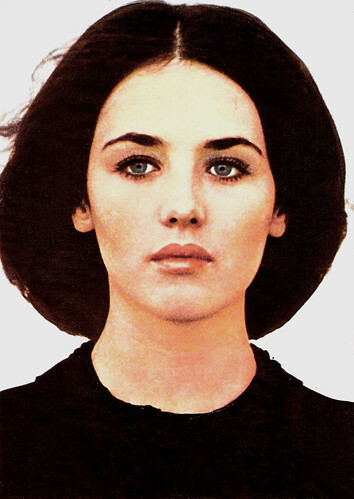
Romanian postcard by Casa Filmului Acin. Isabelle Adjani in L'histoire d'Adèle H. (François Truffaut, 1975).

Romanian postcard by Casa Filmului Acin.
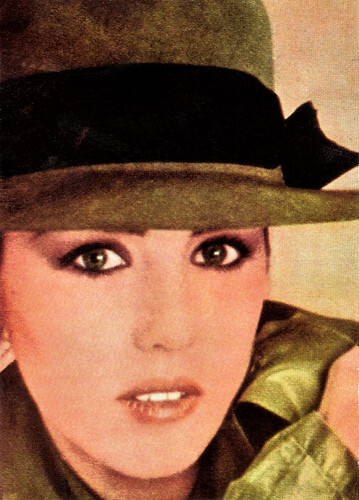
Romanian postcard by Casa Filmului Acin.
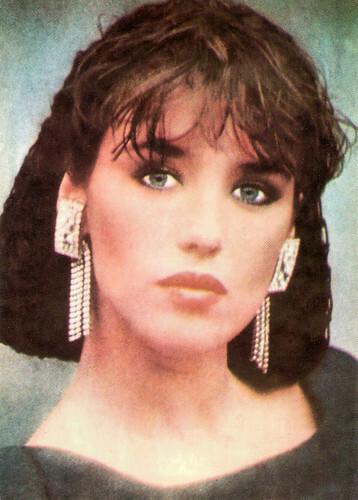
Romanian postcard by Casa Filmului Acin.
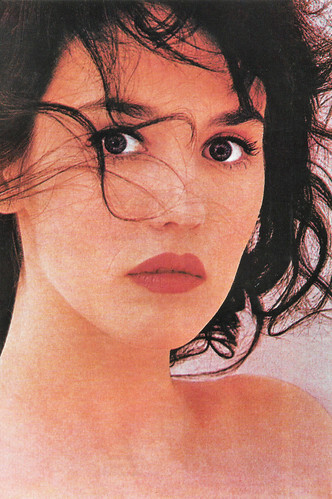
Romanian postcard by InterCONTEMPress. Photo: Isabelle Adjani in Camille Claudel (Bruno Nuytten, 1988).
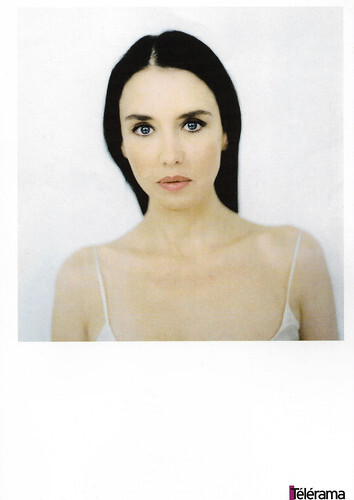
French postcard by Télérama. Photo: Patrick Swircx / Corbis Outline. Caption: Télérama, the French cultural weekly. Every week, Télérama opens its pages to photographers.
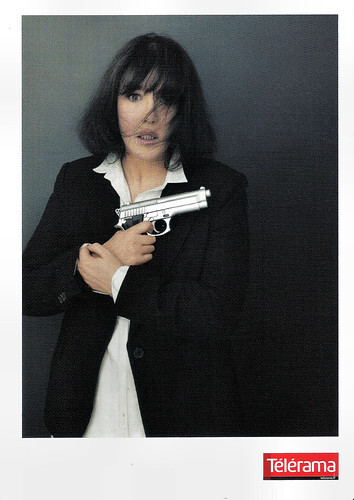
French postcard by Télérama. Photo: Patrick Swirc.
Trailer for Nosferatu/Nosferatu the Vampyre (1979). Source: Danios12345 (YouTube).
Trailer for Possession (1981). Source: TheCultBox (YouTube).
Sources: Yuri German (AllMovie), Sandra Brennan (AllMovie), (IMDb), Yahoo! Movies, Wikipedia and .

French postcard by Editions F. Nugeron, no. 22.

French postcard by Editions La Malibran, Paris, no. CF 43, 1991. Isabelle Adjani and François Truffaut in L'histoire d'Adèle H./The Story of Adèle H. (François Truffaut, 1975).

Romanian postcard by Casa Filmului Acin. Photo: publicity still for Les soeurs Brontë/The Bronte Sisters (André Téchniné, 1979) with Marie-France Pisier as Charlotte Bronte, Isabelle Huppert as Anne Bronte, and Isabelle Adjani as Emily Brontë.

French postcard in the Collection Cinéma Couleur by Editions La Malibran, Paris, no. MC 25. Heinz Bennent and Isabelle Adjani in Possession (Andrzej Zulawski, 1981).

French postcard in the série acteurs by Les Editions GIL, no. 5. Isabelle Adjani in L'Été Meurtrier/One Deadly Summer (Jean Becker, 1983).

French postcard by Ebullitions, no. 571.

French postcard by Humour a la Carte, Paris, no. ST-158.
The intense, unstable, love-obsessed Adèle Hugo
Isabelle Yasmine Adjani was born in the immigrant neighbourhood Gennevilliers in Hauts-de-Seine, a suburb of Paris, in 1955. Her father, Mohammed Cherif Adjani was Algerian. He was a soldier in the French Army in World War II. Her mother Augusta, called 'Gusti', was German. Isabelle grew up bi-lingual, speaking German and French fluently.
After winning a school recitation contest, she began acting in amateur theatre by the age of twelve. At the age of 14, she starred in her first motion picture Le Petit bougnat/Little Bougnat (Bernard Michel, 1970), while on summer vacation. She made her second film, the coming-of-age drama Faustine et le bel été/Faustine and the Beautiful Summer (Nina Companeez, 1971), also while she was still at school.
In 1972, the 17-year-old joined the prestigious Comédie française as the youngest company member ever. There she gained fame as a classical actress for her interpretation of Agnès, the main female role in Molière's 'L'École des femmes' (The School For Wives). After only two years she left the Comédie française, to pursue a film career. She played minor roles in several films and enjoyed modest success as the spoiled teenage daughter of Lino Ventura in La Gifle/The Slap (Claude Pinoteau, 1974). She won the prestigious Prix Suzanne Bianchetti for Most Promising Actress.
The following year, she landed her first major role as the mentally unbalanced daughter of author Victor Hugo in L Histoire d Adele H./The Story of Adèle H. (François Truffaut, 1975). Critics were enthused over her performance as the intense, unstable, love-obsessed Adèle Hugo. She was nominated for the Best Actress Oscar and received offers for roles in international films. For André Téchiné, she co-starred with Gerard Depardieu in Barocco (1976), as the instigator of a plot to blackmail a politician, and in Les Soeurs Bronte/The Bronte Sisters (1978), as Emily Bronte.
In Roman Polanski's psychological thriller Le Locataire/The Tenant (1976), Adjani was the suicidal former occupant of the apartment rented by a confused man (Polanski himself). In Hollywood, she played a gambler opposite Ryan O’Neal in the crime thriller The Driver (Walter Hill, 1978). She then portrayed Lucy in the Horror film Nosferatu/Nosferatu the Vampyre (Werner Herzog, 1979), a retelling of the Dracula legend featuring Klaus Kinski . In 1980 she had a son, Barnabé Nuytten with Flemish cinematographer Bruno Nuytten.

French postcard by Editions La Malibran, Paris, 1989. no. CF 58. Isabelle Adjani in Les soeurs Brontë/The Brontë Sisters (André Téchiné, 1979).

French postcard by Especially for you, no. 9.

French postcard by Humour à la Carte, Paris, no. 3473. Photo: D.R.

French postcard by Ebullitions, no. 632.

French postcard by Humour à la Carte, Paris, no. ST 73. Photo: D.R.

French postcard in the Collection Cinéma by Star, Neuilly.
Tour de force performance
In 1981, Isabelle Adjani received a double Best Actress Award at the Cannes Film Festival for her part as the impoverished mistress of Alan Bates in Merchant-Ivory's Quartet (James Ivory, 1981), and for her role as the unfaithful wife of Sam Neill, struggling with demons in the Horror film Possession (Andrzej Zulawski, 1981).
Yuri German at AllMovie : “Filmed amidst the oppressive backdrop of the Berlin Wall by the expatriate Polish director Andrzej Zulawski (who was unable to work in his homeland after too many clashes with the authorities), the picture is so relentlessly intense and so deliberately esoteric, that most viewers would find it too hard to connect with. Still, its symbolism, its unbridled and flashy directorial style, and the tour de force performance by Isabelle Adjani earned this unique tale a cult following in Europe.”
The following year, she received her first César Award for Possession. In 1983, she won the César again, now for her depiction of a vengeful woman in the blockbuster L'Été Meurtrier/One Deadly Summer (Jean Becker, 1983). That same year, she released the French pop album 'Pull Marine' written and produced by Serge Gainsbourg . She starred in a music video for the hit title song 'Pull Marine', which was directed by Luc Besson.
For the then 26-year-old Besson, she also starred in the successful comedy thriller Subway (Luc Besson, 1985) opposite Christophe Lambert . From 1986 to 1987, Adjani was romantically linked to actor Warren Beatty with whom she co-starred in the commercial failure Ishtar (Elaine May, 1987).
In 1988, she co-produced and starred in a biopic of the sculptor Camille Claudel (Bruno Nuytten, 1988), the mistress of August Rodin ( Gerard Depardieu ). As she had done in her portrait of Adele Hugo, Adjani fully conveyed the passion and spirit of a strong-willed woman who descends into madness. She received her third César, a second Oscar nomination and a Berlin Film Festival Best Actress Award for this role. Following this publicity, she was chosen by People magazine as one of the '50 Most Beautiful People' in the world.

French postcard in the Signes du Zodiaque series by Editions F. Nugeron, no. 1. Caption: Cancer (22 Juin - 22 Juilliet).

French postcard by Ebullitions, no. 26.

French postcard by Ebullitions, no. 17. Photo: publicity still for L'Été Meurtrier/One Deadly Summer (1983) with Alain Souchon.

French postcard in the série acteurs by Les Editions Gil, no. 20. Photo: Isabelle Adjani in L'Été Meurtrier/One Deadly Summer (Jean Becker, 1983).

West German postcard by Christa Karten, Berlin, no. 113. Isabelle Adjani in L'Été Meurtrier/One Deadly Summer (Jean Becker, 1983).

French postcard by Editions F. Nugeron, no. 6. Photo: Collection de l'École de Cinéma Camiris, Lyon. Isabelle Adjani in Ishtar (Elaine May, 1987).
A galaxy of fragile women
Isabelle Adjani won her fourth César for the ensemble epic La Reine Margot/Queen Margot (Patrice Chéreau, 1994), based on Victor Hugo 's novel. The film provided her with another portrayal in her galaxy of fragile women surrounded by violence. She had a relationship with Daniel Day Lewis from 1989 to 1995. He left her during her pregnancy with their son, Gabriel-Kane Day Lewis, who was born in 1995. The following year, she was teamed with Sharon Stone for Diabolique (Jeremiah S. Chechik, 1996), a remake of the classic psychological thriller Les Diaboliques by Henri-Georges Clouzot. Adjani again seemed out of her element as the meek, sickly wife of a belligerent school headmaster (Chazz Palminteri).
Sandra Brennan at AllMovie: “She also continued to be highly visible on the political scene, staunchly supporting Algerian rebel activities and actively fighting racism against North African immigrants (such as her father) in France. She was particularly outspoken concerning the activities of the French National Front. In 1986, the anti-immigration group organised a smear campaign against her, starting rumours that she was dying of AIDS. This actually resulted in newspaper reports of Adjani's death, which caused her to go on national television to prove that she was, in fact, still alive.”
In 2000, she made a rare stage acting appearance in the title role of a Parisian production of La Dame aux Camelias (Camille). After a five-year hiatus, Adjani returned to the screen starring in La Repentie/The Repentent (Laetitia Masson, 2002) with Samy Frey . The following year she appeared in the drama Monsieur Ibrahim et les fleurs du Coran/Monsieur Ibrahim (François Dupeyron, 2003) featuring Omar Sharif, and assumed a role originally meant for Sophie Marceau in the black comedy Bon Voyage (Jean-Paul Rappeneau, 2003). Adjani was engaged to composer Jean Michel Jarre, but they broke up in 2004.
She won her fifth César for her role as a troubled and emotionally fragile woman at the centre of a firestorm in the psychological drama La journée de la jupe/Skirt Day (Jean-Paul Lilienfeld, 2008). In 2009, she denounced statements by Pope Benedict XVI claiming that condoms are not an effective method of AIDS prevention. Adjani was made a Chevalier de la Légion d’honneur in 2010. In the social comedy Mammuth (Benoit Delépine, Gustave de Kervern, 2010) she played the phantom of Gérard Depardieu 's first love. She lent her voice to the character of Mother Gothel in the French language version of the Disney computer-animated film Tangled (Nathan Greno, Byron Howard, 2010), loosely based on the German fairy tale 'Rapunzel' in the collection of folktales published by the Brothers Grimm.
In 2011, Isabelle Adjani co-starred with former soccer player Eric Cantona in the action film De force (Frank Henry, 2011). She embodied the commander Clara Damico, head of the brigade for the repression of banditry. In 2014, she played one of eleven female roles in actress Audrey Dana's choral film Sous les jupes des filles (2014), alongside Laetitia Casta and Vanessa Paradis among others. The film, which she accepted in order to help the director make her first feature film, was a box-office success, attracting over 1,300,000 cinema-goers. Adjani played the title role in the social thriller Carole Matthieu (Louis-Julien Petit, 2016) as a female company doctor who disagrees with the moral harassment and humiliation practised against her employees by the company that employs her. In 2023 Adjani joined the Netflix miniseries Perfect Couple.

Romanian postcard by Casa Filmului Acin. Isabelle Adjani in L'histoire d'Adèle H. (François Truffaut, 1975).

Romanian postcard by Casa Filmului Acin.

Romanian postcard by Casa Filmului Acin.

Romanian postcard by Casa Filmului Acin.

Romanian postcard by InterCONTEMPress. Photo: Isabelle Adjani in Camille Claudel (Bruno Nuytten, 1988).

French postcard by Télérama. Photo: Patrick Swircx / Corbis Outline. Caption: Télérama, the French cultural weekly. Every week, Télérama opens its pages to photographers.

French postcard by Télérama. Photo: Patrick Swirc.
Trailer for Nosferatu/Nosferatu the Vampyre (1979). Source: Danios12345 (YouTube).
Trailer for Possession (1981). Source: TheCultBox (YouTube).
Sources: Yuri German (AllMovie), Sandra Brennan (AllMovie), (IMDb), Yahoo! Movies, Wikipedia and .
Published on September 03, 2023 22:00
September 2, 2023
Marisa Allasio
Marisa Allasio (1936) was a glamorous starlet who appeared in nearly twenty pictures in the 1950s. She was nicknamed ‘The Italian Jayne Mansfield’. In 1958 her career stopped abruptly when she married and became a countess.

Italian postcard by Rotalcolor, no. 1.
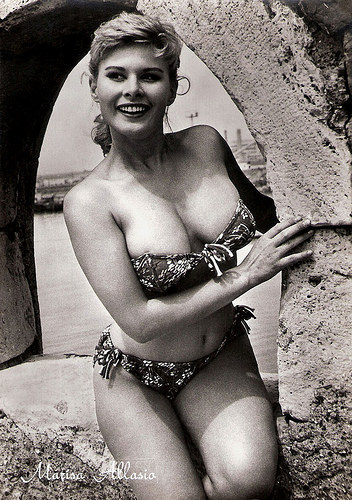
Italian postcard by Rotalfoto, no. 714.
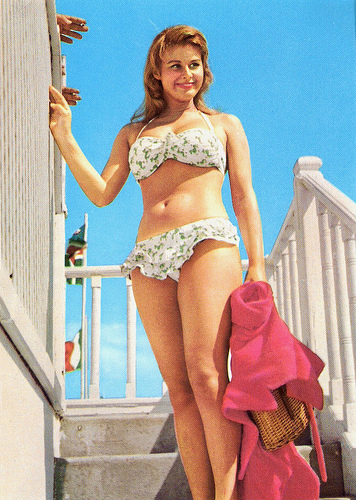
Italian postcard by Rotalfoto, no. R. 107.
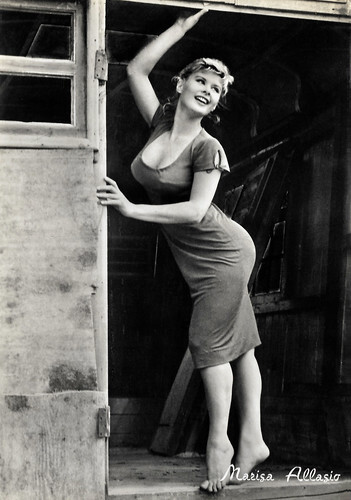
Italian postcard by S.A. Poligrafica Sammerinese, no. 019-d.
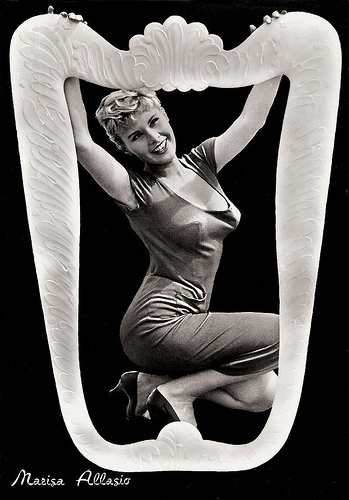
Italian postcard by SA Poligrafica Sammarinese, no. 020-d.
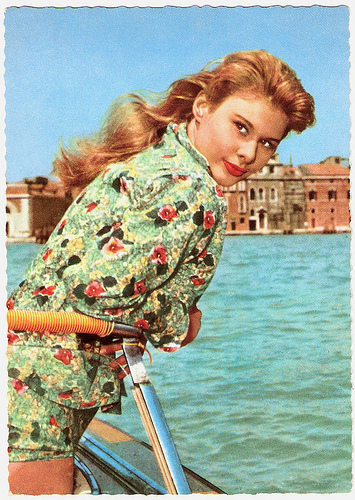
German postcard by Universum-Film Aktiengesellschaft (UFA), Berlin-Tempelhof, no. CK-174. Retail price: 30 Pfg. Photo: G.B. Poletto / UFA.
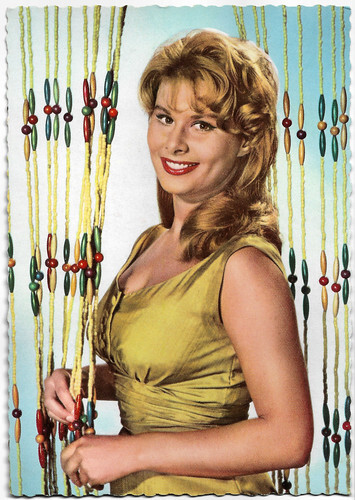
West German postcard by Universum-Film Aktiengesellschaft (UFA), Berlin-Tempelhof, no. CK-236. Photo: Klaus Collignon.
Miss Lido
Marisa Allasio was born Maria Luisa Lucia Allasio in Turin in 1936. She was the daughter of Federico Allasio, road contractor, goalkeeper of the Torino soccer team and coach of many Italian soccer teams, and his wife Lucia Rocchietti.
At 14, she was crowned Miss Lido, winning her first and only beauty contest. When Italian magazines published the pin-up art of 'Miss Lido,' she was transferred to a public school.
At 16, Marisa made her film debut in a bit part in the melodrama Perdonami!/Forgive me (Mario Costa, 1952) starring Raf Vallone and Antonella Lualdi. She talked her parents into enrolling her in Rome’s Academy of Dramatic Arts.
In the following years, she appeared in Italian film productions like the soccer film Gli eroi della domenica/The Sunday Heroes (Mario Camerini, 1953) starring Raf Vallone and Marcello Mastroianni, Cuore di mamma/Mother's Heart (Luigi Capuano, 1954), and Ragazze d'oggi/Girls of Today (Luigi Zampa, 1955).
She also had an uncredited part in the international epic War and Peace (King Vidor, 1956) based on the famous novel by Leo Tolstoy and starring Audrey Hepburn , Henry Fonda and Mel Ferrer.
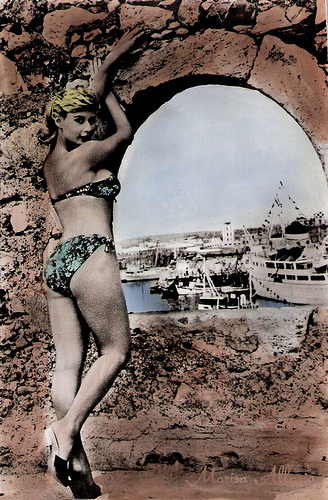
Yugoslavian postcard.
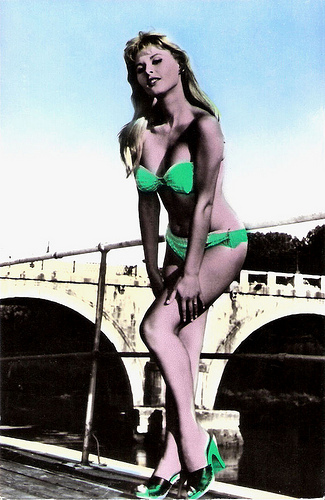
Yugoslavian postcard by Studio Sombor, no. 213.
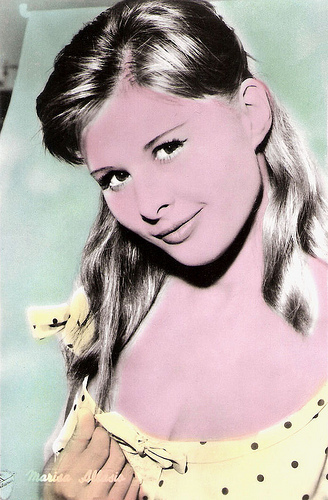
Yugoslavian postcard by Studio Sombor, no. 300.

Italian postcard. Publicity still for Ragazze d'oggi/Girls of Today (Luigi Zampa, 1955) with Mike Bongiorno .
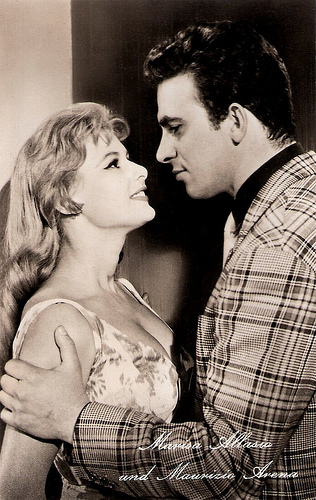
With Maurizio Arena . East-German postcard by VEB Progress Film-Vertrieb, Berlin, no. 1355, 1960. Retail price: 0,20 DM. Photo: Progress.
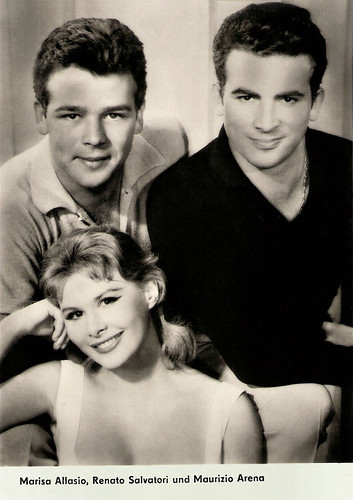
East-German postcard by VEB Progress Film-Vertrieb, Berlin, no. 1356, 1961. Retail price: 0,20 DM. Photo: Progress. Publicity still for Poveri ma belli/Poor But Beautiful (Dino Risi, 1957) with Renato Salvatori and Maurizio Arena .
Bikini girl
Marisa Allasio had her breakthrough as Giovanna in the comedy Poveri ma belli/Poor But Beautiful (Dino Risi, 1956) opposite Renato Salvatori and Maurizio Arena and the sequel Belle ma povere/Poor Girl, Pretty Girl (Dino Risi, 1957). Her part wins her national notoriety when the Pope condemns posters advertising it as 'overly exciting.' The posters are seized by Italian police. Despite this scandal, she became popular as ‘la ragazza bella’, with her amazing curves clad in a bikini.
She appeared as the main attraction in comedies like Marisa la civetta/Marisa (Mauro Bolognini, 1957) again with Renato Salvatori , Camping (Franco Zeffirelli, 1957), Susanna tutta panna/Susanna, you whipped cream (Steno, 1957), and Venezia, la luna e tu/Venice, the Moon and You (Dino Risi, 1958) with Alberto Sordi .
As a pin-up, she became hugely popular. In 1957 she was on the cover of Modern Man Quarterly Fall 1957, and an international breakthrough seemed only a matter of time. She appeared in the German-Italian coproduction Nackt, wie Gott sie schuf/Naked Like God Created Her (Hans Schott-Schöbinger, 1958), and the American-Italian Mario Lanza vehicle Seven Hills of Rome (Roy Rowland, 1958). But that would be her final film.
In 1958 she married Conte Pierfrancesco Calvi. Her husband is the 7th count of Bèrgolo, Head of the Calvi di Bèrgolo Family, since 1977. His mother was a daughter of H.R.M. Vittorio Emanuele III, King of Italy, King of Albania and Emperor of Ethiopia, and H.R.H. Elena Petrovich-Njegosch, Princess of Montenegro. He was 27; she was 22. The private ceremony was attended by only two other persons. Both families were reported opposed to the marriage.
Today the count and his wife are still married and have two children, Carlo Georgio (1959), and Anda Federica a.k.a. Yolanda (1962). The Italian New Wave group Diaframma dedicated a song to her, called Marisa Allasio. It’s on their album '3 Volte Lacrime' (1986).
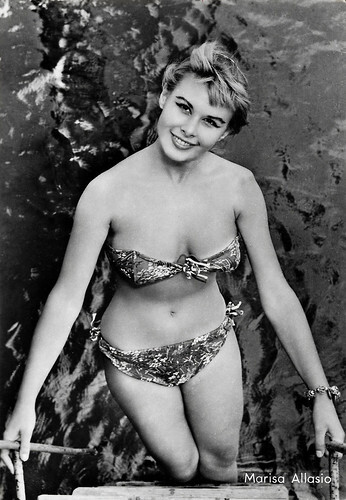
Italian postcard by Bromofoto, Milano, no. 153.
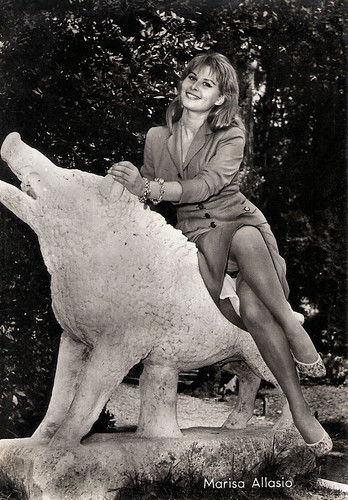
Italian postcard by Bromostampa, Milano, no. 166.
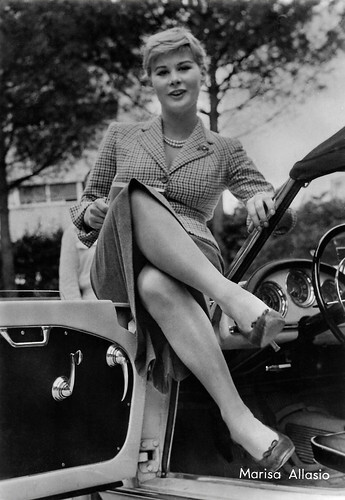
Italian postcard by Bromofoto, Milano, no. 224.
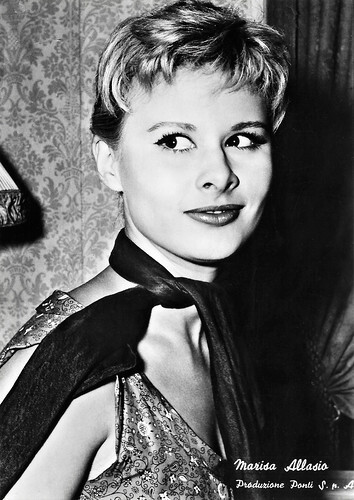
Italian postcard by Bromofoto, Milano, no. 1821. Photo: Produzione Ponti S.p.A.
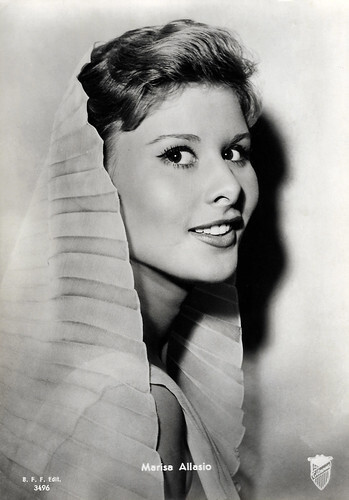
Italian postcard by B.F.F. Edit. (Casa Editr. Ballerini & Fratini, Firenze), no. 3496. Photo: Titanus / M.G.M. Marisa Allasio in Arrivederci Roma/Seven Hills of Rome (Roy Rowland, 1958).
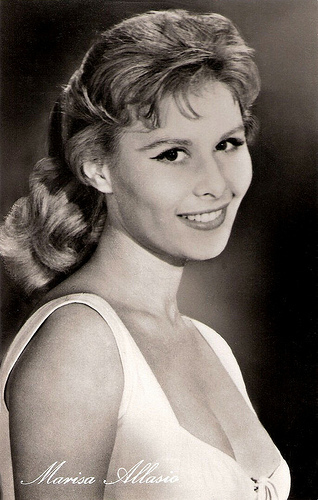
East-German postcard by VEB Progress Film-Vertrieb, Berlin, no. 1354, 1960. Retail price: 0,20 DM. Photo: Progress.
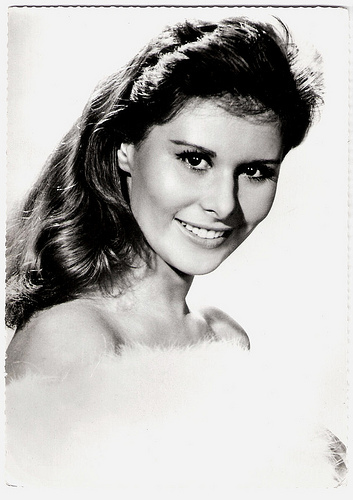
Yugoslavian postcard by 3K, no. 3918.
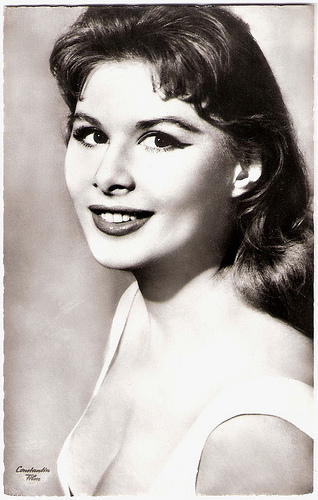
German postcard by Kolibri-Verlag G.m.b.H., Minden/Westf., no. 144. Photo: Titanus / Constantin.
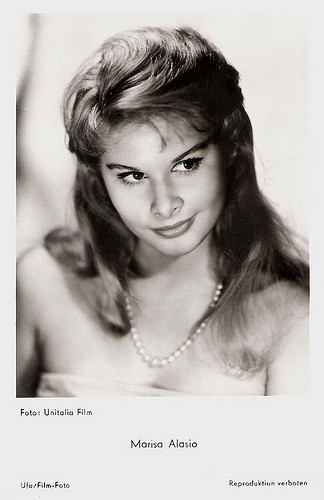
German postcard by Ufa, Berlin-Tempelhof, no. FK 4182. Photo: Unitalia Film.

German postcard by Universum-Film Aktiengesellschaft (Ufa), Berlin-Tempelhof, no. PK 3914. Retail price: 25 Pfg. Photo: G. Poletto / Ufa. (The name of the actress is misspelt on the postcard).
Sources: Glamour Girls of the Silver Screen, Wikipedia (Italian) and .

Italian postcard by Rotalcolor, no. 1.

Italian postcard by Rotalfoto, no. 714.

Italian postcard by Rotalfoto, no. R. 107.

Italian postcard by S.A. Poligrafica Sammerinese, no. 019-d.

Italian postcard by SA Poligrafica Sammarinese, no. 020-d.

German postcard by Universum-Film Aktiengesellschaft (UFA), Berlin-Tempelhof, no. CK-174. Retail price: 30 Pfg. Photo: G.B. Poletto / UFA.

West German postcard by Universum-Film Aktiengesellschaft (UFA), Berlin-Tempelhof, no. CK-236. Photo: Klaus Collignon.
Miss Lido
Marisa Allasio was born Maria Luisa Lucia Allasio in Turin in 1936. She was the daughter of Federico Allasio, road contractor, goalkeeper of the Torino soccer team and coach of many Italian soccer teams, and his wife Lucia Rocchietti.
At 14, she was crowned Miss Lido, winning her first and only beauty contest. When Italian magazines published the pin-up art of 'Miss Lido,' she was transferred to a public school.
At 16, Marisa made her film debut in a bit part in the melodrama Perdonami!/Forgive me (Mario Costa, 1952) starring Raf Vallone and Antonella Lualdi. She talked her parents into enrolling her in Rome’s Academy of Dramatic Arts.
In the following years, she appeared in Italian film productions like the soccer film Gli eroi della domenica/The Sunday Heroes (Mario Camerini, 1953) starring Raf Vallone and Marcello Mastroianni, Cuore di mamma/Mother's Heart (Luigi Capuano, 1954), and Ragazze d'oggi/Girls of Today (Luigi Zampa, 1955).
She also had an uncredited part in the international epic War and Peace (King Vidor, 1956) based on the famous novel by Leo Tolstoy and starring Audrey Hepburn , Henry Fonda and Mel Ferrer.

Yugoslavian postcard.

Yugoslavian postcard by Studio Sombor, no. 213.

Yugoslavian postcard by Studio Sombor, no. 300.

Italian postcard. Publicity still for Ragazze d'oggi/Girls of Today (Luigi Zampa, 1955) with Mike Bongiorno .

With Maurizio Arena . East-German postcard by VEB Progress Film-Vertrieb, Berlin, no. 1355, 1960. Retail price: 0,20 DM. Photo: Progress.

East-German postcard by VEB Progress Film-Vertrieb, Berlin, no. 1356, 1961. Retail price: 0,20 DM. Photo: Progress. Publicity still for Poveri ma belli/Poor But Beautiful (Dino Risi, 1957) with Renato Salvatori and Maurizio Arena .
Bikini girl
Marisa Allasio had her breakthrough as Giovanna in the comedy Poveri ma belli/Poor But Beautiful (Dino Risi, 1956) opposite Renato Salvatori and Maurizio Arena and the sequel Belle ma povere/Poor Girl, Pretty Girl (Dino Risi, 1957). Her part wins her national notoriety when the Pope condemns posters advertising it as 'overly exciting.' The posters are seized by Italian police. Despite this scandal, she became popular as ‘la ragazza bella’, with her amazing curves clad in a bikini.
She appeared as the main attraction in comedies like Marisa la civetta/Marisa (Mauro Bolognini, 1957) again with Renato Salvatori , Camping (Franco Zeffirelli, 1957), Susanna tutta panna/Susanna, you whipped cream (Steno, 1957), and Venezia, la luna e tu/Venice, the Moon and You (Dino Risi, 1958) with Alberto Sordi .
As a pin-up, she became hugely popular. In 1957 she was on the cover of Modern Man Quarterly Fall 1957, and an international breakthrough seemed only a matter of time. She appeared in the German-Italian coproduction Nackt, wie Gott sie schuf/Naked Like God Created Her (Hans Schott-Schöbinger, 1958), and the American-Italian Mario Lanza vehicle Seven Hills of Rome (Roy Rowland, 1958). But that would be her final film.
In 1958 she married Conte Pierfrancesco Calvi. Her husband is the 7th count of Bèrgolo, Head of the Calvi di Bèrgolo Family, since 1977. His mother was a daughter of H.R.M. Vittorio Emanuele III, King of Italy, King of Albania and Emperor of Ethiopia, and H.R.H. Elena Petrovich-Njegosch, Princess of Montenegro. He was 27; she was 22. The private ceremony was attended by only two other persons. Both families were reported opposed to the marriage.
Today the count and his wife are still married and have two children, Carlo Georgio (1959), and Anda Federica a.k.a. Yolanda (1962). The Italian New Wave group Diaframma dedicated a song to her, called Marisa Allasio. It’s on their album '3 Volte Lacrime' (1986).

Italian postcard by Bromofoto, Milano, no. 153.

Italian postcard by Bromostampa, Milano, no. 166.

Italian postcard by Bromofoto, Milano, no. 224.

Italian postcard by Bromofoto, Milano, no. 1821. Photo: Produzione Ponti S.p.A.

Italian postcard by B.F.F. Edit. (Casa Editr. Ballerini & Fratini, Firenze), no. 3496. Photo: Titanus / M.G.M. Marisa Allasio in Arrivederci Roma/Seven Hills of Rome (Roy Rowland, 1958).

East-German postcard by VEB Progress Film-Vertrieb, Berlin, no. 1354, 1960. Retail price: 0,20 DM. Photo: Progress.

Yugoslavian postcard by 3K, no. 3918.

German postcard by Kolibri-Verlag G.m.b.H., Minden/Westf., no. 144. Photo: Titanus / Constantin.

German postcard by Ufa, Berlin-Tempelhof, no. FK 4182. Photo: Unitalia Film.

German postcard by Universum-Film Aktiengesellschaft (Ufa), Berlin-Tempelhof, no. PK 3914. Retail price: 25 Pfg. Photo: G. Poletto / Ufa. (The name of the actress is misspelt on the postcard).
Sources: Glamour Girls of the Silver Screen, Wikipedia (Italian) and .
Published on September 02, 2023 22:00
September 1, 2023
Zorro
In Los Angeles in 1821, Don Diego de la Vega opposes the corrupt tyrants of Spanish California as Zorro, Spanish for 'fox'. The masked swordsman was created in 1919 by American pulp writer Johnston McCulley. His black costume includes a cape, a hat known as a sombrero cordobés, and a mask covering the upper half of his face. Zorro is an acrobat and an expert in various weapons, but the one he employs most frequently is his rapier. He often uses his rapier to carve the initial 'Z' on his defeated foes, and other objects to 'sign his work'. He is also an accomplished rider, his trusty steed being a black horse called 'Tornado'. The character has been featured in many films and in a classic TV series.
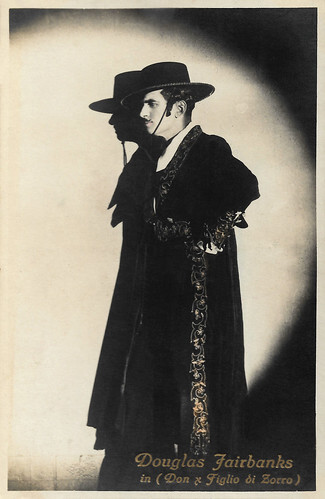
Italian postcard by G.B. Falci, Editore, Milano, no. 452. Douglas Fairbanks in Don Q Son of Zorro (Donald Crisp, 1925).
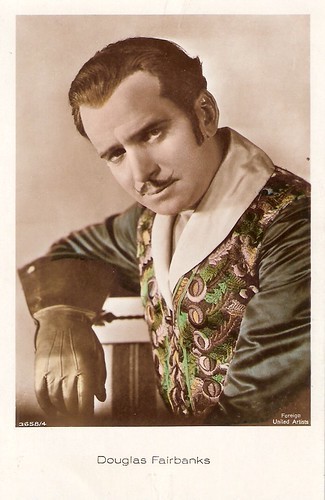
German postcard by Ross Verlag Foreign, no. 3658/4, 1928-1929. Photo: United Artists. Douglas Fairbanks is wearing the outfit from Don Q, Son of Zorro (Donald Crisp, 1925).
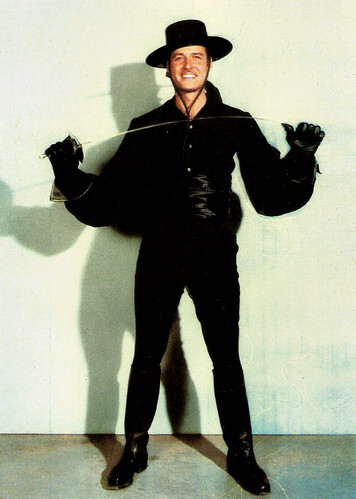
French postcard by Les Presses de Belville, Paris. Photo: Walt Disney Productions, 1964. Guy Williams in the TV series Zorro (1957-1959).
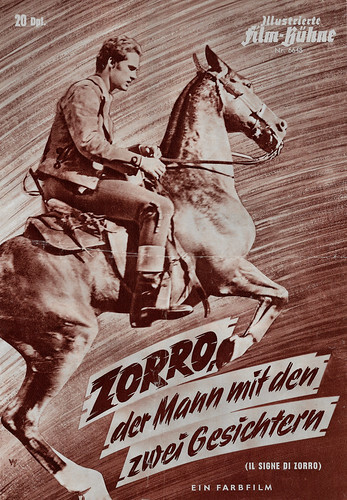
West German flyer by Illustrierte Film-Bühne, no. 6648. Sean Flynn in Il segno di Zorro/Sign of Zorro (Mario Caiano, 1963). The German title was Zorro, der Mann mit den zwei Gesichten.
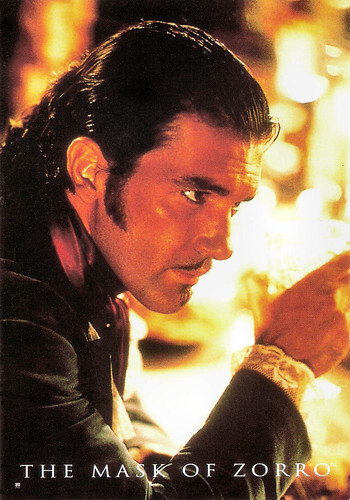
French postcard by Sonis, no. C. 899. Photo: Zorro Productions / Tristar Pictures. Antonio Banderas in The Mask of Zorro (Martin Campbell, 1998).

Taiwanese postcard by Cool Card. Image: film poster of Antonio Banderas and Catherine Zeta-Jones in The Legend of Zorro (Martin Campbell, 2005).
A genre-defining swashbuckler adventure
Zorro debuted in Johnston McCulley's novel 'The Curse of Capistrano', serialized in five parts between 9 August and 6 September 1919, in the pulp magazine All-Story Weekly. The story was originally meant as a standalone tale, and at the denouement, Zorro's true identity is revealed to all. Zorro is the secret identity of Don Diego de la Vega.
In McCulley's story, Zorro has a high bounty on his head but is too skilled and cunning for the bumbling authorities to catch, and he also delights in publicly humiliating them. Because of this, the townspeople started calling him "El Zorro" due to his fox-like cunning and charm. He is a former university student, newly recalled by his father, Don Alejandro de la Vega, from Madrid to his home outside El Pueblo de Nuestra Señora Reina de los Angeles sobre El Rio Porciuncula, later shortened to Los Angeles.
Then the town was still part of Mexican California (1821–1848), after its independence from Spain. The dashing black-clad masked outlaw defends the people of the land against tyrannical officials and other villains. Not only is he too cunning and fox-like for the bumbling authorities to catch, but he delights in publicly humiliating them. McCulley did not intend to write further stories about Zorro, but the new medium film changed things.
The following year, American actor Douglas Fairbanks had the inspiration of staging a new type of adventure costume picture, a genre that was then out of favour with the public. Fairbanks had been a comic in his previous films. On their honeymoon, Fairbanks and Mary Pickford selected 'The Curse of Capistrano' as the inaugural picture for their new studio, United Artists, beginning the character's cinematic tradition. In his film The Mark of Zorro (Fred Niblo, 1920), Fairbanks combined his appealing screen persona with the new adventurous costume element. This genre-defining Swashbuckler adventure was the first film version of Zorro.
The Mark of Zorro was a smash success and parlayed Douglas Fairbanks into the rank of superstar. Due to its success, McCulley's novel was republished, also titled 'The Mark of Zorro'. In response to public demand fueled by the film, McCulley wrote more than sixty more Zorro stories, beginning in 1922 with 'The Further Adventures of Zorro', which was also serialized in Argosy All-Story Weekly. For the remainder of his career in silent films, Douglas Fairbanks continued to produce and star in ever more elaborate, impressive costume films, such as The Three Musketeers (Fred Niblo, 1921), Robin Hood (Allan Dwan, 1922) and The Thief of Bagdad (Raoul Walsh, 1924). And in 1925, Douglas Fairbanks made a Zorro sequel, Don Q Son of Zorro (Donald Crisp, 1925).
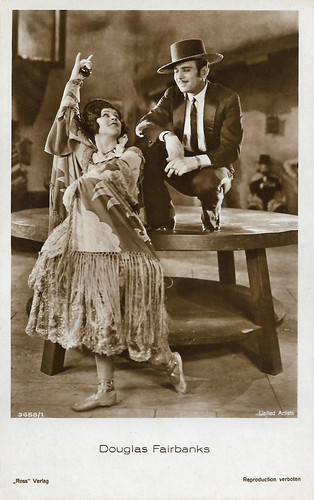
German postcard by Ross Verlag, no. 3658/1, 1928-1929. Photo: United Artists. Douglas Fairbanks and Juliette Belanger in Don Q Son of Zorro (Donald Crisp, 1925).
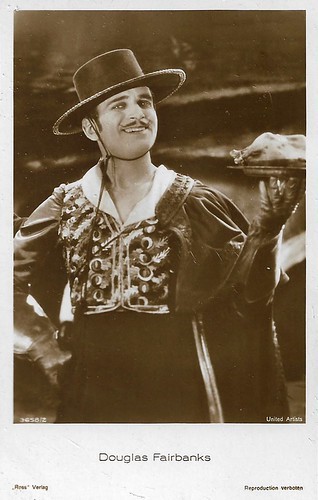
German postcard by Ross Verlag, no. 3658/2, 1928-1929. Photo: United Artists. Douglas Fairbanks in Don Q, Son of Zorro (Donald Crisp, 1925).
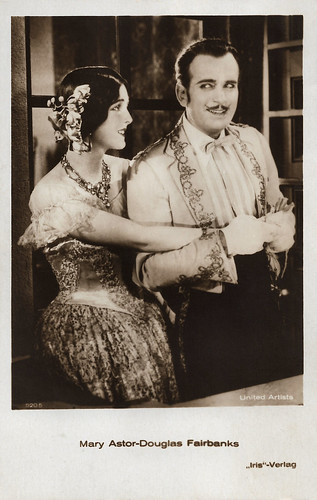
Austrian postcard by Iris Verlag, no. 5205. Photo: United Artists. Mary Astor and Douglas Fairbanks in Don Q Son of Zorro (Donald Crisp, 1925).
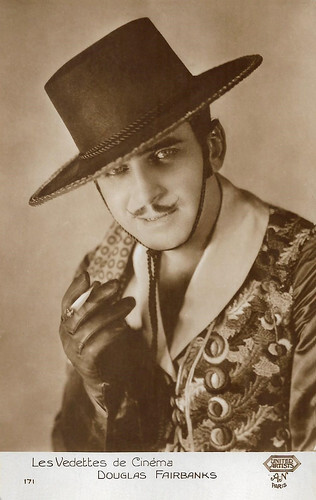
French postcard by A.N., Paris, in the Les Vedettes du Cinéma series, no. 171. Photo: United Artists. Douglas Fairbanks in Don Q, Son of Zorro (Donald Crisp, 1925).
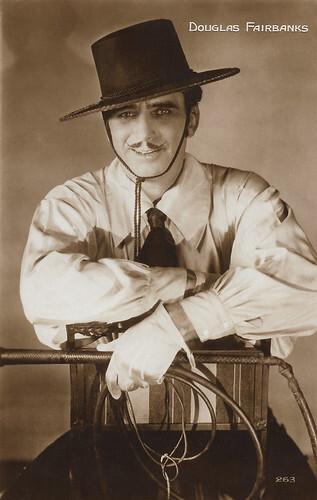
French postcard by Editions Cinémagazine, no. 263. Photo: Fairbanks in his outfit for Don Q Son of Zorro (Donald Crisp, 1925).
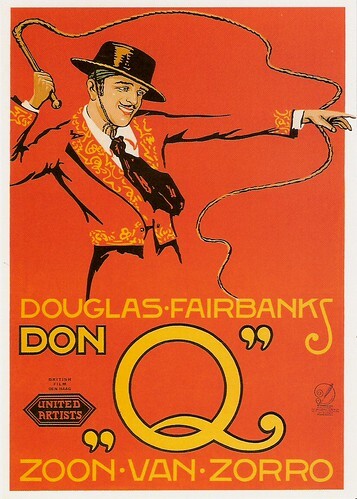
Dutch poster by Frans Bosen for Don Q Son of Zorro (Donald Crisp, 1925) starring Douglas Fairbanks .
Foppish dandy by day and masked swordsman by night
In the 1930s and 1940s, Johnston McCulley wrote dozens more Zorro stories for various magazines, including Argosy and West. Several film versions were made during this period including The Bold Caballero (Wells Root, 1936) starring Robert Livingstone and the Republic serials Zorro Rides Again (William Witney, John English, 1937) with John Carroll and Zorro's Fighting Legion (William Witney, John English, 1939) with Reed Hadley. The best-known film version was The Mark of Zorro (Rouben Mamoulian, 1940) starring Tyrone Power .
Walt Disney produced a now classic American half-hour television series Zorro , which ran from October 1957 to June 1959, with a total of 78 episodes. Guy Williams is Don Diego who plays the foppish dandy by day and the masked swordsman Zorro who slashes 'Z's everywhere by night. His horses (black and white) are Tornado and Phantom. Although the series was very popular, especially with a young audience, it had to be discontinued after its second season. This was due to a financial disagreement between Disney and the network that broadcast the series. Author McCulley died in 1958, just as Zorro was at the height of his popularity thanks to the Disney series.
Disney also released two feature films with Guy Williams, The Sign of Zorro (Lewis R. Foster, Norman Foster, 1958) and Zorro, the Avenger (Charles Barton, 1959) which were episode compilations. There were also four one-hour follow-ups on the Walt Disney anthology television series in the 1960–1961 TV season. During the 1960s various Zorro films were produced in Spain and Italy. These included La venganza del Zorro/Zorro the Avenger (Joaquín Luis Romero Marchent, 1962) with Frank Latimore, Il segno di Zorro/Duel at the Rio Grande (Mario Caiano, 1963) with Sean Flynn, Zorro e i tre moschettieri/Zorro and the Three Musketeers (Luigi Capuano, 1963), with Gordon Scott , I nipoti di Zorro/The Nephews of Zorro ( Marcello Ciorciolini, 1968) starring the comic duo Franco and Ciccio and Dean Reed and El Zorro justiciero/The Avenger, Zorro (Rafael Romero Marchent, 1969) starring Fabio Testi.
Hollywood became interested again in the dashing black-clad masked swordsman and produced the TV film The Mark of Zorro (Don McDougall, 1974) starring Frank Langella and also with Ricardo Montalban , Gilbert Roland and Yvonne De Carlo . It was also a backdoor pilot for a television series on which ABC-TV declined to pick up the option. More successful were the Italian Zorro Westerns Ah sì? E io lo dico a Zzzzorro!/Mark of Zorro (Luca Damiano, 1975) with George Hilton and Zorro (Duccio Tessari, 1975) starring Alain Delon . After the Mexican Western, La gran aventura del Zorro/The Great Adventure of Zorro (Raúl de Anda, 1976) with Rodolfo de Anda and a massive hit in Mexican Cinema, Hollywood came with a satire, Zorro, the Gay Blade (Peter Medak, 1981) with George Hamilton.
Nearly 20 years later, Zorro was finally reanimated in the Oscar-nominated American Swashbuckler The Mask of Zorro (Martin Campbell, 1998). The lead roles are played by Anthony Hopkins as an aged Don Diego de la Vega and Antonio Banderas as Alejandro Murrieta, a misfit outlaw/cowboy who is groomed to become the next Zorro, with Alejandro eventually marrying Diego's daughter Elena ( Catherine Zeta-Jones ). A sequel to the film came in 2005 with The Legend of Zorro (Martin Campbell, 2005). Antonio Banderas and Catherine Zeta-Jones reprise their roles as the titular hero and his spouse, Elena, and Rufus Sewell stars as the villain, Count Armand. In 2005, Isabel Allende also wrote an (obviously fictional) life story of Zorro, 'El Zorro'. She wrote the book on behalf of Zorro Productions, Inc, the Californian company that has owned the rights to Zorro since 1986.
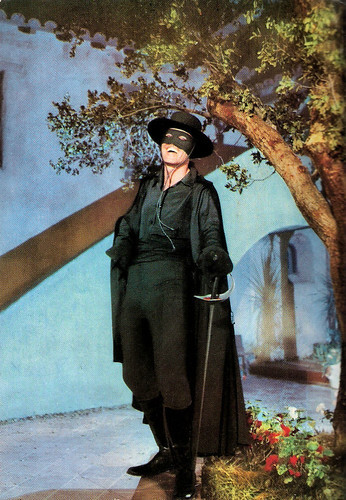
French postcard by Les Presses de Belville, Paris, no. 109. Photo: Walt Disney Productions, 1964. Guy Williams in Zorro (1957-1959).
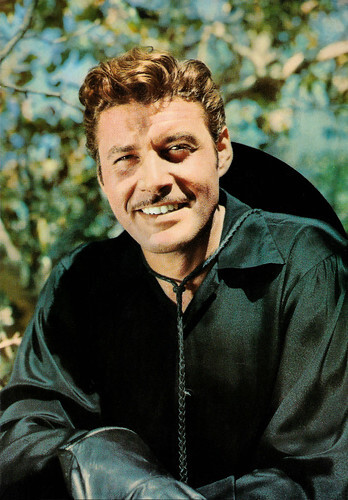
French postcard by Les Presses de Belville, Paris, no. 110. Photo: Walt Disney Productions, 1964. Guy Williams in Zorro (1957-1959).
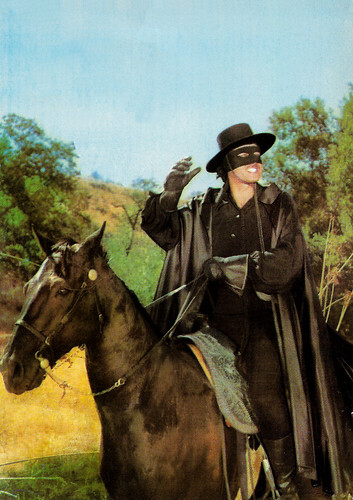
French postcard by Les Presses de Belville, Paris. Photo: Walt Disney Productions, 1964. Guy Williams in Zorro (1957-1959).
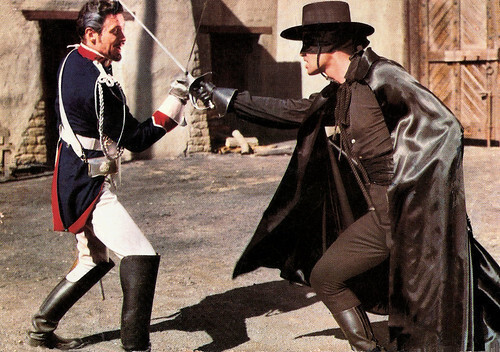
French postcard by Les Presses de Belville, Paris. Photo: Walt Disney Productions, 1964. Guy Williams in Zorro (1957-1959).
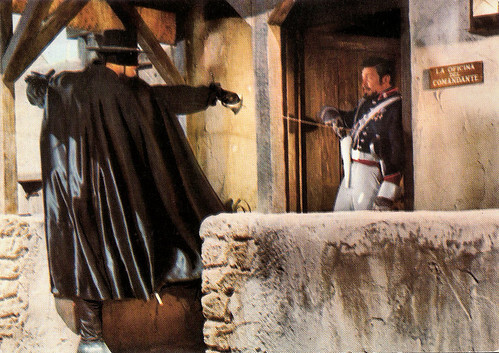
French postcard by Les Presses de Belville, Paris. Photo: Walt Disney Productions, 1964.
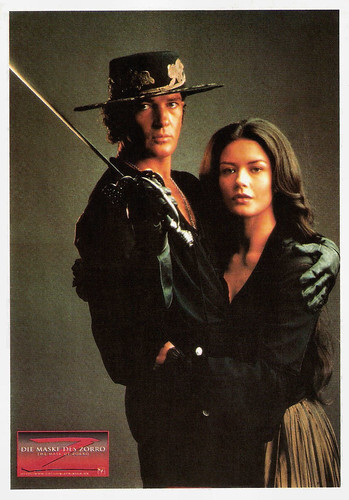
German postcard by Memory Cards, no. 495. Photo: Antonio Banderas and Catherine Zeta-Jones in The Mask of Zorro (Martin Campbell, 1998).
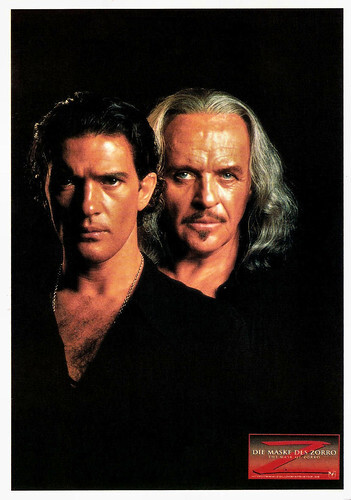
German postcard by Memory Cards, no. 496. Photo: Antonio Banderas and Anthony Hopkins in The Mask of Zorro (Martin Campbell, 1998).
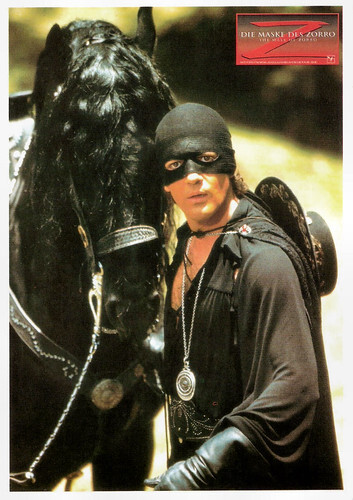
German postcard by Memory Cards, no. 497. Photo: Antonio Banderas in The Mask of Zorro (Martin Campbell, 1998).
Sources: Wikipedia (Dutch and English), and IMDb.

Italian postcard by G.B. Falci, Editore, Milano, no. 452. Douglas Fairbanks in Don Q Son of Zorro (Donald Crisp, 1925).

German postcard by Ross Verlag Foreign, no. 3658/4, 1928-1929. Photo: United Artists. Douglas Fairbanks is wearing the outfit from Don Q, Son of Zorro (Donald Crisp, 1925).

French postcard by Les Presses de Belville, Paris. Photo: Walt Disney Productions, 1964. Guy Williams in the TV series Zorro (1957-1959).

West German flyer by Illustrierte Film-Bühne, no. 6648. Sean Flynn in Il segno di Zorro/Sign of Zorro (Mario Caiano, 1963). The German title was Zorro, der Mann mit den zwei Gesichten.

French postcard by Sonis, no. C. 899. Photo: Zorro Productions / Tristar Pictures. Antonio Banderas in The Mask of Zorro (Martin Campbell, 1998).

Taiwanese postcard by Cool Card. Image: film poster of Antonio Banderas and Catherine Zeta-Jones in The Legend of Zorro (Martin Campbell, 2005).
A genre-defining swashbuckler adventure
Zorro debuted in Johnston McCulley's novel 'The Curse of Capistrano', serialized in five parts between 9 August and 6 September 1919, in the pulp magazine All-Story Weekly. The story was originally meant as a standalone tale, and at the denouement, Zorro's true identity is revealed to all. Zorro is the secret identity of Don Diego de la Vega.
In McCulley's story, Zorro has a high bounty on his head but is too skilled and cunning for the bumbling authorities to catch, and he also delights in publicly humiliating them. Because of this, the townspeople started calling him "El Zorro" due to his fox-like cunning and charm. He is a former university student, newly recalled by his father, Don Alejandro de la Vega, from Madrid to his home outside El Pueblo de Nuestra Señora Reina de los Angeles sobre El Rio Porciuncula, later shortened to Los Angeles.
Then the town was still part of Mexican California (1821–1848), after its independence from Spain. The dashing black-clad masked outlaw defends the people of the land against tyrannical officials and other villains. Not only is he too cunning and fox-like for the bumbling authorities to catch, but he delights in publicly humiliating them. McCulley did not intend to write further stories about Zorro, but the new medium film changed things.
The following year, American actor Douglas Fairbanks had the inspiration of staging a new type of adventure costume picture, a genre that was then out of favour with the public. Fairbanks had been a comic in his previous films. On their honeymoon, Fairbanks and Mary Pickford selected 'The Curse of Capistrano' as the inaugural picture for their new studio, United Artists, beginning the character's cinematic tradition. In his film The Mark of Zorro (Fred Niblo, 1920), Fairbanks combined his appealing screen persona with the new adventurous costume element. This genre-defining Swashbuckler adventure was the first film version of Zorro.
The Mark of Zorro was a smash success and parlayed Douglas Fairbanks into the rank of superstar. Due to its success, McCulley's novel was republished, also titled 'The Mark of Zorro'. In response to public demand fueled by the film, McCulley wrote more than sixty more Zorro stories, beginning in 1922 with 'The Further Adventures of Zorro', which was also serialized in Argosy All-Story Weekly. For the remainder of his career in silent films, Douglas Fairbanks continued to produce and star in ever more elaborate, impressive costume films, such as The Three Musketeers (Fred Niblo, 1921), Robin Hood (Allan Dwan, 1922) and The Thief of Bagdad (Raoul Walsh, 1924). And in 1925, Douglas Fairbanks made a Zorro sequel, Don Q Son of Zorro (Donald Crisp, 1925).

German postcard by Ross Verlag, no. 3658/1, 1928-1929. Photo: United Artists. Douglas Fairbanks and Juliette Belanger in Don Q Son of Zorro (Donald Crisp, 1925).

German postcard by Ross Verlag, no. 3658/2, 1928-1929. Photo: United Artists. Douglas Fairbanks in Don Q, Son of Zorro (Donald Crisp, 1925).

Austrian postcard by Iris Verlag, no. 5205. Photo: United Artists. Mary Astor and Douglas Fairbanks in Don Q Son of Zorro (Donald Crisp, 1925).

French postcard by A.N., Paris, in the Les Vedettes du Cinéma series, no. 171. Photo: United Artists. Douglas Fairbanks in Don Q, Son of Zorro (Donald Crisp, 1925).

French postcard by Editions Cinémagazine, no. 263. Photo: Fairbanks in his outfit for Don Q Son of Zorro (Donald Crisp, 1925).

Dutch poster by Frans Bosen for Don Q Son of Zorro (Donald Crisp, 1925) starring Douglas Fairbanks .
Foppish dandy by day and masked swordsman by night
In the 1930s and 1940s, Johnston McCulley wrote dozens more Zorro stories for various magazines, including Argosy and West. Several film versions were made during this period including The Bold Caballero (Wells Root, 1936) starring Robert Livingstone and the Republic serials Zorro Rides Again (William Witney, John English, 1937) with John Carroll and Zorro's Fighting Legion (William Witney, John English, 1939) with Reed Hadley. The best-known film version was The Mark of Zorro (Rouben Mamoulian, 1940) starring Tyrone Power .
Walt Disney produced a now classic American half-hour television series Zorro , which ran from October 1957 to June 1959, with a total of 78 episodes. Guy Williams is Don Diego who plays the foppish dandy by day and the masked swordsman Zorro who slashes 'Z's everywhere by night. His horses (black and white) are Tornado and Phantom. Although the series was very popular, especially with a young audience, it had to be discontinued after its second season. This was due to a financial disagreement between Disney and the network that broadcast the series. Author McCulley died in 1958, just as Zorro was at the height of his popularity thanks to the Disney series.
Disney also released two feature films with Guy Williams, The Sign of Zorro (Lewis R. Foster, Norman Foster, 1958) and Zorro, the Avenger (Charles Barton, 1959) which were episode compilations. There were also four one-hour follow-ups on the Walt Disney anthology television series in the 1960–1961 TV season. During the 1960s various Zorro films were produced in Spain and Italy. These included La venganza del Zorro/Zorro the Avenger (Joaquín Luis Romero Marchent, 1962) with Frank Latimore, Il segno di Zorro/Duel at the Rio Grande (Mario Caiano, 1963) with Sean Flynn, Zorro e i tre moschettieri/Zorro and the Three Musketeers (Luigi Capuano, 1963), with Gordon Scott , I nipoti di Zorro/The Nephews of Zorro ( Marcello Ciorciolini, 1968) starring the comic duo Franco and Ciccio and Dean Reed and El Zorro justiciero/The Avenger, Zorro (Rafael Romero Marchent, 1969) starring Fabio Testi.
Hollywood became interested again in the dashing black-clad masked swordsman and produced the TV film The Mark of Zorro (Don McDougall, 1974) starring Frank Langella and also with Ricardo Montalban , Gilbert Roland and Yvonne De Carlo . It was also a backdoor pilot for a television series on which ABC-TV declined to pick up the option. More successful were the Italian Zorro Westerns Ah sì? E io lo dico a Zzzzorro!/Mark of Zorro (Luca Damiano, 1975) with George Hilton and Zorro (Duccio Tessari, 1975) starring Alain Delon . After the Mexican Western, La gran aventura del Zorro/The Great Adventure of Zorro (Raúl de Anda, 1976) with Rodolfo de Anda and a massive hit in Mexican Cinema, Hollywood came with a satire, Zorro, the Gay Blade (Peter Medak, 1981) with George Hamilton.
Nearly 20 years later, Zorro was finally reanimated in the Oscar-nominated American Swashbuckler The Mask of Zorro (Martin Campbell, 1998). The lead roles are played by Anthony Hopkins as an aged Don Diego de la Vega and Antonio Banderas as Alejandro Murrieta, a misfit outlaw/cowboy who is groomed to become the next Zorro, with Alejandro eventually marrying Diego's daughter Elena ( Catherine Zeta-Jones ). A sequel to the film came in 2005 with The Legend of Zorro (Martin Campbell, 2005). Antonio Banderas and Catherine Zeta-Jones reprise their roles as the titular hero and his spouse, Elena, and Rufus Sewell stars as the villain, Count Armand. In 2005, Isabel Allende also wrote an (obviously fictional) life story of Zorro, 'El Zorro'. She wrote the book on behalf of Zorro Productions, Inc, the Californian company that has owned the rights to Zorro since 1986.

French postcard by Les Presses de Belville, Paris, no. 109. Photo: Walt Disney Productions, 1964. Guy Williams in Zorro (1957-1959).

French postcard by Les Presses de Belville, Paris, no. 110. Photo: Walt Disney Productions, 1964. Guy Williams in Zorro (1957-1959).

French postcard by Les Presses de Belville, Paris. Photo: Walt Disney Productions, 1964. Guy Williams in Zorro (1957-1959).

French postcard by Les Presses de Belville, Paris. Photo: Walt Disney Productions, 1964. Guy Williams in Zorro (1957-1959).

French postcard by Les Presses de Belville, Paris. Photo: Walt Disney Productions, 1964.

German postcard by Memory Cards, no. 495. Photo: Antonio Banderas and Catherine Zeta-Jones in The Mask of Zorro (Martin Campbell, 1998).

German postcard by Memory Cards, no. 496. Photo: Antonio Banderas and Anthony Hopkins in The Mask of Zorro (Martin Campbell, 1998).

German postcard by Memory Cards, no. 497. Photo: Antonio Banderas in The Mask of Zorro (Martin Campbell, 1998).
Sources: Wikipedia (Dutch and English), and IMDb.
Published on September 01, 2023 22:00
August 31, 2023
Jeff Bridges
Jeff Bridges (1949) is an American film actor, film producer and country singer and guitarist. He is best known for such films as The Last Picture Show (1971), Tucker (1988), The Fabulous Baker Boys (1989), True Grit (2011), and in particular The Big Lebowski (1988). Bridges was nominated for an Academy Award in 1972 for The Last Picture Show, in 1975 for Thunderbolt and Lightfoot, in 1985 for Starman, in 2001 for The Contender and in 2011 for True Grit. In 2010, he received an Oscar for his leading role in Crazy Heart.
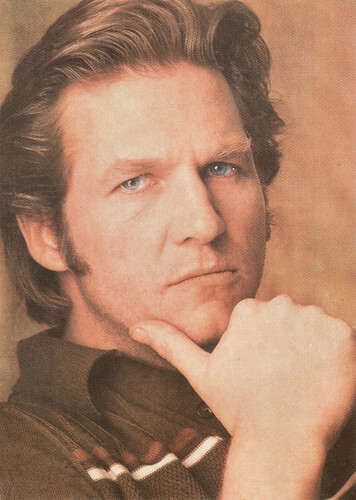
Romanian postcard by Casa Filmului Acin. Jeff Bridges on a publicity still for Fat City (John Huston, 1972).
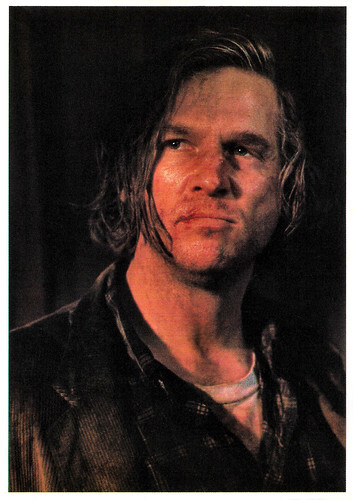
British postcard by Film Review, London, Set E, Card 3. Photo: 20th Century Fox. Jeff Bridges in The Vanishing (George Sluizer, 1993).
Rambling, reckless and unpredictable
Jeffrey Leon Bridges was born in Los Angeles, California, in 1949. Bridges was brought up on acting. Both his father Lloyd Bridges and his older brother Beau Bridges were actors. His mother's name was Dorothy Dean Simpson.
Bridges made his film debut, without billing, alongside his mother and brother Beau in the film The Company She Keeps (John Cromwell, 1951). Jeff also appeared on occasion with his famous dad on his popular underwater TV series Sea Hunt (1958).
After working in the Coast Guard, he developed into a film actor. In 1971, he landed a coming-of-age role in Peter Bogdanovich's critically-acclaimed ensemble film The Last Picture Show, which established his name as an actor. That year, he was nominated for the Academy Award for Best Male Performance for his part of Duane Jackson. It set the tone for the types of roles Jeff would acquaint himself with his fans: rambling, reckless and unpredictable.
During the 1970s, he was given a large number of roles. He played a boxer on his way up opposite a declining Stacy Keach in Fat City (John Huston, 1972). Bridges was nominated for the Oscar for his role as a rookie opposite Clint Eastwood in the action comedy Thunderbolt and Lightfoot (Michael Cimino, 1973). He appeared as a low-level Western writer who wants to be a real-life cowboy in Hearts of the West (Howard Zieff, 1975). The 1976 remake of King Kong (John Guillermin, 1976) was followed by several flops, of which Heaven's Gate (Michael Cimino, 1980) is the most infamous. Tron (Steven Lisberger, 1982) was also initially a flop but turned out to be a Science-Fiction cult classic. This series of flops put a dent in Bridges' career.
He came back with Starman (John Carpenter, 1984). For his role as an alien who lands on Earth and assumes human form, he was nominated for the Oscar for Best Actor. That same year, he also starred in the equally successful Film Noir remake Against All Odds (Taylor Hackford, 1984). Other successful films followed, including the crime drama Jagged Edge (Richard Marquand, 1985) with Glenn Close and The Morning After (Sidney Lumet, 1986) with Jane Fonda. His role as a car salesman in Francis Coppola's Tucker: The Man and His Dream (1988) is considered one of his best roles. With his brother Beau and Michelle Pfeiffer, he starred in The Fabulous Baker Boys (Steve Kloves, 1989).
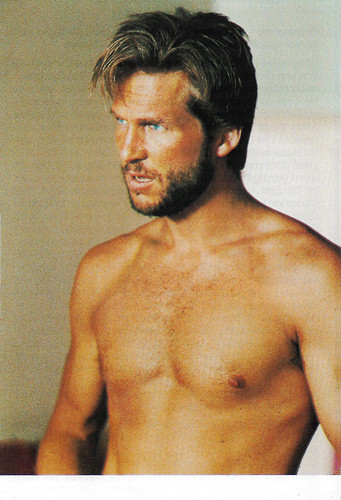
Dutch collectors card. Jeff Bridges in Against All Odds (Taylor Hackford, 1984).
The Dude
In 1990, Jeff Bridges reunited with Cybill Shepherd in Texasville (Peter Bogdanovich, 1990), the moderately received sequel to their big breakthrough film The Last Picture Show. He returned with Terry Gilliam's The Fisher King (1991), in which he plays a radio DJ who is depressed but is helped back on his feet by a drifter ( Robin Williams ).
His performances in the films American Heart (Martin Bell, 1992), which he also produced, and Fearless (Peter Weir, 1993) were acclaimed. Another commercial success followed with the thriller Blown Away (Stephen Hopkins, 1994) and The Mirror Has Two Faces (Barbra Streisand, 1996). One of his best-known characters is "The Dude", the stoned, bowling hippie from Joel and Ethan Coen's The Big Lebowski (1998).
The following year, he appeared alongside Tim Robbins in the thriller Arlington Road (Mark Pellington, 1999). He was again nominated for an Oscar for his role as the President of America in The Contender (Rod Lurie, 2000). The mystery K-PAX (Iain Softley, 2001) with Kevin Spacey did rather poorly in the cinema, but Seabiscuit (Gary Ross, 2003) was a direct hit in the United States. He seized the moment as a bald-pated villain as Robert Downey Jr.'s nemesis in the blockbuster Iron Man (Jon Favreau, 2008).
In 2010, he won an Oscar and a Golden Globe for his role as a faded country music musician in Crazy Heart (Scott Cooper, 2009). Bridges next reprised one of his more famous roles in Tron: Legacy (Joseph Kosinski, 2010), and received another Oscar nomination for Best Actor for his role in the Western remake True Grit (Ethan & Joel Coen, 2010). In 2014, he co-produced and starred in an adaptation of the Lois Lowry Science-Fiction drama The Giver (Phillip Noyce, 2014). Bridges stole every scene in which he appeared in the thriller Bad Times at the El Royale (Drew Goddard, 2018) and he was last seen as a retired CIA agent in the TV series The Old Man (2022).
Besides his Oscar (nominations), Bridges has been awarded more than ten other acting awards, including a Saturn Award for Starman and a Career Achievement Award from the National Board of Review of Motion Pictures. Jeff Bridges has been married since 1977 to Susan Geston, whom he met on the set of Rancho Deluxe (Frank Perry, 1975). They have three daughters, Isabelle (born 1981), Jessica (born 1983), and Hayley (born 1985). In 2020, Jeff Bridges announced on Twitter that he is seriously ill.

Vintage postcard, no. C 93. Jeff Bridges, John Goodman and Steve Buscemi in The Big Lebowski (Joel & Ethan Coen, 1988).
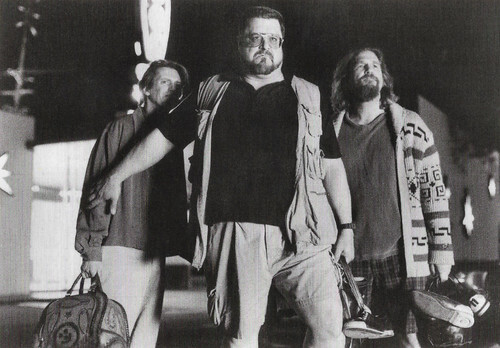
Vintage postcard, no. 516450. Steve Buscemi, John Goodman and Jeff Bridges in The Big Lebowski (Joel & Ethan Coen, 1988).
Sources: Wikipedia (Dutch and English) and .

Romanian postcard by Casa Filmului Acin. Jeff Bridges on a publicity still for Fat City (John Huston, 1972).

British postcard by Film Review, London, Set E, Card 3. Photo: 20th Century Fox. Jeff Bridges in The Vanishing (George Sluizer, 1993).
Rambling, reckless and unpredictable
Jeffrey Leon Bridges was born in Los Angeles, California, in 1949. Bridges was brought up on acting. Both his father Lloyd Bridges and his older brother Beau Bridges were actors. His mother's name was Dorothy Dean Simpson.
Bridges made his film debut, without billing, alongside his mother and brother Beau in the film The Company She Keeps (John Cromwell, 1951). Jeff also appeared on occasion with his famous dad on his popular underwater TV series Sea Hunt (1958).
After working in the Coast Guard, he developed into a film actor. In 1971, he landed a coming-of-age role in Peter Bogdanovich's critically-acclaimed ensemble film The Last Picture Show, which established his name as an actor. That year, he was nominated for the Academy Award for Best Male Performance for his part of Duane Jackson. It set the tone for the types of roles Jeff would acquaint himself with his fans: rambling, reckless and unpredictable.
During the 1970s, he was given a large number of roles. He played a boxer on his way up opposite a declining Stacy Keach in Fat City (John Huston, 1972). Bridges was nominated for the Oscar for his role as a rookie opposite Clint Eastwood in the action comedy Thunderbolt and Lightfoot (Michael Cimino, 1973). He appeared as a low-level Western writer who wants to be a real-life cowboy in Hearts of the West (Howard Zieff, 1975). The 1976 remake of King Kong (John Guillermin, 1976) was followed by several flops, of which Heaven's Gate (Michael Cimino, 1980) is the most infamous. Tron (Steven Lisberger, 1982) was also initially a flop but turned out to be a Science-Fiction cult classic. This series of flops put a dent in Bridges' career.
He came back with Starman (John Carpenter, 1984). For his role as an alien who lands on Earth and assumes human form, he was nominated for the Oscar for Best Actor. That same year, he also starred in the equally successful Film Noir remake Against All Odds (Taylor Hackford, 1984). Other successful films followed, including the crime drama Jagged Edge (Richard Marquand, 1985) with Glenn Close and The Morning After (Sidney Lumet, 1986) with Jane Fonda. His role as a car salesman in Francis Coppola's Tucker: The Man and His Dream (1988) is considered one of his best roles. With his brother Beau and Michelle Pfeiffer, he starred in The Fabulous Baker Boys (Steve Kloves, 1989).

Dutch collectors card. Jeff Bridges in Against All Odds (Taylor Hackford, 1984).
The Dude
In 1990, Jeff Bridges reunited with Cybill Shepherd in Texasville (Peter Bogdanovich, 1990), the moderately received sequel to their big breakthrough film The Last Picture Show. He returned with Terry Gilliam's The Fisher King (1991), in which he plays a radio DJ who is depressed but is helped back on his feet by a drifter ( Robin Williams ).
His performances in the films American Heart (Martin Bell, 1992), which he also produced, and Fearless (Peter Weir, 1993) were acclaimed. Another commercial success followed with the thriller Blown Away (Stephen Hopkins, 1994) and The Mirror Has Two Faces (Barbra Streisand, 1996). One of his best-known characters is "The Dude", the stoned, bowling hippie from Joel and Ethan Coen's The Big Lebowski (1998).
The following year, he appeared alongside Tim Robbins in the thriller Arlington Road (Mark Pellington, 1999). He was again nominated for an Oscar for his role as the President of America in The Contender (Rod Lurie, 2000). The mystery K-PAX (Iain Softley, 2001) with Kevin Spacey did rather poorly in the cinema, but Seabiscuit (Gary Ross, 2003) was a direct hit in the United States. He seized the moment as a bald-pated villain as Robert Downey Jr.'s nemesis in the blockbuster Iron Man (Jon Favreau, 2008).
In 2010, he won an Oscar and a Golden Globe for his role as a faded country music musician in Crazy Heart (Scott Cooper, 2009). Bridges next reprised one of his more famous roles in Tron: Legacy (Joseph Kosinski, 2010), and received another Oscar nomination for Best Actor for his role in the Western remake True Grit (Ethan & Joel Coen, 2010). In 2014, he co-produced and starred in an adaptation of the Lois Lowry Science-Fiction drama The Giver (Phillip Noyce, 2014). Bridges stole every scene in which he appeared in the thriller Bad Times at the El Royale (Drew Goddard, 2018) and he was last seen as a retired CIA agent in the TV series The Old Man (2022).
Besides his Oscar (nominations), Bridges has been awarded more than ten other acting awards, including a Saturn Award for Starman and a Career Achievement Award from the National Board of Review of Motion Pictures. Jeff Bridges has been married since 1977 to Susan Geston, whom he met on the set of Rancho Deluxe (Frank Perry, 1975). They have three daughters, Isabelle (born 1981), Jessica (born 1983), and Hayley (born 1985). In 2020, Jeff Bridges announced on Twitter that he is seriously ill.

Vintage postcard, no. C 93. Jeff Bridges, John Goodman and Steve Buscemi in The Big Lebowski (Joel & Ethan Coen, 1988).

Vintage postcard, no. 516450. Steve Buscemi, John Goodman and Jeff Bridges in The Big Lebowski (Joel & Ethan Coen, 1988).
Sources: Wikipedia (Dutch and English) and .
Published on August 31, 2023 22:00
August 30, 2023
La Collectionneuse: Irene Dunne
The word 'lady' has often been associated with Irene Dunne. She once said about it: "If you mean by 'lady', the feminine counterpart of 'gentleman', anyone would be proud to be called a lady in that sense." She never played vamps, scheming vixens, harridans or murderesses and her likeable and reassuring screen persona enabled her to get starring roles for two decades. After her R.K.O. contract expired in the mid-1930s, she wisely chose not to sign a long-term contract again, only accepting short-term deals from various studios. This allowed her to have more control over her career and to select the roles that she thought the most appropriate for her. In real life, her reputation stayed unblemished by any scandal or gossip. In 1927, she married Francis Griffin, a dentist who later became a businessman, and they adopted a daughter in 1938. It was by all means a happy union that lasted until Griffin’s death in 1965.
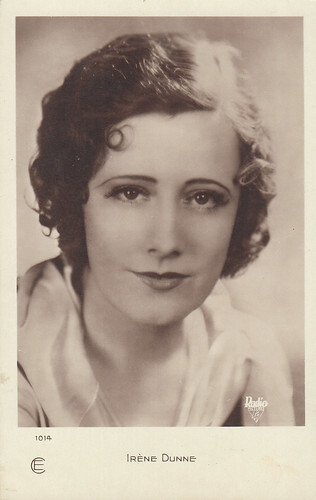
French postcard by Cinémagazine-Edition, Paris, no. 1014. Photo: Radio Pictures. Collection: Marlene Pilaete.

French postcard by A.N., Paris, no. 1099. Photo: R.K.O. Films. Collection: Marlene Pilaete.

Spanish postcard by Dümmatzen, no. 191. Photo: Metro Goldwyn Mayer. Collection: Marlene Pilaete.
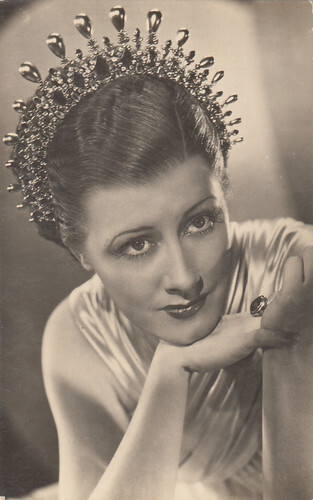
Spanish postcard, no. 1066. Irene Dunne in Roberta (William A. Seiter, 1935). Photo: R.K.O. Collection: Marlene Pilaete.
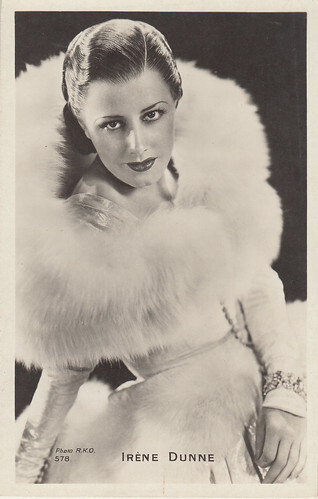
French postcard by Edition Chantal, Paris, no. 578. Photo: R.K.O. Collection: Marlene Pilaete.
Her musical background
Irene Dunne was born Irene Dunn on the 20th of December 1898 in Louisville, Kentucky, U.S.A. Later, she would add an extra 'e' to her surname. Her mother was an accomplished musician and, from an early age, Irene took piano and singing lessons.
After having graduated from the Indianapolis Conservatory of Music, she was awarded a senior diploma in voice in June 1919 at the Chicago Musical College.
She auditioned at the prestigious Metropolitan Opera of New York but failed. So, she decided to go into musical comedy, which was probably more suited to her vocal range.
Her career in the twenties, on Broadway and in touring companies, was on the whole uneven and lacklustre.
She had to wait until the end of the decade to get her big break when she was chosen by Florenz Ziegfeld to play Magnolia in the road company of 'Show Boat'. Her success led to a movie contract.
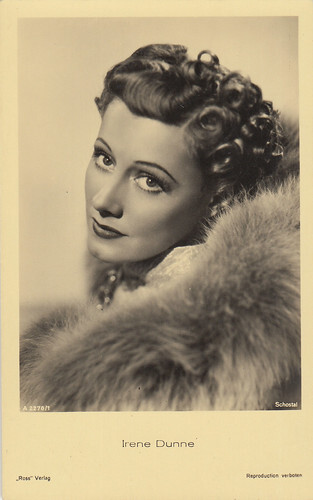
German postcard by Ross Verlag, no. A2270/1, 1939-1940. Photo: Schostal. Collection: Marlene Pilaete.
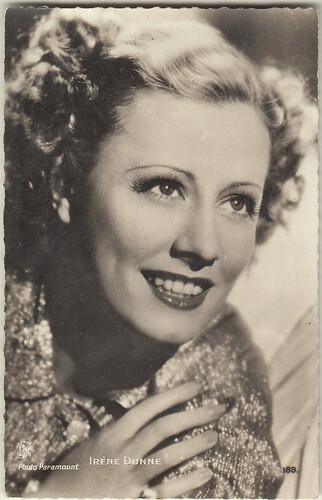
French postcard by Editions et Publications cinématographiques, no. 189. Photo: Paramount. Collection: Marlene Pilaete.
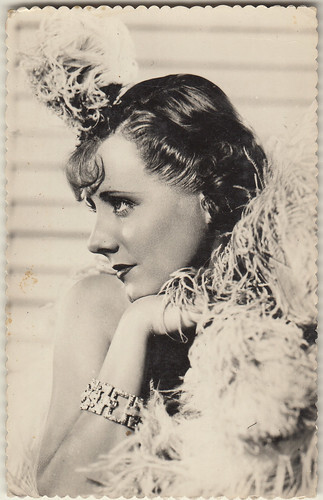
Spanish postcard, no. 66. Collection: Marlene Pilaete.
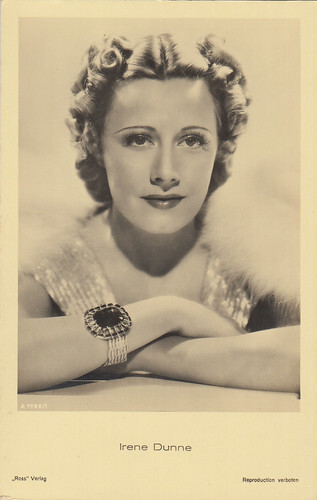
German postcard by Ross Verlag, no. A1766/1, 1937-1938. Collection: Marlene Pilaete.

German postcard by Ross Verlag, no. A1204/1, 1937-1938. Photo: Paramount. Collection: Marlene Pilaete.
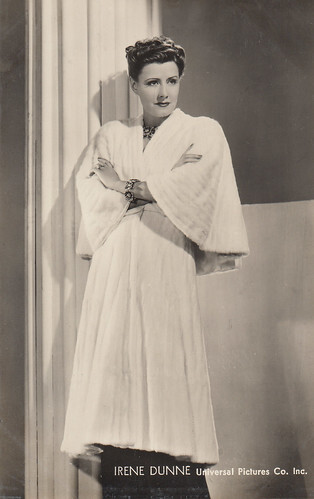
Dutch postcard by J.S.A., no. 7. Photo: Universal Pictures Co. Inc. Collection: Marlene Pilaete.
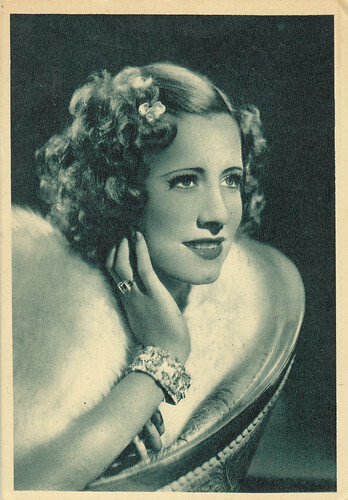
Italian postcard by Vecchioni & Guadagno, Roma. Irene Dunne in Theodora Goes Wild (Richard Boleslawski, 1936). Collection: Marlene Pilaete.
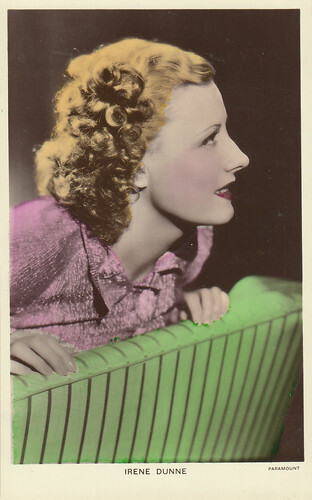
British postcard in the Colourgraph Series, London, no. C283. Photo: Paramount. Collection: Marlene Pilaete.
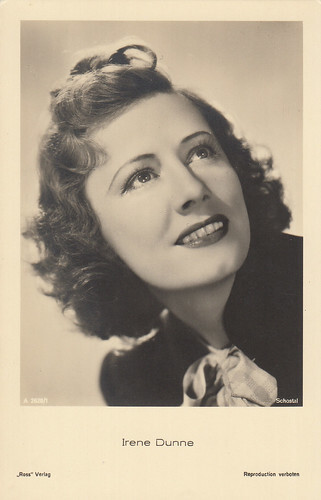
German postcard by Ross Verlag, no. A 2628/1, 1939-1940. Photo: Schostal. Collection: Marlene Pilaete.
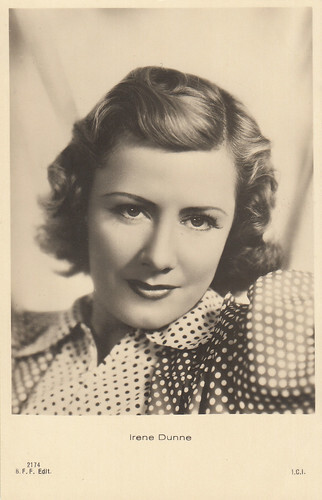
Italian postcard by Ballerini & Fratini, Firenze, no. 2174. Photo: I.C.I. Collection: Marlene Pilaete.
Dramatic actress, singer and comedienne: the three facets of her talent
She made an inauspicious screen debut in Leathernecking (1930) but, fortunately, she was soon chosen to play the leading female role in the big-budgeted epic Cimarron (1931), which made her a star and earned her an Oscar nomination. She would be later nominated four other times but never won. In the first years of her career, she mostly appeared in tearjerkers and romantic dramas such as Consolation Marriage (1931), Symphony of Six Million (1932), Back Street (1932), The Secret of Madame Blanche (1933), Ann Vickers (1933), If I Were Free (1933), The Age of Innocence (1934) or Magnificent Obsession (1935).
Stingaree (1934), in which she played a budding primadonna, reminded Hollywood that she was an experienced singer and she was signed by Warner for the lead in the musical Sweet Adeline (1935). Later, her musical gifts were probably used at their best in Roberta (1935), in which she sang the standard 'Smoke Gets in your Eyes', and Show Boat (1936). Although she had been reluctant at first to accept the part, she starred in 1936 in Theodora Goes Wild, which revealed her comedy skills. Two other classic screwball comedies in which she shone were The Awful Truth (1937) and My Favourite Wife (1940), both with Cary Grant , who was again her co-star in the melodrama Penny Serenade (1941).
The sentimental drama Love Affair (1939) paired her with Charles Boyer . They got along very well and their screen chemistry was so great that they were reunited in When Tomorrow Comes (1939) and Together Again (1944). In 1943, she appeared in a huge hit at the box office, the wartime fantasy drama A Guy Named Joe (1943), opposite Spencer Tracy as her former boyfriend’s ghost. She followed it with another success, the propaganda melodrama The White Cliffs of Dover (1944), which aimed to cement the friendship between the U.S.A. and England. In this, she played an American woman who married an Englishman and relocates to Great Britain, where she gradually gets to understand and appreciate its inhabitants. During the course of the story, she loses her husband during World War I and her son during World War II.
In the second half of the 1940s, Irene Dunne starred in three important films in a row. She was perfect as a noble, smart and resourceful governess in Anna and the King of Siam (1946). Later, this story became the basis for the famous musical 'The King and I'. She was then praised for her excellent performances in two movies adapted from long-running Broadway plays, Life With Father (1947) and I Remember Mama (1948).
After a mild comedy, Never a Dull Moment (1950), she elected to play, under heavy makeup, a dumpy and elderly Queen Victoria in The Mudlark (1950), which was filmed in England by 20th Century Fox. But it was not the kind of movie her fans expected of her and it was a commercial disappointment in the U.S.A. Her film career ended without fanfare with It Grows on Trees (1952), which she later called "terrible". From 1952 to 1962, she occasionally worked for television.
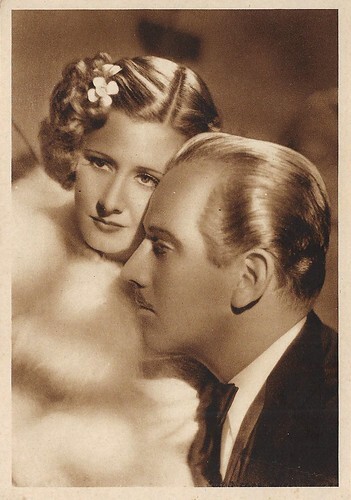
Italian postcard by Vecchioni & Guadagno, Roma. Photo: Columbia EIA. Irene Dunne and Melvyn Douglas in Theodora Goes Wild (Richard Boleslawski, 1936), released in Italy as L'adorabile nemica (The adorable enemy). Collection: Ivo Blom.
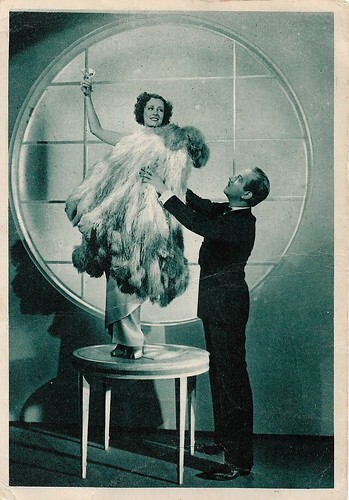
Italian postcard by Vecchioni & Guadagno, Roma. Photo: Columbia EIA. Irene Dunne and Melvyn Douglas in Theodora Goes Wild (Richard Boleslawski, 1936), released in Italy as L'adorabile nemica (The adorable enemy). Collection: Ivo Blom.
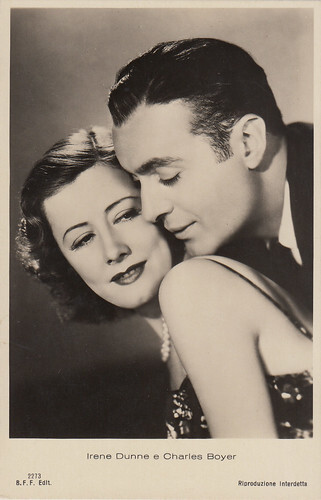
Italian postcard by Ballerini & Fratini, Firenze, no. 3640. Irene Dunne and Charles Boyer in When Tomorrow Comes (John M. Stahl, 1939). Collection: Marlene Pilaete.
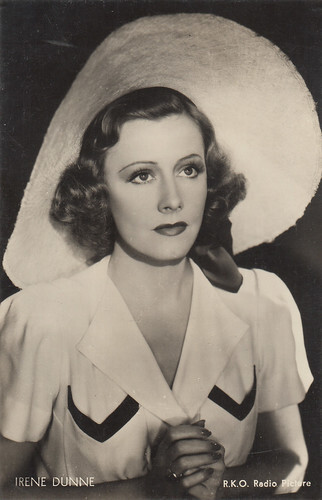
Dutch postcard by J.S.A., no. 88. Photo: R.K.O. Radio Pictures. Collection: Marlene Pilaete.

American postcard by W.J. Gray. Collection: Marlene Pilaete.
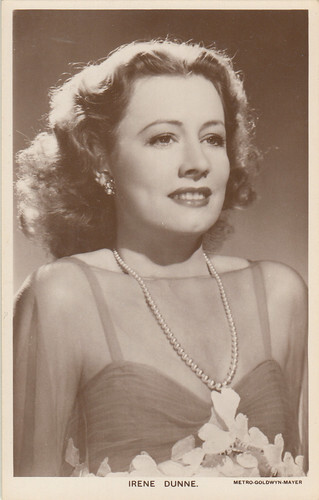
British postcard by Picturegoer, no. W141. Photo: Metro-Goldwyn-Mayer. Collection: Marlene Pilaete.
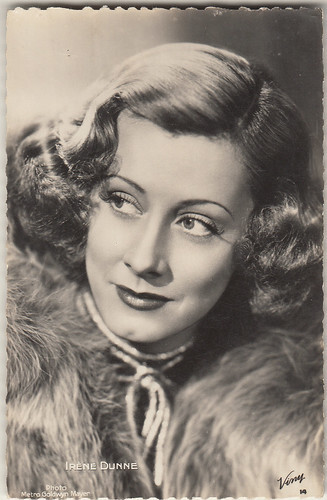
French postcard by Viny, no. 14. Photo: Metro Goldwyn Mayer. Collection: Marlene Pilaete.
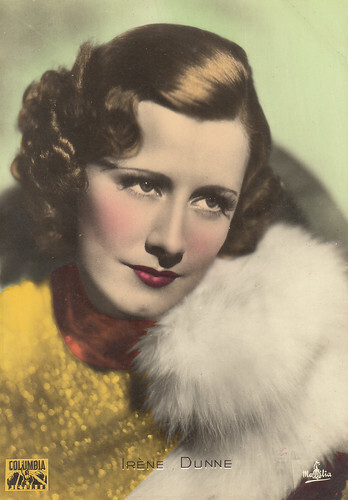
French postcard by Massilia. Photo: Columbia Pictures. Collection: Marlene Pilaete.
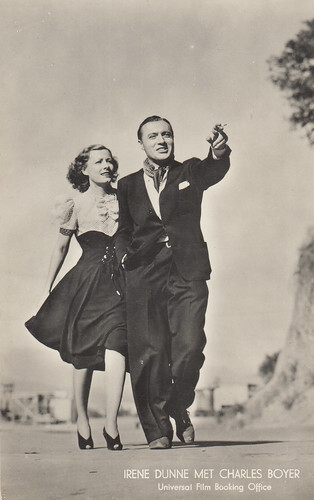
Dutch postcard by J.S.A., no. 174. Photo: Universal Film Booking Office. Irene Dunne and Charles Boyer . Collection: Marlene Pilaete.
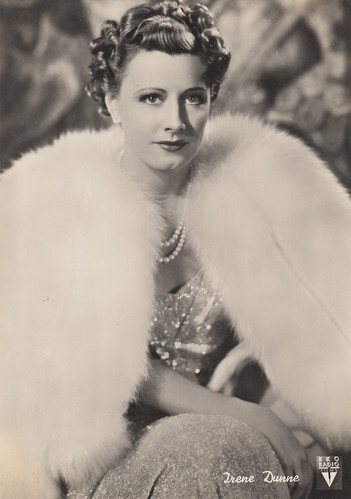
Italian postcard by Rotalfoto, Milano, no. 68. Photo: RKO Radio Films. Collection: Marlene Pilaete.
Later years
A devout Catholic, Irene Dunne increasingly showed a leaning towards civil causes over the years and devoted herself to philanthropic work.
She was an active fund-raiser for the St. John’s Hospital in Santa Monica and supported several other charities as well.
In 1957, President Eisenhower nominated her to be an alternate delegate to the 1957-1958 United Nations General Assembly session.
She was also appointed by Governor Ronald Reagan to serve on the California Art Commission from 1967 to 1970. During her stay, she notably promoted an exhibit offering blind people a tactile view of sculptural art.
Irene Dunne passed away on the 4th of September 1990.
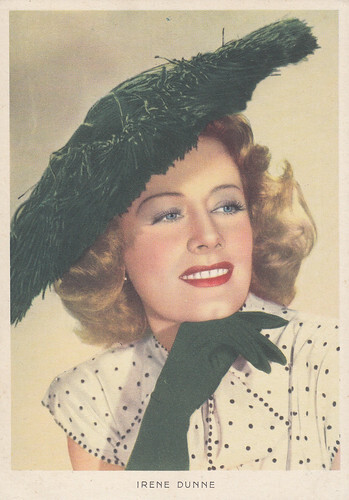
Italian postcard by Garami, Milano. Collection: Marlene Pilaete.
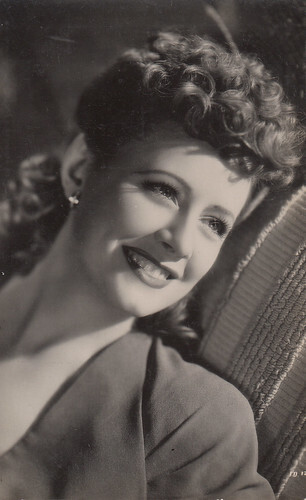
Spanish postcard by Archivo Bermejo, no. 585. Collection: Marlene Pilaete.
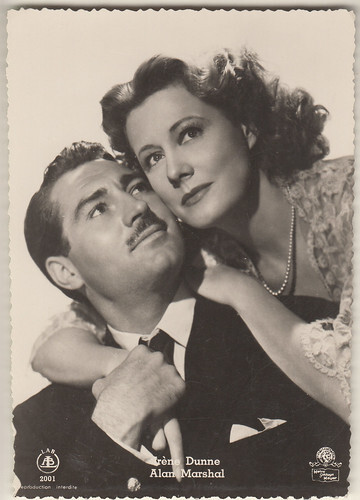
Belgian postcard by Editions L.A.B. Bruxelles, no. 2001. Photo: Metro Goldwyn Mayer. Irene Dunne and Alan Marshall in The White Cliffs of Dover (Clarence Brown, 1944). Collection: Marlene Pilaete.
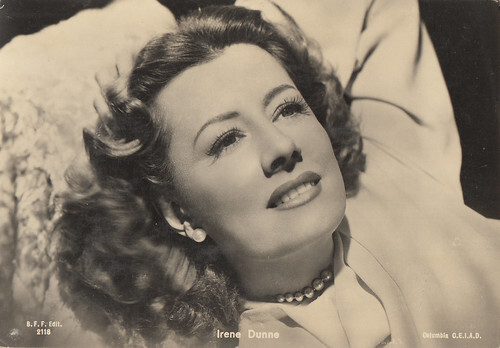
Italian postcard by B.F.F., Firenze, no. 2118. Photo: Columbia C.E.I.A.D. Collection: Marlene Pilaete.
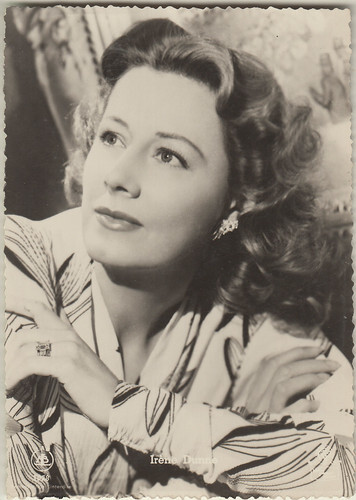
Belgian postcard by Editions L.A.B., Bruxelles, no. 1028. Photo: Metro Goldwyn Mayer. Collection: Marlene Pilaete.
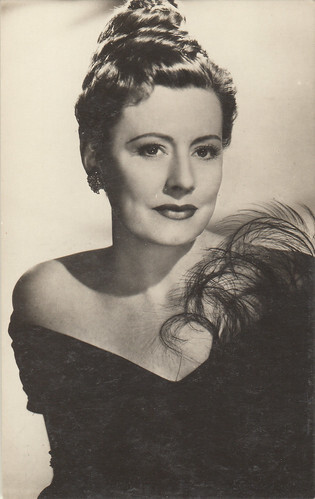
Spanish postcard by Sobe, no. 682. Collection: Marlene Pilaete.

British postcard by Picturegoer, no. D211. Photo: Universal International. Collection: Marlene Pilaete.
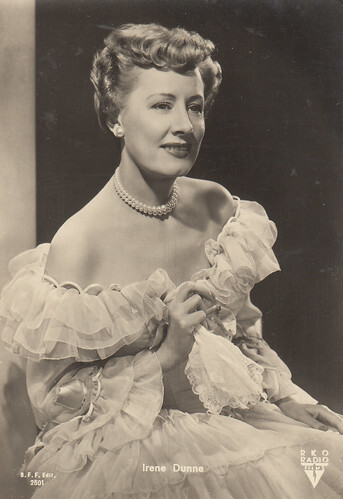
Italian postcard by B.F.F., Firenze, no. 2501. Photo: RKO Radio Films. Collection: Marlene Pilaete.
Text: Marlene Pilaete.

French postcard by Cinémagazine-Edition, Paris, no. 1014. Photo: Radio Pictures. Collection: Marlene Pilaete.

French postcard by A.N., Paris, no. 1099. Photo: R.K.O. Films. Collection: Marlene Pilaete.

Spanish postcard by Dümmatzen, no. 191. Photo: Metro Goldwyn Mayer. Collection: Marlene Pilaete.

Spanish postcard, no. 1066. Irene Dunne in Roberta (William A. Seiter, 1935). Photo: R.K.O. Collection: Marlene Pilaete.

French postcard by Edition Chantal, Paris, no. 578. Photo: R.K.O. Collection: Marlene Pilaete.
Her musical background
Irene Dunne was born Irene Dunn on the 20th of December 1898 in Louisville, Kentucky, U.S.A. Later, she would add an extra 'e' to her surname. Her mother was an accomplished musician and, from an early age, Irene took piano and singing lessons.
After having graduated from the Indianapolis Conservatory of Music, she was awarded a senior diploma in voice in June 1919 at the Chicago Musical College.
She auditioned at the prestigious Metropolitan Opera of New York but failed. So, she decided to go into musical comedy, which was probably more suited to her vocal range.
Her career in the twenties, on Broadway and in touring companies, was on the whole uneven and lacklustre.
She had to wait until the end of the decade to get her big break when she was chosen by Florenz Ziegfeld to play Magnolia in the road company of 'Show Boat'. Her success led to a movie contract.

German postcard by Ross Verlag, no. A2270/1, 1939-1940. Photo: Schostal. Collection: Marlene Pilaete.

French postcard by Editions et Publications cinématographiques, no. 189. Photo: Paramount. Collection: Marlene Pilaete.

Spanish postcard, no. 66. Collection: Marlene Pilaete.

German postcard by Ross Verlag, no. A1766/1, 1937-1938. Collection: Marlene Pilaete.

German postcard by Ross Verlag, no. A1204/1, 1937-1938. Photo: Paramount. Collection: Marlene Pilaete.

Dutch postcard by J.S.A., no. 7. Photo: Universal Pictures Co. Inc. Collection: Marlene Pilaete.

Italian postcard by Vecchioni & Guadagno, Roma. Irene Dunne in Theodora Goes Wild (Richard Boleslawski, 1936). Collection: Marlene Pilaete.

British postcard in the Colourgraph Series, London, no. C283. Photo: Paramount. Collection: Marlene Pilaete.

German postcard by Ross Verlag, no. A 2628/1, 1939-1940. Photo: Schostal. Collection: Marlene Pilaete.

Italian postcard by Ballerini & Fratini, Firenze, no. 2174. Photo: I.C.I. Collection: Marlene Pilaete.
Dramatic actress, singer and comedienne: the three facets of her talent
She made an inauspicious screen debut in Leathernecking (1930) but, fortunately, she was soon chosen to play the leading female role in the big-budgeted epic Cimarron (1931), which made her a star and earned her an Oscar nomination. She would be later nominated four other times but never won. In the first years of her career, she mostly appeared in tearjerkers and romantic dramas such as Consolation Marriage (1931), Symphony of Six Million (1932), Back Street (1932), The Secret of Madame Blanche (1933), Ann Vickers (1933), If I Were Free (1933), The Age of Innocence (1934) or Magnificent Obsession (1935).
Stingaree (1934), in which she played a budding primadonna, reminded Hollywood that she was an experienced singer and she was signed by Warner for the lead in the musical Sweet Adeline (1935). Later, her musical gifts were probably used at their best in Roberta (1935), in which she sang the standard 'Smoke Gets in your Eyes', and Show Boat (1936). Although she had been reluctant at first to accept the part, she starred in 1936 in Theodora Goes Wild, which revealed her comedy skills. Two other classic screwball comedies in which she shone were The Awful Truth (1937) and My Favourite Wife (1940), both with Cary Grant , who was again her co-star in the melodrama Penny Serenade (1941).
The sentimental drama Love Affair (1939) paired her with Charles Boyer . They got along very well and their screen chemistry was so great that they were reunited in When Tomorrow Comes (1939) and Together Again (1944). In 1943, she appeared in a huge hit at the box office, the wartime fantasy drama A Guy Named Joe (1943), opposite Spencer Tracy as her former boyfriend’s ghost. She followed it with another success, the propaganda melodrama The White Cliffs of Dover (1944), which aimed to cement the friendship between the U.S.A. and England. In this, she played an American woman who married an Englishman and relocates to Great Britain, where she gradually gets to understand and appreciate its inhabitants. During the course of the story, she loses her husband during World War I and her son during World War II.
In the second half of the 1940s, Irene Dunne starred in three important films in a row. She was perfect as a noble, smart and resourceful governess in Anna and the King of Siam (1946). Later, this story became the basis for the famous musical 'The King and I'. She was then praised for her excellent performances in two movies adapted from long-running Broadway plays, Life With Father (1947) and I Remember Mama (1948).
After a mild comedy, Never a Dull Moment (1950), she elected to play, under heavy makeup, a dumpy and elderly Queen Victoria in The Mudlark (1950), which was filmed in England by 20th Century Fox. But it was not the kind of movie her fans expected of her and it was a commercial disappointment in the U.S.A. Her film career ended without fanfare with It Grows on Trees (1952), which she later called "terrible". From 1952 to 1962, she occasionally worked for television.

Italian postcard by Vecchioni & Guadagno, Roma. Photo: Columbia EIA. Irene Dunne and Melvyn Douglas in Theodora Goes Wild (Richard Boleslawski, 1936), released in Italy as L'adorabile nemica (The adorable enemy). Collection: Ivo Blom.

Italian postcard by Vecchioni & Guadagno, Roma. Photo: Columbia EIA. Irene Dunne and Melvyn Douglas in Theodora Goes Wild (Richard Boleslawski, 1936), released in Italy as L'adorabile nemica (The adorable enemy). Collection: Ivo Blom.

Italian postcard by Ballerini & Fratini, Firenze, no. 3640. Irene Dunne and Charles Boyer in When Tomorrow Comes (John M. Stahl, 1939). Collection: Marlene Pilaete.

Dutch postcard by J.S.A., no. 88. Photo: R.K.O. Radio Pictures. Collection: Marlene Pilaete.

American postcard by W.J. Gray. Collection: Marlene Pilaete.

British postcard by Picturegoer, no. W141. Photo: Metro-Goldwyn-Mayer. Collection: Marlene Pilaete.

French postcard by Viny, no. 14. Photo: Metro Goldwyn Mayer. Collection: Marlene Pilaete.

French postcard by Massilia. Photo: Columbia Pictures. Collection: Marlene Pilaete.

Dutch postcard by J.S.A., no. 174. Photo: Universal Film Booking Office. Irene Dunne and Charles Boyer . Collection: Marlene Pilaete.

Italian postcard by Rotalfoto, Milano, no. 68. Photo: RKO Radio Films. Collection: Marlene Pilaete.
Later years
A devout Catholic, Irene Dunne increasingly showed a leaning towards civil causes over the years and devoted herself to philanthropic work.
She was an active fund-raiser for the St. John’s Hospital in Santa Monica and supported several other charities as well.
In 1957, President Eisenhower nominated her to be an alternate delegate to the 1957-1958 United Nations General Assembly session.
She was also appointed by Governor Ronald Reagan to serve on the California Art Commission from 1967 to 1970. During her stay, she notably promoted an exhibit offering blind people a tactile view of sculptural art.
Irene Dunne passed away on the 4th of September 1990.

Italian postcard by Garami, Milano. Collection: Marlene Pilaete.

Spanish postcard by Archivo Bermejo, no. 585. Collection: Marlene Pilaete.

Belgian postcard by Editions L.A.B. Bruxelles, no. 2001. Photo: Metro Goldwyn Mayer. Irene Dunne and Alan Marshall in The White Cliffs of Dover (Clarence Brown, 1944). Collection: Marlene Pilaete.

Italian postcard by B.F.F., Firenze, no. 2118. Photo: Columbia C.E.I.A.D. Collection: Marlene Pilaete.

Belgian postcard by Editions L.A.B., Bruxelles, no. 1028. Photo: Metro Goldwyn Mayer. Collection: Marlene Pilaete.

Spanish postcard by Sobe, no. 682. Collection: Marlene Pilaete.

British postcard by Picturegoer, no. D211. Photo: Universal International. Collection: Marlene Pilaete.

Italian postcard by B.F.F., Firenze, no. 2501. Photo: RKO Radio Films. Collection: Marlene Pilaete.
Text: Marlene Pilaete.
Published on August 30, 2023 22:00
August 29, 2023
High Society (1956)
The American musical High Society (1956) is a musical remake of The Philadelphia Story (1940) which was based on the 1939 play 'The Philadelphia Story' by Philip Barry. Bing Crosby plays C.K. Dexter-Haven, a popular jazz musician, who lives in a mansion near his ex-wife Tracy Lord's family estate. Tracy (Grace Kelly) is on the verge of marrying a man blander and safer than Dex. Of course, Dex tries to win Tracy's heart again. Mike Connor (Frank Sinatra), an undercover tabloid reporter, also falls for Tracy while covering the wedding for Spy magazine. Tracy must choose between the three men as she discovers that "safe" can mean "deadly dull" when it comes to husbands and life. High Society was Kelly's last film before she married Prince Rainier III and became Princess Consort of Monaco.
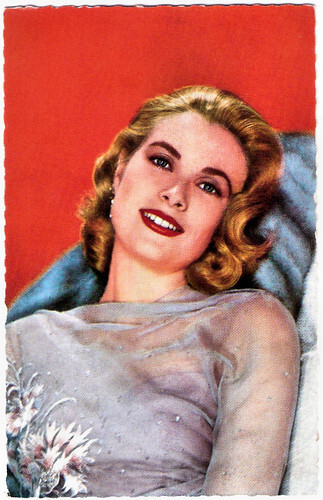
West-German postcard by Kolibri-Verlag G.m.b.H., Minden (Westf.), no. F 38. Photo: Metro-Goldwyn-Mayer (MGM). Grace Kelly in High Society (Charles Walters, 1956).
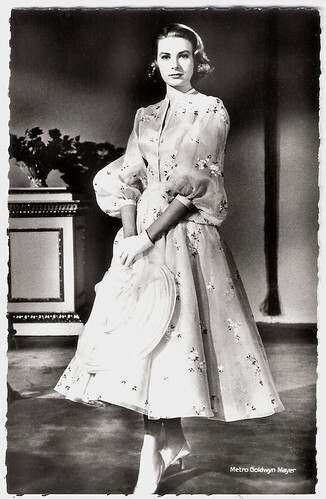
French postcard by Editions du Globe, Paris, no. 496. Photo: Virgil Apger / Metro Goldwyn Mayer. Key-set portrait from High Society (Charles Walters, 1956). Helen Rose designed the costumes. She also designed Grace Kelly 's wedding gown for her marriage to Prince Ranier.
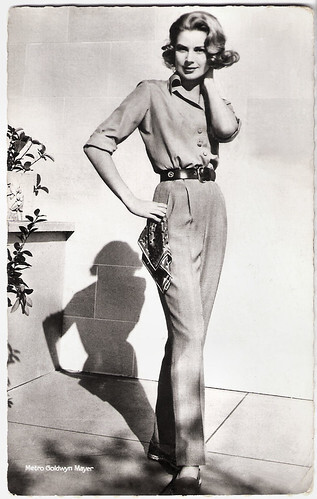
French postcard by Editions du Globe, Paris, no. 498. Photo: Virgil Apger / Metro Goldwyn Mayer. Key-set portrait from High Society (Charles Walters, 1956).
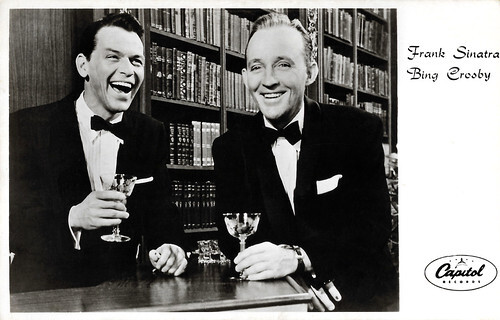
Dutch postcard by Editions Altona, Amsterdam / Gebr. Spanjersberg, Rotterdam, no. 5135. Photo: Capitol Records. Frank Sinatra and Bing Crosby in High Society (Charles Walters, 1956).
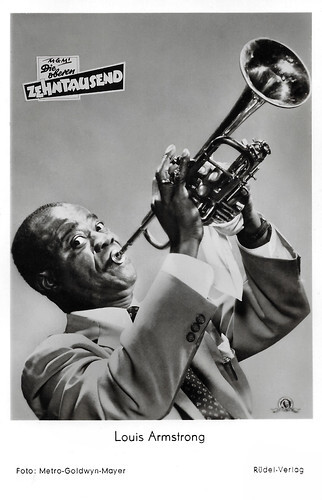
German postcard by Rüdel-Verlag, Hamburg-Bergedorf, no. 1988. Photo: MGM. Louis Armstrong in High Society (Charles Walters, 1956). The German title of the film is Die oberen Zehntausend.
A glossy Technicolor-and-VistaVision musical remake
High Society (Charles Walters, 1956) is a glossy Technicolor-and-VistaVision musical remake of George Cukor's classic The Philadelphia Story (1940), starring Katharine Hepburn , Cary Grant , and James Stewart . Both were based on Philip Barry's enormously successful stage 1939 comedy of manners.
Set amongst the rich and famous in Newport, RI, the story revolves around the wedding plans of spoiled heiress Tracy Lord ( Grace Kelly ). Tracy is all set to marry stuffy social climber George Kittridge (John Lund), while undercover Spy magazine reporter Mike Connor ( Frank Sinatra ) and photographer Liz Imbrie (Celeste Holm) intend to cover the ceremony.
Meanwhile, Tracy's ex-husband C.K. Dexter-Haven (Bing Crosby), a successful jazz musician who lives next door, also comes calling. Ostensibly, he is there to attend the annual Newport Jazz Festival, but actually, he wants to win Tracy back.
In the course of events, Mike falls in love with Tracy, and she with him. Tracy has to choose between the three men. The Jazz Festival subplot allows scriptwriter John Patrick to bring Louis Armstrong and his band into the proceedings.
Minus points are the casting of Crosby who appears old enough to be Kelly's grandfather ( Grace Kelly was 26, Bing Crosby was 53) and obviously misses the looks and the class of Cary Grant , and the fact that the more satiric aspects of Philip Barry's witty dialogue seem to have been sanded away. But we love these Cole Porter tunes like the Crosby-Sinatra duet 'Well, Did You Evah?,' the Crosby-Armstrong teaming 'Now You Has Jazz,' the Kelly-Crosby romantic ballad 'True Love,' and the Sinatra solo 'You're Sensational.'
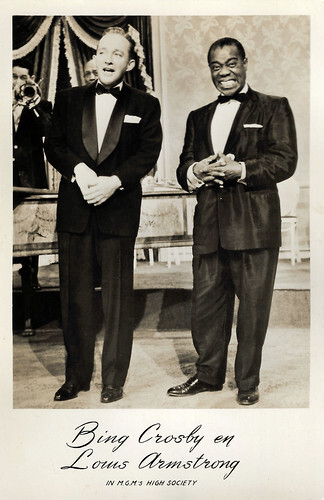
Dutch postcard by Uitg. Takken, Utrecht, no. 3014. Photo: MGM. Bing Crosby and Louis Armstrong in High Society (Charles Walters, 1956).
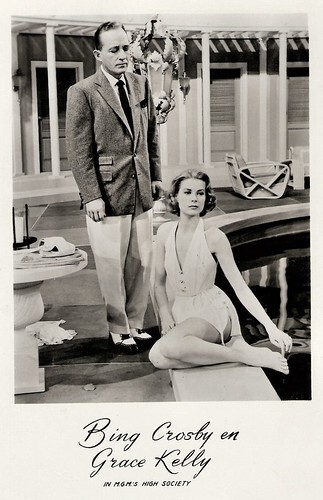
Dutch postcard by Uitg. Takken, Utrecht, no. 3015. Photo: MGM. Bing Crosby and Grace Kelly in High Society (Charles Walters, 1956).
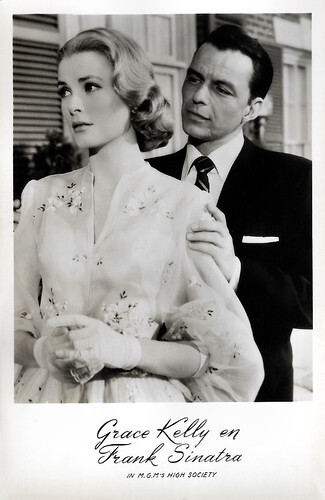
Dutch postcard by Uitg. Takken, Utrecht, no. 3016. Photo: MGM. Grace Kelly and Frank Sinatra in High Society (Charles Walters, 1956).
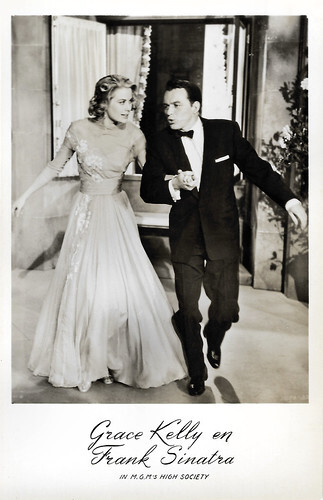
Dutch postcard by Uitg. Takken, Utrecht, no. 3017. Photo: MGM. Grace Kelly and Frank Sinatra in High Society (Charles Walters, 1956).
Sensational
Among the strong points of High Society (Charles Walters, 1956) are the songs. Producer Sol C. Siegel paid Cole Porter $250,000 for his first original film score in eight years. Louis Armstrong and his band get a couple of standout moments and Frank Sinatra and Bing Crosby collaborated for the first time. Behind the scenes, two master orchestrators – Conrad Salinger and Nelson Riddle – melded their arrangements under the baton of Johnny Green.
For Grace Kelly , High Society was her only musical. Though Tracy is the central character, Kelly does not sing a solo. She only accompanies Bing Crosby on 'True Love' and drunkenly shouts, 'Sensational'. Despite initial plans to dub her, Kelly sang her own part in 'True Love', which became a gold record.
Cole Porter wrote he song 'True Love' especially for the film. It became a million-seller and both Grace Kelly and Bing Crosby were awarded platinum records for the song. This is the only platinum record ever given to sitting royalty as Grace Kelly had become Princess Grace by the time it was awarded.
The song 'Well, Did You Evah?' came from a previous Cole Porter musical. It was originally performed by High Society's director) Charles Walters and Betty Grable in the 1939 Broadway musical 'DuBarry Was A Lady'. It was added at the last minute to High Society after the filmmakers realised that there wasn't a song for Bing Crosby and Frank Sinatra to sing together.
Although High Society is a remake of The Philadelphia Story, it is not set in Philadelphia. The setting was changed to Newport, Rhode Island, so the filmmakers could take advantage of the famous jazz festival held there.
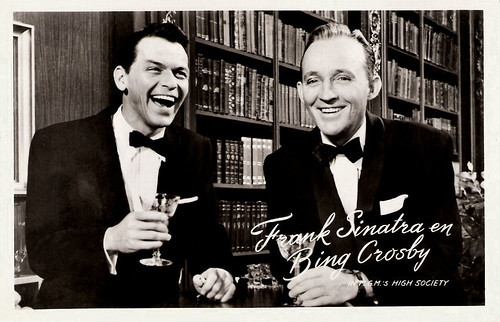
Dutch postcard by Uitg. Takken, Utrecht, no. 3020. Photo: MGM. Frank Sinatra and Bing Crosby in High Society (Charles Walters, 1956).
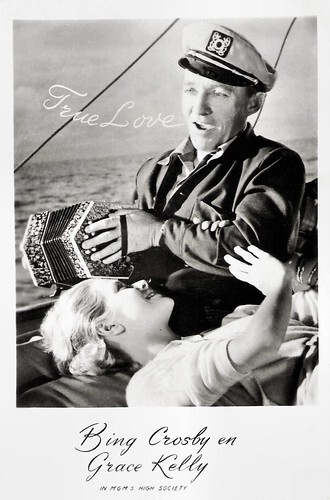
Dutch postcard by Uitg. Takken, Utrecht, no. 3021. Photo: Metro Goldwyn Mayer. Bing Crosby and Grace Kelly High Society (Charles Walters, 1956).
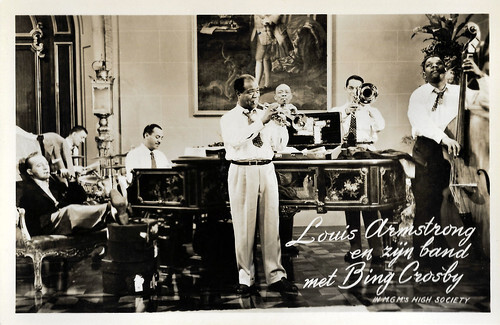
Dutch postcard by Uitg. Takken, Utrecht, no. 3022. Photo: MGM. Louis Armstrong and his band with Bing Crosby in High Society (Charles Walters, 1956).
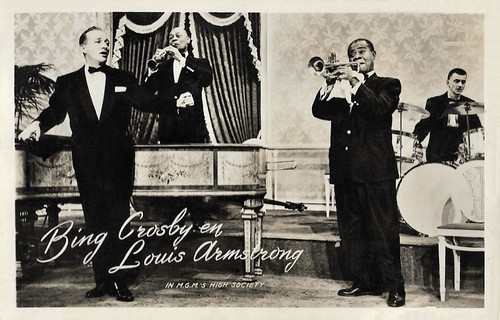
Dutch postcard by Uitg. Takken, Utrecht, no. 3024. Photo: MGM. Bing Crosby and Louis Armstrong in High Society (Charles Walters, 1956).
Sources: Hal Erickson (AllMovie), Michael Costello (AllMovie), Wikipedia and IMDb.

West-German postcard by Kolibri-Verlag G.m.b.H., Minden (Westf.), no. F 38. Photo: Metro-Goldwyn-Mayer (MGM). Grace Kelly in High Society (Charles Walters, 1956).

French postcard by Editions du Globe, Paris, no. 496. Photo: Virgil Apger / Metro Goldwyn Mayer. Key-set portrait from High Society (Charles Walters, 1956). Helen Rose designed the costumes. She also designed Grace Kelly 's wedding gown for her marriage to Prince Ranier.

French postcard by Editions du Globe, Paris, no. 498. Photo: Virgil Apger / Metro Goldwyn Mayer. Key-set portrait from High Society (Charles Walters, 1956).

Dutch postcard by Editions Altona, Amsterdam / Gebr. Spanjersberg, Rotterdam, no. 5135. Photo: Capitol Records. Frank Sinatra and Bing Crosby in High Society (Charles Walters, 1956).

German postcard by Rüdel-Verlag, Hamburg-Bergedorf, no. 1988. Photo: MGM. Louis Armstrong in High Society (Charles Walters, 1956). The German title of the film is Die oberen Zehntausend.
A glossy Technicolor-and-VistaVision musical remake
High Society (Charles Walters, 1956) is a glossy Technicolor-and-VistaVision musical remake of George Cukor's classic The Philadelphia Story (1940), starring Katharine Hepburn , Cary Grant , and James Stewart . Both were based on Philip Barry's enormously successful stage 1939 comedy of manners.
Set amongst the rich and famous in Newport, RI, the story revolves around the wedding plans of spoiled heiress Tracy Lord ( Grace Kelly ). Tracy is all set to marry stuffy social climber George Kittridge (John Lund), while undercover Spy magazine reporter Mike Connor ( Frank Sinatra ) and photographer Liz Imbrie (Celeste Holm) intend to cover the ceremony.
Meanwhile, Tracy's ex-husband C.K. Dexter-Haven (Bing Crosby), a successful jazz musician who lives next door, also comes calling. Ostensibly, he is there to attend the annual Newport Jazz Festival, but actually, he wants to win Tracy back.
In the course of events, Mike falls in love with Tracy, and she with him. Tracy has to choose between the three men. The Jazz Festival subplot allows scriptwriter John Patrick to bring Louis Armstrong and his band into the proceedings.
Minus points are the casting of Crosby who appears old enough to be Kelly's grandfather ( Grace Kelly was 26, Bing Crosby was 53) and obviously misses the looks and the class of Cary Grant , and the fact that the more satiric aspects of Philip Barry's witty dialogue seem to have been sanded away. But we love these Cole Porter tunes like the Crosby-Sinatra duet 'Well, Did You Evah?,' the Crosby-Armstrong teaming 'Now You Has Jazz,' the Kelly-Crosby romantic ballad 'True Love,' and the Sinatra solo 'You're Sensational.'

Dutch postcard by Uitg. Takken, Utrecht, no. 3014. Photo: MGM. Bing Crosby and Louis Armstrong in High Society (Charles Walters, 1956).

Dutch postcard by Uitg. Takken, Utrecht, no. 3015. Photo: MGM. Bing Crosby and Grace Kelly in High Society (Charles Walters, 1956).

Dutch postcard by Uitg. Takken, Utrecht, no. 3016. Photo: MGM. Grace Kelly and Frank Sinatra in High Society (Charles Walters, 1956).

Dutch postcard by Uitg. Takken, Utrecht, no. 3017. Photo: MGM. Grace Kelly and Frank Sinatra in High Society (Charles Walters, 1956).
Sensational
Among the strong points of High Society (Charles Walters, 1956) are the songs. Producer Sol C. Siegel paid Cole Porter $250,000 for his first original film score in eight years. Louis Armstrong and his band get a couple of standout moments and Frank Sinatra and Bing Crosby collaborated for the first time. Behind the scenes, two master orchestrators – Conrad Salinger and Nelson Riddle – melded their arrangements under the baton of Johnny Green.
For Grace Kelly , High Society was her only musical. Though Tracy is the central character, Kelly does not sing a solo. She only accompanies Bing Crosby on 'True Love' and drunkenly shouts, 'Sensational'. Despite initial plans to dub her, Kelly sang her own part in 'True Love', which became a gold record.
Cole Porter wrote he song 'True Love' especially for the film. It became a million-seller and both Grace Kelly and Bing Crosby were awarded platinum records for the song. This is the only platinum record ever given to sitting royalty as Grace Kelly had become Princess Grace by the time it was awarded.
The song 'Well, Did You Evah?' came from a previous Cole Porter musical. It was originally performed by High Society's director) Charles Walters and Betty Grable in the 1939 Broadway musical 'DuBarry Was A Lady'. It was added at the last minute to High Society after the filmmakers realised that there wasn't a song for Bing Crosby and Frank Sinatra to sing together.
Although High Society is a remake of The Philadelphia Story, it is not set in Philadelphia. The setting was changed to Newport, Rhode Island, so the filmmakers could take advantage of the famous jazz festival held there.

Dutch postcard by Uitg. Takken, Utrecht, no. 3020. Photo: MGM. Frank Sinatra and Bing Crosby in High Society (Charles Walters, 1956).

Dutch postcard by Uitg. Takken, Utrecht, no. 3021. Photo: Metro Goldwyn Mayer. Bing Crosby and Grace Kelly High Society (Charles Walters, 1956).

Dutch postcard by Uitg. Takken, Utrecht, no. 3022. Photo: MGM. Louis Armstrong and his band with Bing Crosby in High Society (Charles Walters, 1956).

Dutch postcard by Uitg. Takken, Utrecht, no. 3024. Photo: MGM. Bing Crosby and Louis Armstrong in High Society (Charles Walters, 1956).
Sources: Hal Erickson (AllMovie), Michael Costello (AllMovie), Wikipedia and IMDb.
Published on August 29, 2023 22:00
Paul van Yperen's Blog
- Paul van Yperen's profile
- 13 followers
Paul van Yperen isn't a Goodreads Author
(yet),
but they
do have a blog,
so here are some recent posts imported from
their feed.



